Abstract
Background
Different bone‐modifying agents like bisphosphonates and receptor activator of nuclear factor‐kappa B ligand (RANKL)‐inhibitors are used as supportive treatment in men with prostate cancer and bone metastases to prevent skeletal‐related events (SREs). SREs such as pathologic fractures, spinal cord compression, surgery and radiotherapy to the bone, and hypercalcemia lead to morbidity, a poor performance status, and impaired quality of life. Efficacy and acceptability of the bone‐targeted therapy is therefore of high relevance. Until now recommendations in guidelines on which bone‐modifying agents should be used are rare and inconsistent.
Objectives
To assess the effects of bisphosphonates and RANKL‐inhibitors as supportive treatment for prostate cancer patients with bone metastases and to generate a clinically meaningful treatment ranking according to their safety and efficacy using network meta‐analysis.
Search methods
We identified studies by electronically searching the bibliographic databases Cochrane Controlled Register of Trials (CENTRAL), MEDLINE, and Embase until 23 March 2020. We searched the Cochrane Library and various trial registries and screened abstracts of conference proceedings and reference lists of identified trials.
Selection criteria
We included randomized controlled trials comparing different bisphosphonates and RANKL‐inihibitors with each other or against no further treatment or placebo for men with prostate cancer and bone metastases. We included men with castration‐restrictive and castration‐sensitive prostate cancer and conducted subgroup analyses according to this criteria.
Data collection and analysis
Two review authors independently extracted data and assessed the quality of trials. We defined proportion of participants with pain response and the adverse events renal impairment and osteonecrosis of the jaw (ONJ) as the primary outcomes. Secondary outcomes were SREs in total and each separately (see above), mortality, quality of life, and further adverse events such as grade 3 to 4 adverse events, hypocalcemia, fatigue, diarrhea, and nausea. We conducted network meta‐analysis and generated treatment rankings for all outcomes, except quality of life due to insufficient reporting on this outcome. We compiled ranking plots to compare single outcomes of efficacy against outcomes of acceptability of the bone‐modifying agents. We assessed the certainty of the evidence for the main outcomes using the GRADE approach.
Main results
Twenty‐five trials fulfilled our inclusion criteria. Twenty‐one trials could be considered in the quantitative analysis, of which six bisphosphonates (zoledronic acid, risedronate, pamidronate, alendronate, etidronate, or clodronate) were compared with each other, the RANKL‐inhibitor denosumab, or no treatment/placebo. By conducting network meta‐analysis we were able to compare all of these reported agents directly and/or indirectly within the network for each outcome. In the abstract only the comparisons of zoledronic acid and denosumab against the main comparator (no treatment/placebo) are described for outcomes that were predefined as most relevant and that also appear in the 'Summary of findings' table. Other results, as well as results of subgroup analyses regarding castration status of participants, are displayed in the Results section of the full text.
Treatment with zoledronic acid probably neither reduces nor increases the proportion of participants with pain response when compared to no treatment/placebo (risk ratio (RR) 1.46, 95% confidence interval (CI) 0.93 to 2.32; per 1000 participants 121 more (19 less to 349 more); moderate‐certainty evidence; network based on 4 trials including 1013 participants). For this outcome none of the trials reported results for the comparison with denosumab.
The adverse event renal impairment probably occurs more often when treated with zoledronic acid compared to no treatment/placebo (RR 1.63, 95% CI 1.08 to 2.45; per 1000 participants 78 more (10 more to 180 more); moderate‐certainty evidence; network based on 6 trials including 1769 participants). Results for denosumab could not be included for this outcome, since zero events cannot be considered in the network meta‐analysis, therefore it does not appear in the ranking.
Treatment with denosumab results in increased occurrence of the adverse event ONJ (RR 3.45, 95% CI 1.06 to 11.24; per 1000 participants 30 more (1 more to 125 more); high‐certainty evidence; 4 trials, 3006 participants) compared to no treatment/placebo. When comparing zoledronic acid to no treatment/placebo, the confidence intervals include the possibility of benefit or harm, therefore treatment with zoledronic acid probably neither reduces nor increases ONJ (RR 1.88, 95% CI 0.73 to 4.87; per 1000 participants 11 more (3 less to 47 more); moderate‐certainty evidence; network based on 4 trials including 3006 participants).
Compared to no treatment/placebo, treatment with zoledronic acid (RR 0.84, 95% CI 0.72 to 0.97) and denosumab (RR 0.72, 95% CI 0.54 to 0.96) may result in a reduction of the total number of SREs (per 1000 participants 75 fewer (131 fewer to 14 fewer) and 131 fewer (215 fewer to 19 fewer); both low‐certainty evidence; 12 trials, 5240 participants).
Treatment with zoledronic acid and denosumab likely neither reduces nor increases mortality when compared to no treatment/placebo (zoledronic acid RR 0.90, 95% CI 0.80 to 1.01; per 1000 participants 48 fewer (97 fewer to 5 more); denosumab RR 0.93, 95% CI 0.77 to 1.11; per 1000 participants 34 fewer (111 fewer to 54 more); both moderate‐certainty evidence; 13 trials, 5494 participants).
Due to insufficient reporting, no network meta‐analysis was possible for the outcome quality of life. One study with 1904 participants comparing zoledronic acid and denosumab showed that more zoledronic acid‐treated participants than denosumab‐treated participants experienced a greater than or equal to five‐point decrease in Functional Assessment of Cancer Therapy‐General total scores over a range of 18 months (average relative difference = 6.8%, range −9.4% to 14.6%) or worsening of cancer‐related quality of life.
Authors' conclusions
When considering bone‐modifying agents as supportive treatment, one has to balance between efficacy and acceptability. Results suggest that Zoledronic acid likely increases both the proportion of participants with pain response, and the proportion of participants experiencing adverse events However, more trials with head‐to‐head comparisons including all potential agents are needed to draw the whole picture and proof the results of this analysis.
Keywords: Adult; Humans; Male; Alendronate; Alendronate/adverse effects; Alendronate/therapeutic use; Antineoplastic Agents, Hormonal; Antineoplastic Agents, Hormonal/therapeutic use; Bisphosphonate-Associated Osteonecrosis of the Jaw; Bisphosphonate-Associated Osteonecrosis of the Jaw/etiology; Bone Density Conservation Agents; Bone Density Conservation Agents/adverse effects; Bone Density Conservation Agents/therapeutic use; Bone Neoplasms; Bone Neoplasms/drug therapy; Bone Neoplasms/secondary; Clodronic Acid; Clodronic Acid/adverse effects; Clodronic Acid/therapeutic use; Denosumab; Denosumab/adverse effects; Denosumab/therapeutic use; Diphosphonates; Diphosphonates/adverse effects; Diphosphonates/therapeutic use; Etidronic Acid; Etidronic Acid/adverse effects; Etidronic Acid/therapeutic use; Network Meta-Analysis; Pamidronate; Pamidronate/adverse effects; Pamidronate/therapeutic use; Prostatic Neoplasms; Prostatic Neoplasms/drug therapy; Prostatic Neoplasms/pathology; Prostatic Neoplasms, Castration-Resistant; Prostatic Neoplasms, Castration-Resistant/pathology; Quality of Life; Randomized Controlled Trials as Topic; RANK Ligand; RANK Ligand/antagonists & inhibitors; Risedronic Acid; Risedronic Acid/adverse effects; Risedronic Acid/therapeutic use; Zoledronic Acid; Zoledronic Acid/adverse effects; Zoledronic Acid/therapeutic use
Plain language summary
Bone‐modifying agents for men with prostate cancer and bone metastases
Review question
In this systematic review we aimed to compare different agents to prevent skeletal complications in men with prostate cancer and bone metastases and to provide a ranking of these treatment options. We looked at different outcomes like reduction in pain, prevention of different skeletal‐related events, occurrence of adverse events, and quality of life. We wanted to find out which bone‐modifying agent is most effective while causing the fewest adverse events when given as supportive treatment to men with prostate cancer and bone metastases.
Background
The prostate is a gland in the male reproductive system. Prostate cancer can spread to other parts of the body (called metastases) including the bones. Bone metastases in men with prostate cancer may lead to skeletal complications like fractures or pain. Different bone‐modifying agents are used as supportive treatment to prevent skeletal complications through formation of new bone mass. Until now no clear recommendations could be given about which agents are the most effective while also causing the fewest adverse events. We used statistical methods to compare all agents with each other based on the available information.
Study characteristics
We conducted thorough searches in various databases until 23 March 2020. We included 25 studies comparing different bone‐modifying agents with each other or against no further treatment or placebo treatment (dummy treatment) in men with prostate cancer and bone metastases.
Key results
Twenty‐one of the 25 included studies reported data for our predefined patient‐relevant outcomes. A total of seven different agents were included, six bisphosphonates (zoledronic acid, risedronate, pamidronate, alendronate, etidronate, and clodronate) and one other agent, denosumab. Analysis was only possible for each outcome of interest separately. Considering skeletal‐related events, zoledronic acid and denosumab appeared to be the most effective, but also seemed to cause the most and worst adverse events (like renal impairment for treatment with zoledronic acid and osteonecrosis of the jaw for denosumab). Most of the included studies did not report data on quality of life or reported it very poorly, so that we could not analyse this outcome combining the information from different studies. The results were therefore described with words.
Certainty of the evidence
We rated the certainty of the evidence as high to low for the different agents and outcomes. A limitation of this review is that an overall ranking considering all outcomes at the same time is not possible. In order to make an informed decision about which treatment option should be used, one therefore must look at all the outcomes of interest and balance the pros and cons of each option.
Summary of findings
Summary of findings 1. Different bone‐modifying agents compared with each other and no treatment/placebo for men with prostate cancer and bone metastases.
| Different bone‐modifying agents compared with each other and no treatment/placebo for men with prostate cancer and bone metastases | |||
|
Patient or population: prostate cancer patients with bone metastases Setting: castration‐resistant and castration‐sensitive patients Intervention: zoledronic acid, denosumab Comparison: no treatment/placebo | |||
| Outcomes | Absolute effects and relative effects with 95% CIs. Main comparator: no treatment/placebo | ||
| Assumed risk with no treatment/placebo* | Corresponding risk with zoledronic acid | Corresponding risk with denosumab | |
|
Proportion of participants with pain response (network based on 4 studies including 1013 participants; follow‐up 5‐12 months) |
Response 265 per 1000 (26.5%) |
Response 386 per 1000 (246 to 614) |
‐ |
|
RR 1.46 (0.93 to 2.32) |
‐ | ||
| ⊕⊕⊕⊝ Moderate1 | ‐ | ||
|
Adverse event: renal impairment (network based on 6 studies including 1769 participants; follow‐up 5‐36 months) |
124 per 1000 (12.4%) |
202 per 1000 (134 to 304) |
‐ |
|
RR 1.63 (1.08 to 2.45) |
‐ | ||
| ⊕⊕⊕⊝ Moderate2 | ‐ | ||
|
Adverse event: osteonecrosis of the jaw (network based on 4 studies including 3006 participants; follow‐up 5‐24 months) |
12 per 1000 (1.2%) |
23 per 1000 (9 to 59) |
42 per 1000 (13 to 137) |
|
RR 1.88 (0.73 to 4.87) |
RR 3.45 (1.06 to 11.24) |
||
| ⊕⊕⊕⊝ Moderate1 | ⊕⊕⊕⊕ High | ||
|
Skeletal‐related events total (network based on 12 studies including 5240 participants; follow‐up 5‐60 months) |
468 per 1000 (46.8%) |
393 per 1000 (337 to 454) |
337 per 1000 (253 to 449) |
|
RR 0.84 (0.72 to 0.97) |
RR 0.72 (0.54 to 0.96) |
||
| ⊕⊕⊝⊝ Low2,3 | ⊕⊕⊝⊝ Low2,3 | ||
|
Mortality (network based on 13 studies including 5494 participants; follow‐up 12‐60 months) |
484 per 1000 (48.4%) |
436 per 1000 (387 to 489) |
450 per 1000 (373 to 538) |
|
RR 0.90 (0.80 to 1.01) |
RR 0.93 (0.77 to 1.11) |
||
| ⊕⊕⊕⊝ Moderate1 | ⊕⊕⊕⊝ Moderate1 | ||
|
Quality of life (narrative based on 1 study including 1904 participants) Assessed via Functional Assessment of Cancer Therapy‐General questionnaire, follow‐up 18 months) |
More zoledronic acid‐treated patients than denosumab‐treated patients experienced a greater than or equal to five‐point decrease in Functional Assessment of Cancer Therapy‐General total scores (average relative difference = 6.8%, range ‐9.4 to 14.6%) or worsening of cancer‐related quality of life | ||
| ⊕⊕⊕⊝ Moderate1 | |||
| *The basis for the assumed risk/response (e.g. the median control group risk/response across studies) was calculated from the included trials in the network of each outcome. The corresponding likelihood (and its 95% CI) is based on the assumed risk in the comparison group and the relative effect of the intervention (and its 95% CI). CI: confidence interval; RR: risk ratio | |||
| GRADE Working Group grades of evidence High certainty: Further research is very unlikely to change our confidence in the estimate of effect. Moderate certainty: Further research is likely to have an important impact on our confidence in the estimate of effect and may change the estimate. Low certainty: Further research is very likely to have an important impact on our confidence in the estimate of effect and is likely to change the estimate. Very low certainty: We are very uncertain about the estimate. | |||
1Downgraded 1 level for imprecision since 95% confidence interval wide and cross unity. 2Downgraded 1 level for inconsistency (heterogeneity) since prediction intervals compared to confidence intervals would change clinical decision (but not the ranking of treatment options). 3Downgraded 1 level for serious risk of bias, mostly regarding blinding. Downgraded if outcome of interest was considered subjective in these cases.
Background
Description of the condition
Prostate cancer is the second most commonly diagnosed form of cancer and the sixth‐leading cause of cancer‐related death among men worldwide (Jin 2011). Over the past few decades, improved early‐stage disease detection and advances in medical treatments have decreased the overall mortality rate of prostate cancer, but its metastatic progression has been found to be the major cause of prostate cancer‐associated morbidity and mortality (Thobe 2011). Researchers have shown that men with prostate cancer metastases have a 29.8% five‐year survival rate, as compared to 100% survival rate in men with localized or regional prostate cancer (Howlader 2013). Similar to other cancer diseases, prostate cancer can metastasize to organs like the liver, lungs, and brain, but it has a very high affinity for bone metastases, which was found to have 80% prevalence in men who have died from prostate cancer (Jin 2011). Bone metastasis affects quality of life: it is painful and causes pathological fractures, spinal cord compression, and high calcium levels in the blood (Coleman 1997). Androgen deprivation therapy (ADT), the mainstay of treatment for men with prostate cancer, has been reported to contribute to skeletal morbidity by causing an annual 3% to 5% decrease in bone mineral density, putting men at a higher risk for ADT‐induced osteoporosis and bone fractures (Sountoulides 2013). As a result, treatments that specifically target bone metastasis have been established and are being used as supplementary therapies to reduce or prevent the occurrence of skeletal‐related events.
Description of the intervention
Supportive treatments with bone‐modifying agents, such as bisphosphonates and receptor activator of nuclear factor‐kappa B ligand (RANKL)‐inhibitors are widely used to prevent bone resorption (Macherey 2017). When prostate cancer cells metastasize to bone, cancer cells produce parathyroid hormone‐related protein that stimulates the osteoblasts to produce RANKL, which in turn binds and activates the RANK receptor on osteoclast precursors, leading to their growth and maturation (Ramaswamy 2003). Osteoclasts are multinucleated cells of hematopoietic origin, capable of bone resorption, and play a major role in bone‐related conditions, such as rheumatoid arthritis, Paget's disease, and osteoporosis (Soysa 2012).
Bisphosphonates prevent osteoclastic bone resorption by inducing osteoclast apoptosis (Oades 2002). Recent studies have furthermore shown evidence supporting direct antitumor activity of bisphosphonates by inhibiting tumor self‐seeding, tumor‐associated angiogenesis, and recruitment of tumor‐associated macrophages to tumors (Clezardin 2013). In contrast, RANKL‐inhibitors work by binding to RANKL, effectively preventing it from binding to receptor activator of nuclear factor‐kappa B (RANK) in osteoclasts and osteoclast precursors, thus blocking the transduction pathway that stimulates osteoclast formation, activation, and survival (Gomez‐Veiga 2013). RANKL has also been shown to mediate increased invasion and migration of RANK‐expressing cancer cells, therefore pharmacological inhibition of RANKL not only prevents osteolysis but also reduces bone and lung metastasis (Dougall 2014).
Adverse events of the intervention
Skeletal‐related adverse events such as osteonecrosis of the jaw (ONJ), an adverse event directly mediated by bone remodeling inhibition, was reported in 0.1% of participants receiving bisphosphonates treatment and in 1.7% of participants receiving denosumab (RANKL‐inhibitor) treatment (Hellstein 2011; Qi 2014).
A number of non‐skeletal adverse events associated with the interventions have been reported to affect the gastrointestinal tract (Bartl 2007; Bartl 2008; Reyes 2016). Nausea, emesis, diarrhea, or gastric pain have been reported in 2% to 10% of men receiving bisphosphonates (Bartl 2008). Additionally, reported gastrointestinal complications include esophagitis, gastrointestinal bleeding, or ulcers (Bartl 2008; Reyes 2016). Other non‐skeletal adverse events caused by bisphosphonates and RANKL‐inhibitors include hypocalcemia and reduction of renal function (Bartl 2008; Gartrell 2014). In particular, intravenous administration of bisphosphonates has been reported to be associated with an increased risk of renal impairment and requires hemostasis of the patient's fluid balance (Bartl 2008). Furthermore, RANKL is a co‐stimulatory cytokine for T‐cell activation, and its inhibition with denosumab has been found to be associated with increased infection rates in men receiving the intervention (Anastasilakis 2009).
How the intervention might work
Over the past two decades, several randomized controlled trials and meta‐analyses have demonstrated the effectiveness of bisphosphonates in reducing bone pain and skeletal morbidity caused by breast cancer and multiple myeloma (Coleman 2008; Mhaskar 2017). The use of zoledronic acid has reduced the risk of skeletal complications by 30% to 50% (Neville‐Webbe 2010). This reduction was reported across a range of solid tumors affecting the bone, and as a result bisphosphonates are increasingly being used in parallel with specific anticancer treatments to prevent skeletal complications.
Bisphosphonates are analogues of pyrophosphate that are subgrouped to either amino‐bisphosphonates or non‐amino‐bisphosphonates, and target osteoclastic cells (Reyes 2016). Examples of amino‐bisphosphonates are zoledronic acid, risedronate, pamidronate, ibandronate, and alendronate. They affect the osteoclast metabolism by targeting the farnesyl diphosphate synthase, which is responsible for post‐translational modification of guanosine‐5'‐triphosphate‐binding proteins (Reyes 2016). The group of non‐amino‐bisphosphonates includes etidronate and clodronate. These substances function by forming an analogue of adenosine triphosphate. The resulting metabolite has toxic properties and induces apoptosis of osteoclasts (Reyes 2016). Both groups of bisphosphonates, amino‐ and non‐amino bisphosphonates, inhibit the effect of prostacyclines and cytokines in bone tissue and reduce the number of osteoclasts by down‐regulation of the reticuloendothelial system (Bartl 2007). They also bind hydroxyapatite in bone matrix (Gartrell 2015).
Denosumab, a fully humanized monoclonal antibody, functions by targeting and neutralizing RANKL, which has been found to be a major contributor to the progression of bone metastases (Hanley 2012). In a phase III clinical trial conducted for men with prostate cancer receiving ADT in parallel with 60 mg denosumab administered subcutaneously every six months, it was reported that participants had a 5.6% increase in bone mass density in the lumbar spine and a decreased incidence of 1.5% vertebral fractures when compared to the placebo group, which had a 3.9% incidence rate (Smith 2009a). Similarly, a phase III clinical trial of participants with metastatic castration‐resistant prostate cancer receiving 120 mg denosumab administered subcutaneously every four weeks showed that denosumab treatment could significantly lower the risk of developing symptomatic skeletal events, in addition to reducing bone turnover markers (Fizazi 2011). These findings have led to the approval of denosumab by both the US Food and Drug Adminstration (FDA) and European Medicines Agency (EMA) to be used as an osteoprotective agent for the treatment of ADT‐induced osteoporosis (Hegemann 2017).
Why it is important to do this review
Although bone‐targeted therapy is common in men with prostate cancer at risk of skeletal complications, recommendations in current guidelines are rare and inconsistent. Guidelines from the European Association of Urology (EAU) and the German Guideline Program in Oncology (GGPO) recommend the use of zoledronic acid (bisphosphonate) or the RANKL‐inhibitor denosumab in men with advanced, relapsed, or castration‐resistant prostate cancer, without evidence to demonstrate greater efficacy of one drug over another (Mottet 2017). Guidelines from the European Society of Medical Oncology (ESMO) and Cancer Care Ontario (CCO) suggest denosumab or zoledronic acid for men with bone metastases from castration‐resistant prostate carcinoma at high risk for clinically relevant skeletal‐related events (Alibhai 2017; Parker 2015). Neither the National Comprehensive Cancer Network (NCCN) nor the European Organisation for Research and Treatment of Cancer (EORTC) offers strong, evidence‐based recommendations to use denosumab or bisphosphonates for preventing skeletal‐related events in men with prostate cancer (Fitzpatrick 2014; Mohler 2019). Despite extensive research efforts in the field, sufficient evidence from randomized head‐to‐head comparisons of the efficacy of various types of bisphosphonates or compared to RANKL‐inhibitors is lacking. This review therefore aimed to provide the highest level of evidence for treatment decisions and a hierarchy of treatment options via a network meta‐analysis that summarizes the direct and indirect evidence.
Objectives
To assess the effects of bisphosphonates and RANKL‐inhibitors as supportive treatment for prostate cancer patients with bone metastases and to generate a clinically meaningful treatment ranking according to their safety and efficacy using network meta‐analysis.
Methods
Criteria for considering studies for this review
Types of studies
We included randomized controlled trials (RCTs) that were full journal publications, with the exception of online clinical trial results and summaries of otherwise unpublished clinical trials and abstracts with sufficient data for analysis. In the case of cross‐over trials, we would only analyze the first period of the trial; however, we did not identify any cross‐over trials. There was no limitation with respect to the length of follow‐up. Studies were included regardless of their publication status or language of publication. We excluded studies that were non‐randomized, case reports, or clinical observations.
Types of participants
We included studies involving adult participants according to the definition in the studies (usually ≥ 18 years of age), with a confirmed diagnosis of prostate cancer and bone metastases, irrespective of stage of disease or type of therapy. We included studies in the analysis involving both hormone‐sensitive and castrate‐refractory participants receiving either bisphosphonates or RANKL‐inhibitors.
If we identified studies in which only a subset of participants was relevant to this review, we would include such studies if data were available separately for the relevant subset.
Types of interventions
We included trials comparing bisphosphonates or RANKL‐inhibitors versus control regimens for the treatment of bone metastases from prostate cancer. We considered any type of bisphosphonate or RANKL‐inhibitor, apart from radioactive bisphosphonates. We did not impose any restriction on the dose, route, frequency, or duration of bisphosphonate treatment, nor on the duration of follow‐up. We investigated the following comparisons of experimental interventions versus comparator interventions. Concomitant interventions had to be the same in the experimental and comparator groups to establish fair comparisons.
Experimental interventions
Bisphosphonates
RANKL‐inhibitors
Comparator interventions
Bisphosphonates
RANKL‐inhibitors
No treatment/placebo
Comparisons
Bisphosphonates versus no treatment/placebo
RANKL‐inhibitors versus no treatment/placebo
Bisphosphonates versus RANKL‐inhibitors
Bisphosphonate A versus bisphosphonate B
RANKL‐inhibitor A versus RANKL‐inhibitor B
We compared combinations of these interventions at any dose and by any route to each other in a full network meta‐analysis. We included all RCTs comparing at least two study arms for the intervention of interest, either bisphosphonates with no treatment/placebo, RANKL‐inhibitors with no treatment/placebo, or bisphosphonates with RANKL‐inhibitors, for a full network of direct and indirect comparisons (for ideal network see Figure 1). Participants who fulfilled the inclusion criteria were, in principle, equally likely to be randomized to any of the eligible interventions.
1.
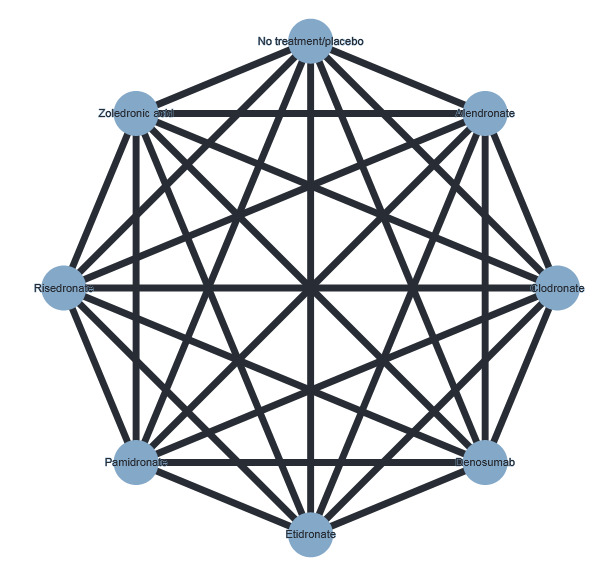
Ideal network diagram of all comparisons.
Types of outcome measures
We included all trials meeting the inclusion criteria mentioned above, irrespective of reported outcomes. We estimated the relative ranking of the competing interventions according to each of the following outcomes.
Primary outcomes
Proportion of participants with pain response. We considered all trials reporting on the proportion of participants with pain response. We did not impose restrictions on pain assessment tools or the definition of pain response in the trials. We defined pain response as a reduction in pain scores as defined in the trials (see Effects of interventions under Primary outcome: proportion of participants with pain response; Network meta‐analysis).
-
Adverse events
Renal impairment. We considered all trials reporting renal adverse events. As drugs might be described with nephrotoxicity with variable expression, we considered creatinine elevation and renal failure as renal adverse events.
Osteonecrosis of the jaw
Secondary outcomes
-
Skeletal‐related events (SREs) as reported by the study authors with or without hypercalcemia
Total number of SREs
Pathological fractures
Spinal cord compression
Bone radiotherapy
Bone surgery
Hypercalcemia
Overall survival/mortality. We were unable to retrieve the necessary information to analyze the time‐to‐event outcome overall survival, so we assessed the number of events per total for the dichotomized outcome mortality.
Quality of life
-
Further adverse events
Grade 3 to 4 adverse events overall
Hypocalcemia
Fatigue
Diarrhea
Nausea
Method and timing of outcome measurement
Proportion of participants with pain response: assessed using validated generic and disease‐specific questionnaires; measured at baseline, six months, one year, two years, or at the longest reported follow‐up.
Adverse events (renal adverse events, osteonecrosis of the jaw, and further adverse events): grade 3 and 4 according to the Common Terminology Criteria for Adverse Events (CTCAE) or as defined in the trial, measured at any time after participants were randomized to intervention/comparator groups.
Skeletal‐related events: combined outcome evaluating pathological fractures (in total), spinal cord compression, bone radiotherapy, bone surgery, and hypercalcemia if defined as an SRE in the trial at any time after participants were randomized to intervention/comparator groups.
Mortality: defined as the time from randomization to the date of death. Since we were unable to retrieve the necessary information to analyze time‐to‐event outcomes, we assessed the number of events per treatment group for these outcomes at six months, one year, two years, or at the longest reported follow‐up.
Quality of life: assessed using validated generic and disease‐specific questionnaires; measured at baseline, six months, one year, two years, or at the longest reported follow‐up.
We compared and analyzed each of these measures separately. To determine the validity of data synthesis across separate studies, we extracted definitions used by each study to describe all outcomes of interest.
Main outcomes for 'Summary of findings' table
We presented a 'Summary of findings' table reporting the following outcomes, listed according to priority.
Proportion of participants with pain response
Adverse events: renal impairment
Adverse event: osteonecrosis of the jaw (ONJ)
Total number of SREs
Overall survival/mortality
Quality of life
Search methods for identification of studies
We ran a comprehensive search with no restrictions on language of publication or publication status. We ran searches in Embase, MEDLINE and CENTRAL until 23 March 2020, which was within three months prior to anticipated publication of the review. We included all studies meeting our inclusion criteria in the analyses.
Electronic searches
We searched the following databases from their inception.
-
Cochrane Library (until 23 March 2020) (via Wiley.com; see Appendix 1)
Cochrane Database of Systematic Reviews (CDSR)
Cochrane Central Register of Controlled Trials (CENTRAL)
Database of Abstracts of Reviews of Effects (DARE)
MEDLINE (via Ovid, 1946 to 23 March 2020) (see Appendix 2)
Embase (via Ovid, 1988 to 23 March 2020) (see Appendix 3)
We searched the following trial registers (23 March 2020).
World Health Organization (WHO) International Clinical Trials Registry Platform (ICTRP) (who.int/trialsearch)
EU Clinical Trials Register (www.clinicaltrialsregister.eu)
US National Institutes of Health Ongoing Trials Register ClinicalTrials.gov (www.clinicaltrials.gov/)
UMIN clinical trial registration (www.umin.ac.jp)
We used medical subject headings (MeSH) or equivalent and text word terms. We did not impose any language restrictions. We tailored searches to individual databases.
Searching other resources
We attempted to identify other potentially eligible trials or ancillary publications by searching the reference lists of retrieved included trials, reviews, meta‐analyses and health technology assessment reports. We also contacted the authors of included trials to identify any further studies that we may have missed. We contacted drug/device manufacturers for ongoing or unpublished trials. We also contacted experts in the field in an effort to identify further trials.
We searched abstract proceedings of relevant meetings of the last five years (2013 to 2018) if they were not included in CENTRAL.
American Society of Clinical Oncology (ASCO)
European Society of Medical Oncology (ESMO)
Multinational Association of Supportive Care in Cancer (MASCC)
Data collection and analysis
Selection of studies
Two review authors (TJ, YMT) independently screened the results of the search strategies for potential eligibility by reading the abstracts. We coded the abstracts as either 'retrieve' or 'do not retrieve' (the latter in the case of studies that clearly did not satisfy the inclusion criteria). We obtained the full‐text publications for those abstracts coded as 'retrieve,' and two review authors (TJ, YMT) independently evaluated the full texts for inclusion in the review. In the case of disagreement a third review author (NS or AH) was consulted. The studies were not anonymized in any way before assessment. A PRISMA flow chart shows the status of identified studies (see Figure 2), as recommended in Part 2, Section 11.2.1 of the Cochrane Handbook for Systematic Reviews of Interventions (Moher 2009; Schünemann 2011a). We included studies in the review irrespective of whether measured outcome data were reported in a 'useable' way. We used reference management software to identify and remove potentially duplicate records. We documented reasons for the exclusion of studies that may have reasonably been expected to be included in the review in a 'Characteristics of excluded studies' table.
2.
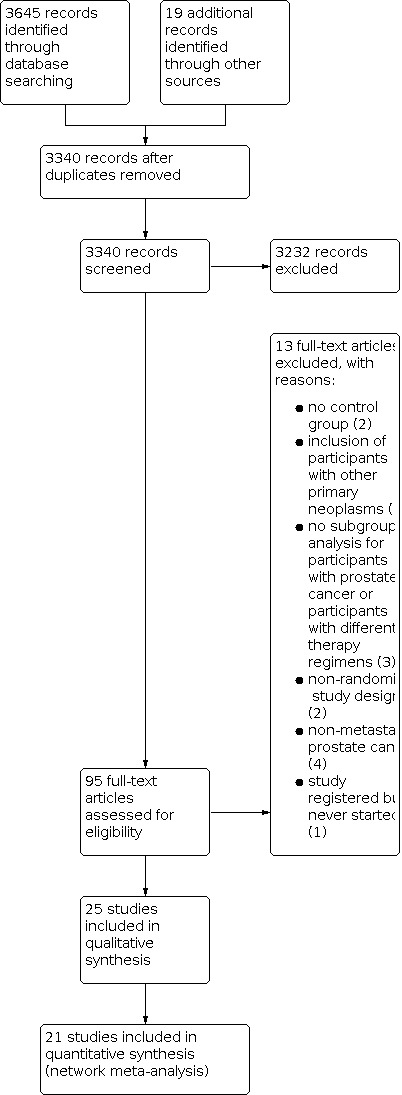
Study flow diagram.
Data extraction and management
Two review authors (TJ, YMT) independently extracted data using a standardized data extraction form that was piloted for two included trials and adapted as necessary. If the two review authors were unable to reach a consensus, a third review author (NS) was consulted for final decision. If required, we contacted authors of individual studies for additional information.
After agreement we entered data into Review Manager 5 (Review Manager 2014). We extracted the following information.
General information: author, title, source, publication date, country, language, duplicate publications.
Quality assessment: sequence generation, allocation concealment, blinding (participants, personnel, outcome assessors), incomplete outcome data, selective outcome reporting, other sources of bias.
Study characteristics: trial design, aims, setting and dates, source of participants, inclusion/exclusion criteria, comparability of groups, subgroup analysis, statistical methods, compliance with assigned treatment, length of follow‐up, time point of randomization.
Participant characteristics: participant details, baseline demographics, age, ethnicity, number of participants recruited/allocated/evaluated, participants lost to follow‐up, cancer type and stage, additional diagnoses, type and intensity of pain, skeletal‐related events risk.
Interventions: type and dosage of drugs used, route, frequency, duration of treatment, duration of follow‐up.
Outcomes: proportion of participants with pain response, renal adverse events, adverse event (osteonecrosis of the jaw), total number of skeletal‐related events and SREs separately, overall survival/mortality, quality of life, other adverse events; we extracted data at the arm level, not summary effects.
Notes: sponsorship/funding for trial and notable conflicts of interest of study authors.
We collected multiple reports of the same study, so that each study, rather than each report, was the unit of interest in the review. We collected characteristics of the included studies in sufficient detail to populate a 'Characteristics of included studies' table.
We extracted outcome data relevant to this Cochrane Review, as needed for calculation of summary statistics and measures of variance. For dichotomous outcomes, we attempted to obtain the numbers of events and totals for population of a two‐by‐two table, as well as summary statistics with corresponding measures of variance. For continuous outcomes, we attempted to obtain means and standard deviations or data necessary to calculate this information. We provided information, including trial identifier, about potentially relevant ongoing studies in the 'Characteristics of ongoing studies' table.
Data on potential effect modifiers
We extracted the following information that could act as effect modifiers from each included study.
Year of publication
Type of anticancer drug used for treatment
Dealing with duplicate and companion publications
In the event of duplicate publications, companion documents, or multiple reports of a primary study, we maximized yield of information by mapping all publications to unique studies and collating all available data. We used the most complete data set aggregated across all known publications. If in doubt, we gave priority to the publication reporting the longest follow‐up associated with our primary or secondary outcomes.
Assessment of risk of bias in included studies
We completed a 'Risk of bias' table for each included study using the 'Risk of bias' tool in Review Manager 5 (Review Manager 2014). Two review authors (TJ, YMT) independently assessed the risk of bias for each study, consulting a third review author (NS) for a final decision if necessary. We assessed whether the trials met the criteria for the following 'Risk of bias' domains as outlined in Chapter 8 of the Cochrane Handbook for Systematic Reviews of Interventions (Higgins 2011b). If a domain did not fit the trial for which risk of bias was being judged, it was left empty.
Sequence generation
Allocation concealment
Blinding (participants, personnel, outcome assessors)
Incomplete outcome data
Selective outcome reporting
Other sources of bias
We made a judgement for each domain, using one of the following categories.
'Low risk': if the criteria are adequately fulfilled in the study (i.e. the study is at low risk of bias for the given domain).
'High risk': if the criteria are not fulfilled in the study (i.e. the study is at high risk of bias for the given domain).
'Unclear': if the study report does not provide sufficient information to allow a clear judgement, or if risk of bias is unknown for a given domain.
For performance bias (blinding of participants and personnel) and detection bias (blinding of outcome assessment), we evaluated the risk of bias separately for each outcome, and grouped outcomes according to whether they were measured subjectively or objectively when reporting our findings in the 'Risk of bias' tables.
We also assessed attrition bias (incomplete outcome data) on an outcome‐specific basis, and presented the judgement for each outcome separately when reporting our findings in the 'Risk of bias' tables.
We further summarized the risk of bias across domains for each outcome in each included study, as well as across studies and domains for each outcome, in accordance with the approach for summary assessments of risk of bias presented in the Cochrane Handbook for Systematic Reviews of Interventions (Higgins 2011a). In sensitivity analyses, we compared trials with at least two criteria assessed as being at high risk of bias with those with no or only one criterion at high risk of bias.
We decided to group our outcomes into three categories as follows in order to make our 'Risk of bias' judgement more plausible.
-
Objective outcomes, meaning these are not influenced by blinding
Adverse event: renal impairment
Adverse event: osteonecrosis of the jaw
Total number of SREs*
SRE: pathological fractures
SRE: spinal cord compression
SRE: hypercalcemia
Overall survival/mortality
Grade 3 to 4 adverse events*
Adverse event: hypocalcemia
-
Outcomes subjective to assessor
Total number of SREs*
SRE: radiotherapy
SRE: surgery
-
Outcomes subjective to participant
Proportion of participants with pain response
Quality of life
Grade 3 to 4 adverse events*
Adverse event: fatigue
Adverse event: diarrhea
Adverse event: nausea
*Total number of SREs and grade 3 to 4 adverse events are each mentioned in double since they are comprised of different outcomes of which some can be judged as objective, subjective to assessor, or subjective to participant.
Measures of treatment effect
Relative treatment effect
We used intention‐to‐treat data. For binary outcomes, we used risk ratios (RRs) with 95% confidence intervals (CIs) as the measure of treatment effect. We calculated continuous outcomes as mean differences (MDs) with 95% CI. In case we had found continuous outcomes measured with different instruments we would have used standardized mean differences (SMD) with 95% CI. If participant‐related outcomes were reported both as binary and continuous outcomes, we would analyze binary outcomes in one analysis and continuous outcomes in another analysis. For time‐to‐event outcomes, we planned to use hazard ratios (HRs) and their 95% CIs and to extract data from publications according to Parmar 1998 and Tierney 2007. In addition to pooled estimates with CIs, we reported prediction intervals.
Relative treatment ranking
We obtained a treatment hierarchy using P‐scores (Rücker 2015) for all outcomes for which network meta‐analysis was possible. P‐scores allow ranking treatments on a continuous 0‐to‐1 scale in a frequentist network meta‐analysis; scores close to 0 intend the worst treatment options, while scores close to 1 intend the best treatment options.
Unit of analysis issues
The unit of analysis was the individual participant. If the authors did not report the number of participants with a respective adverse event, but rather the number of the occurrence of a certain adverse event in general, we did not consider these data in our analysis.
Studies with multiple treatment groups
As recommended in Chapter 16 of the Cochrane Handbook for Systematic Reviews of Interventions (Higgins 2011c), for studies with multiple treatment groups we combined arms, as long as they could be regarded as subtypes of the same intervention.
When arms could not be pooled this way, we included multiarm trials using a network meta‐analysis approach that accounts for the within‐study correlation between the effect sizes by re‐weighting all comparisons of each multiarm study (Rücker 2012; Rücker 2014). For pairwise meta‐analysis, we treated multiarm studies as multiple independent comparisons and did not combine these data in any analysis. Since pairwise comparisons for bisphosphonates were reported elsewhere, here we only reported pairwise meta‐analysis for RANKL‐inhibitors compared to no treatment/placebo. For this purpose, for dichotomous outcomes, we divided up both the number of events and the total number of participants. For network meta‐analysis, instead of subdividing the common comparator, we used an approach that accounts for the within‐study correlation between the effect sizes by re‐weighting all comparisons of each multiple‐arm study (Rücker 2012; Rücker 2014).
Dealing with missing data
As suggested in Chapter 16 of the Cochrane Handbook for Systematic Reviews of Interventions (Higgins 2011c), we took the following steps to deal with missing data.
If the number of participants evaluated for a given outcome was not reported, we used the number of participants randomized per treatment arm as the denominator. If only percentages, but no absolute number of events, were reported for binary outcomes, we calculated numerators using percentages. If estimates for mean and standard deviations were missing, we calculated these statistics from reported data whenever possible, using the approaches described in Chapter 7 of the Cochrane Handbook for Systematic Reviews of Interventions (Higgins 2011d). If standard deviations were missing and we were not able to calculate them from reported data, we calculated values according to a validated imputation method (Furukawa 2006). If data were not reported numerically but graphically, we estimated missing data from figures. We performed sensitivity analyses to assess how sensitive results were to imputing data in some way. We addressed the potential impact of missing data on the findings of the review in the Discussion section.
Assessment of heterogeneity
Pairwise meta‐analyses
For each direct comparison, we used visual inspection of the forest plots as well as Cochran's Q based on a Chi2 statistic and the I2 statistic in order to detect the presence of heterogeneity. We interpreted I2 values according to Chapter 9 of the Cochrane Handbook for Systematic Reviews of Interventions (Deeks 2011), as follows.
0% to 40% may not be important.
30% to 60% represents moderate heterogeneity.
50% to 90% represents substantial heterogeneity.
75% to 100% represents considerable heterogeneity.
We used the P value of the Chi2 test only for describing the extent of heterogeneity and not for determining statistical significance. In addition, we reported Tau2, the between‐study variance in random‐effects meta‐analysis. When we found heterogeneity, we attempted to determine possible reasons for it by examining individual study and subgroup characteristics. In the event of excessive heterogeneity that was unexplained by subgroup analyses, we did not report outcome results as the pooled effect estimate in a meta‐analysis, but provided a narrative description of the results of each study.
Network meta‐analysis
A very important presupposition for using network meta‐analysis is to make sure that the network is consistent, meaning that direct and indirect evidence on the same comparisons agree. Inconsistency can be caused by incomparable inclusion and exclusion criteria of the trials in the network.
We evaluated the assumption of transitivity epidemiologically by comparing the distribution of the potential effect modifiers across the different pairwise comparisons. We extracted important clinical and methodological characteristics of each included study in the 'Characteristics of included studies' table. We visually inspected the similarity of these factors, including the inclusion and exclusion criteria of every trial in the network.
To evaluate the presence of inconsistency locally, we compared direct and indirect treatment estimates of each treatment comparison. This can serve as a check for consistency of a network meta‐analysis (Dias 2010). For this purpose, we used the 'netsplit' command in the R package netmeta, which enables the splitting of the network evidence into direct and indirect contributions (Netmeta 2017; R 2017). For each treatment comparison, we presented direct and indirect treatment estimates plus the network estimate using forest plots. In addition, for each comparison we reported the P value of the test for disagreement (direct versus indirect). It should be noted that in a network of evidence there may be many loops, and with multiple testing there is an increased likelihood that we might find an inconsistent loop by chance. We were therefore cautious in deriving conclusions from this approach.
To evaluate the presence of inconsistency in the entire network, we gave the generalized heterogeneity statistic Qtotal and the generalized I2 statistic, as described in Schwarzer 2015. We used the 'decomp.design' command in the R package netmeta for decomposition of the heterogeneity statistic into a Q statistic for assessing the heterogeneity between studies with the same design, and a Q statistic for assessing design inconsistency to identify the amount of heterogeneity/inconsistency within, as well as between, designs (Netmeta 2017; R 2017). Furthermore, we created a net heat plot (Krahn 2013), a graphical tool for locating inconsistency in network meta‐analysis, using the command 'netheat' in the R package netmeta (Netmeta 2017). We used Qtotal and its components as well as netheat plots based on fixed‐effect and random‐effects models to identify differences between these approaches. For random‐effects models, we reported Tau2, which describes the between‐study variance.
If we found substantive heterogeneity or inconsistency, or both, we explored possible sources by performing prespecified sensitivity analyses (see Sensitivity analysis). In addition, we reviewed the evidence base, reconsidered inclusion criteria, and discussed the potential role of unmeasured effect modifiers to identify further sources.
In order to present the best treatment options regarding efficacy and acceptability, we presented ranking plots. Performing network meta‐analysis, a ranking of treatment options is only possible for each outcome separately. By presenting ranking plots, two outcomes can be analyzed together. We therefore chose the total number of SREs to express efficacy and several adverse event outcomes individually to express acceptability. The results are shown in ranking plots and related leaguetables.
Assessment of reporting biases
In pairwise comparisons with at least 10 trials, we planned to examine the presence of small‐study effects graphically by generating funnel plots. We planned to use linear regression tests to test for funnel plot asymmetry (Egger 1997). We planned to consider a P value less than 0.1 to be significant for this test (Sterne 2011). We planned to examine the presence of small‐study effects for the primary outcomes only. Moreover, we searched study registries to identify completed but not published trials.
Data synthesis
Methods for direct treatment comparisons
We performed analyses according to recommendations in Chapter 9 of the Cochrane Handbook for Systematic Reviews of Interventions (Deeks 2011), and used Review Manager 5 and R for analyses (R 2017; Review Manager 2014).
Pairwise comparisons are part of the network meta‐analysis. However, in order to outline the available direct evidence, we provided forest plots for pairwise comparisons if these were not already reported elsewhere (Macherey 2017), and trials were clinically homogenous. We performed these standard pairwise meta‐analyses using a random‐effects model. We calculated corresponding 95% CIs as well as 95% prediction intervals for all analyses, and graphically presented the results using forest plots. When trials were clinically too heterogenous to be combined, we performed only subgroup analyses without calculating an overall estimate.
Methods for indirect and mixed comparisons
If we considered the data to be sufficiently similar to be combined, we performed a network meta‐analysis for all outcomes for which two or more studies reported data using the frequentist weighted least‐squared approach described by Rücker 2012, employing the random‐effects model. Studies for which zero events were reported in both the intervention and the control group for an outcome could not be considered in the network meta‐analysis. We used a random‐effects model, taking into account the correlated treatment effects in multiarm studies. We assumed a common estimate for the heterogeneity variance across the different comparisons. To evaluate the extent to which treatments were connected, we present network graphs for our primary and secondary outcomes, which we generated using CINeMA software (Nikolakopoulou 2020). For each comparison, we gave the estimated treatment effect along with its 95% CI and 95% prediction interval. We graphically presented the results using forest plots, with placebo/no treatment as reference. We used the R package netmeta for statistical analyses (Netmeta 2017; R 2017).
We presented the results in leaguetables in which treatment‐ranking by P‐scores as well as network estimates with 95% CIs are given.
P‐scores allow the ranking of treatments on a continuous 0‐to‐1 scale in a frequentist network meta‐analysis. P‐scores are based solely on the point estimates and standard errors of the network estimates and measure the degree of certainty that one treatment is better than another treatment, averaged over all competing treatments (Rücker 2015). The P‐score of the treatment can be interpreted as the median degree of certainty that one treatment is better than the other.
In leaguetables different treatments options are ranked as indicated by arrows in the graph from top: greater chance of being the best treatment (higher P‐scores) to bottom: lower chance of being the best treatment (lower P‐score). Leaguetables also show the network estimates with 95% CIs of every treatment option compared to every other treatment option.
In order to get an idea of best efficacy and best acceptability of treatment options at one time, ranking plots were introduced simultaneously representing one outcome of the efficacy (x axis, e.g. total number of SREs) and one outcome of acceptability (y axis, e.g. adverse event renal impairment, ONJ, grade 3 to 4 adverse events, or hypocalcemia). Optimal treatment should be characterized by both high efficacy and acceptability and should be in the right upper corner of the resulting graphs. Only studies reporting both efficacy (total numbers of SREs) and acceptability (adverse event renal impairment) were considered in the ranking plots. Studies only reporting one of the two were not included in the statistical analysis for these plots.
GRADE
Certainty of the evidence
Two review authors (TJ, NS) independently rated the certainty of the evidence of each network estimate for each outcome shown in the 'Summary of findings' table. We used the GRADE approach to rank the certainty of the evidence using GRADEpro GDT software (GRADEpro GDT 2015), as well as the guidelines provided in Chapter 12 of the CochraneHandbook for Systematic Reviews of Interventions (Schünemann 2011b), and specifically for network meta‐analyses (Puhan 2014; Salanti 2014).
The GRADE approach uses five considerations (study limitations, consistency of effect, imprecision, indirectness, and publication bias) to assess the certainty of the body of evidence for each outcome. The GRADE system uses the following criteria for assigning certainty of evidence.
High certainty: we are very confident that the true effect lies close to that of the estimate of the effect.
Moderate certainty: we are moderately confident in the effect estimate: the true effect is likely to be close to the estimate of effect, but there is a possibility that it is substantially different.
Low certainty: our confidence in the effect estimate is limited: the true effect may be substantially different from the estimate of the effect.
Very low certainty: we have very little confidence in the effect estimate: the true effect is likely to be substantially different from the estimate of effect.
The GRADE system uses the following criteria for assigning a certainty level to a body of evidence (Schünemann 2011b).
High: randomized trials; or double‐upgraded observational studies.
Moderate: downgraded randomized trials; or upgraded observational studies.
Low: double‐downgraded randomized trials; or observational studies.
Very low: triple‐downgraded randomized trials; or downgraded observational studies; or case series/case reports.
We decreased the certainty level if we found:
serious (−1) or very serious (−2) limitation to study quality;
important inconsistency (−1);
some (−1) or major (−2) uncertainty about directness;
imprecise or sparse data (−1);
high probability of reporting bias (−1).
'Summary of findings' table
We included one 'Summary of findings' table to present the main findings in a transparent and simple tabular format. As stated above we included the main outcomes: proportion of participants with pain response, adverse events renal impairment and ONJ, total number of SREs, mortality, and quality of life. We included the two most relevant treatment options in the 'Summary of findings' table. In particular, we included key information concerning the certainty of the evidence, the magnitude of effect of the interventions examined, and the sum of available data on the outcomes mentioned above. We adapted the table, which was created using GRADEpro GDT (GRADEpro GDT 2015), to comply with the results of the network meta‐analysis. In case data were too heterogenous for network meta‐analysis or network meta‐analysis was not possible, we presented results narratively.
Subgroup analysis and investigation of heterogeneity
We planned on conducting subgroup analysis for the following comparisons: participant age (due to age‐related decreases in bone marrow density); tumor status and grading of the cohorts (according to the TNM‐staging system referring to tumor size, node‐involvement and existence of metastases); castration resistance or sensitivity of maligancy; route of administration (oral or intravenous); and type of bisphosphonate (amino‐bisphosphonates and non‐amino‐bisphosphonates).
We conducted subgroup analysis regarding castration resistance status. We conducted analysis for metastasized castration‐resistant prostate cancer (mCRPC) patients and metastasized castration‐sensitive prostate cancer (mCSPC) separately.
We did not analyze subgroups regarding participant age or tumor status as initially planned. After discussion with clinical experts we decided that this was not necessary, since participants in each study were similar in age and tumor status. We considered performing subgroup analyses according to the type of bisphosphonate and the route of administration. As previously described (see How the intervention might work), amino‐bisphosphonates and non‐amino‐bisphosphonates work through similar but also different mechanisms of action. Subgroup analysis was intended to reveal whether these differences in mechanism of action might affect participant outcome. Bisphosphonates are potentially nephrotoxic substances. Since these subgroups were shown for the most important outcomes as pairwise analysis elsewhere (Macherey 2017), and the only non‐amino bisphosphonate included in this review was clodronate, we decided to not analyze this subgroup again.
There are hints in the literature that intravenously administered bisphosphonates increase the risk of nephrotoxicity in comparison with oral application (Bartl 2007). Moreover, Lee 2014 found that participants on intravenously administered bisphosphonates were at higher risk for ONJ. We therefore planned on conducting a subgroup analysis comparing intravenous versus oral administration. After discussion with our clinical experts and a thorough evaluation of the included studies, we decided this would not make sense, since bisphosphonates are often given intravenously in the beginning to concentrate in bone and afterwards orally.
Since the comparator is combined of 'placebo' and 'no further treatment,' we conducted analysis with these two separately. For further information, see Effects of interventions.
Sensitivity analysis
To test the robustness of our results, we additionally conducted fixed‐effect model network meta‐analyses. We reported the estimates of the fixed‐effect model only if they were different from that of the random‐effects model. We explored the influence of quality components with regard to low and high risk of bias (see Assessment of risk of bias in included studies: we evaluated trials being at high risk of bias in at least two domains versus those with one or no domain being at high risk of bias). We decided to restrict sensitivity analysis to the outcomes that we had predefined for presentation in the 'Summary of findings' table.
We performed sensitivity analyses comparing studies at high risk of bias with studies at low risk of bias. We focused on the primary outcomes and reported the results of studies with low risk of bias. We compared these results with the initial results and checked for alterations.
Results
Description of studies
Results of the search
Our literature search led to 3645 potentially relevant references related to the treatment of patients with prostate cancer and bone metastases. Additionally, 19 records were identified through other resources. After removal of duplicates we screened 3340 references and excluded 3232 obviously irrelevant references.
We checked the abstracts or full‐text publications of the remaining 108 articles for further information. After detailed review of each reference, we excluded 13 studies (13 references) and included 25 (78 references) trials in the qualitative synthesis and 21 trials in the quantitative synthesis (69 references) (Figure 2).
Included studies
See also Characteristics of included studies tables.
Of the 25 included studies, 18 were already included in a Cochrane Review with meta‐analysis on bisphosphonates (Macherey 2017). We included an additional seven trials, two of them analyzing denosumab as a bone‐modifying agent in prostate cancer patients with bone metastases (Fizazi 2009; Fizazi 2011), but also newly identified trials on bisphosphonates (Michaelson 2012; Robertson 1995; Ryan 2007), or trials excluded by Macherey and colleagues as they evaluated one bisphosphonate versus another or did not then report subgroups with patients with bone metastases (CALGB 90202; STAMPEDE; Wang 2013). Four trials did not report outcomes of interest and were therefore not included in the quantitative analysis (Abetz 2006; Michaelson 2012; Robertson 1995; Ryan 2007). Abetz 2006 focused on pain outcomes without reporting the proportion of participants with pain response. Michaelson 2012 examined biomedical markers of bone turnover, disease progression, and adverse events. Robertson 1995 did report some of our outcomes interest, but unfortunately not data for the subgroup of men with prostate cancer and bone metastases separately; and Ryan 2007 determined bone mass density instead of SREs as a predictor of effectiveness of the bone‐modifying agents.
Design
Most of the included studies were two‐armed controlled trials (Abetz 2006; CALGB 90202; Elomaa 1992; Ernst 2003; Figg 2005; Fizazi 2009; Fizazi 2011; GU02‐4; Kylmala 1993; Kylmala 1997; Meulenbeld 2012; Michaelson 2012; Pan 2014; PR05; Robertson 1995; Ryan 2007; Small 2003; STAMPEDE; Strang 1997; Wang 2013; ZABTON‐PC; ZAPCA).
The remaining three studies were three‐ or four‐armed trials.
Saad 2010 investigated the effect of zoledronic acid 4 mg intravenous (IV) versus zoledronic acid 8 mg IV versus placebo in a three‐armed trial. Notably, the second group experienced a dose reduction from 8 mg to 4 mg due to renal toxicity of zoledronic acid. We merged the data of the active arms for meta‐analysis.
Smith 1989 evaluated the effect of etidronate and randomized 57 participants to a four‐armed trial: arm I (etidronate 7.5 mg/kg IV followed by sodium etidronate 400 mg orally) versus arm II (etidronate 7.5 mg/kg IV followed by placebo orally) versus arm III (placebo IV followed by sodium etidronate 400 mg orally) versus arm IV (placebo IV followed by placebo orally). We considered arms I, II, and III as one intervention arm in the statistical analysis of this review.
TRAPEZE 2016 compared the effect of zoledronic acid and strontium chloride Sr89 in a four‐armed trial. Participants in the four arms were therefore treated as follows: arm I (control regimen: docetaxel and prednisone) versus arm II (zoledronic acid IV, docetaxel, and prednisone) versus arm III (strontium chloride Sr89 IV, docetaxel, and prednisone) versus arm IV (zoledronic acid IV, strontium chloride Sr89 IV, docetaxel, and prednisone). However, as the authors summarized all participants receiving zoledronic acid and compared these to all participants not receiving zoledronic acid, we extracted data for participants in arm I and arm III as the 'control group' and in arm II and arm IV as the 'bisphosphonate group.'
Two included studies compared bisphosphonates against RANKL‐inhibitors. Fizazi 2009 and Fizazi 2011 compared denosumab against zoledronic acid.
One study compared the two bisphosphonates zoledronic acid and clodronate with each other (Wang 2013).
Sample sizes
The 25 studies reported on 7435 participants. The smallest trial included 42 participants (Ryan 2007), and the largest trial randomized 1904 participants (Fizazi 2011). The median sample size per trial was 297 participants.
Setting
The included trials were performed by a range of research groups and in different countries. Eight studies took place in a single country: Canada (Ernst 2003), the USA (Michaelson 2012; Ryan 2007; Small 2003), China (Pan 2014; Wang 2013), and Japan (ZABTON‐PC; ZAPCA). Three trials took place in a continental setting: Europe (Meulenbeld 2012, Netherlands and Norway; STAMPEDE, the UK and Switzerland) and North America (CALGB 90202, the USA and Canada). Five trials were conducted in an intercontinental setting: Fizazi 2009 (Europe and North America); Fizazi 2011 (39 countries worldwide); PR05; Robertson 1995 (the UK and New Zealand); and Saad 2010 (Argentina, Australia, Austria, Belgium, Brazil, Canada, Chile, France, Germany, Italy, New Zealand, Peru, Sweden, Switzerland, the UK, Uruguay, the USA). There was no precise information regarding the country in which the study had been conducted for nine trials (Abetz 2006; Elomaa 1992; Figg 2005; GU02‐4; Kylmala 1993; Kylmala 1997; Smith 1989; Strang 1997; TRAPEZE 2016).
Participants
All participants had a confirmed diagnosis of primary prostate cancer. All participants had at least one bone metastasis confirmed by imaging or histologic exam. Of the 25 included studies, 15 studies included mCRPC patients (CALGB 90202; Ernst 2003; Figg 2005; Fizazi 2009; Fizazi 2011; Kylmala 1993; Kylmala 1997; Meulenbeld 2012; Michaelson 2012; Pan 2014; Saad 2010; Small 2003; Smith 1989; Strang 1997; TRAPEZE 2016), and three studies included mCSPC patients (PR05; Ryan 2007; Wang 2013). In another seven studies participants were treatment‐ or hormone‐naive (GU02‐4; STAMPEDE; ZABTON‐PC; ZAPCA), or no information was given (Abetz 2006; Elomaa 1992; Robertson 1995).
Interventions
Bisphosphonates and receptor activator of nuclear factor‐kappa B ligand (RANKL)‐inhibitors
For an overview of all seven included bone‐modifying agents and the main comparator no treatment/placebo see ideal network diagram in Figure 1.
Twelve trials used zoledronic acid (Abetz 2006; CALGB 90202; Fizazi 2011; Michaelson 2012; Pan 2014; Ryan 2007; Saad 2010; STAMPEDE; TRAPEZE 2016; Wang 2013; ZABTON‐PC; ZAPCA). Eleven studies used a 4 mg dose of zoledronic acid IV (Abetz 2006; CALGB 90202; Fizazi 2011; Pan 2014; Ryan 2007; Saad 2010; STAMPEDE; TRAPEZE 2016; Wang 2013; ZABTON‐PC; ZAPCA), but the studies had different treatment intervals, mostly every three or four weeks. Saad 2010 compared the effect of zoledronic acid 4 mg IV (every three weeks) with zoledronic acid 8 mg IV and placebo, but observed renal toxicity led to a dose reduction of zoledronic acid from 8 mg to 4 mg IV during the study. TRAPEZE 2016 investigated the interaction of zoledronic acid IV with strontium chloride IV in a four‐armed setting.
Eight trials used clodronate (Elomaa 1992; Ernst 2003; Kylmala 1993; Kylmala 1997; PR05; Robertson 1995; Strang 1997; Wang 2013). Elomaa 1992 and Kylmala 1993 tested clodronate 3200 mg orally (for one month) followed by clodronate 1600 mg orally (two to six months). Robertson 1995 and Wang 2013 tested 1600 mg clodronate orally. Kylmala 1997 investigated clodronate 300 mg IV (one to five days) followed by clodronate 1600 mg orally (for five months). Ernst 2003 tested clodronate 1500 mg IV versus placebo. PR05 used clodronate 2080 mg orally as the active drug. Strang 1997 investigated the effect of clodronate 300 mg IV (one to three days) followed by clodronate 3200 mg orally in comparison with placebo.
One trial tested zoledronic acid (4 mg IV) against clodronate (1600 mg orally) (Wang 2013).
Two trials used risedronate (GU02‐4; Meulenbeld 2012). Both trials investigated the effects of risedronate 30 mg orally.
One trial compared the effects of alendronate 40 mg with placebo (Figg 2005).
One trial tested pamidronate 90 mg (every three weeks for 27 weeks) against placebo (Small 2003).
One four‐armed trial explored the effect of etidronate 7.5 mg/kg IV (one to three days) followed by etidronate 400 mg orally in comparison with etidronate 7.5 mg/kg IV (one to three days) followed by placebo; placebo IV followed by etidronate 400 mg IV; or placebo IV followed by oral placebo (Smith 1989).
Two trials investigated the effects of bisphosphonates compared to denosumab. Fizazi 2009 compared zoledronic acid against 180 mg denosumab, and Fizazi 2011 compared 4 mg IV zoledronic acid against 120 mg subcutaneous denosumab.
Antineoplastic therapy
Androgen deprivation therapy
Twelve studies reported on the use of androgen deprivation therapy (CALGB 90202; Elomaa 1992; Fizazi 2009; Fizazi 2011; GU02‐4; Kylmala 1993; Kylmala 1997; PR05; Ryan 2007; STAMPEDE; ZABTON‐PC; ZAPCA). Three trials used a therapy regimen consisting of estramustine 560 mg orally, daily for six months (Elomaa 1992; Kylmala 1993; Kylmala 1997). Two trials used a double androgen blockade with a luteinizing hormone‐releasing hormone (LHRH) agonist with bicalutamide (ZABTON‐PC; ZAPCA. Five trials provided no specific information regarding androgen deprivation therapy (CALGB 90202; GU02‐4; PR05; Ryan 2007; STAMPEDE).
Chemotherapy
Six studies reported on the use of chemotherapy (Ernst 2003; Meulenbeld 2012; Michaelson 2012; Pan 2014; STAMPEDE; TRAPEZE 2016). Participants in Ernst 2003 received mitoxantrone 12 mg/m2 IV (21‐day cycles) and prednisone 10 mg daily. Four trials used docetaxel (21‐day cycles) in combination with daily prednisone (doses from 5 mg to 10 mg) (Meulenbeld 2012; Pan 2014; STAMPEDE; TRAPEZE 2016). Participants in Michaelson 2012 received atrasentan 10 mg administered by mouth, once daily.
Supplemental therapy
One trial used daily supplemental therapy with 260 mg elemental calcium orally (Ryan 2007), while six other trials gave or recommended to supplement 500 mg calcium per day (CALGB 90202; Fizazi 2009; Fizazi 2011; GU02‐4; Pan 2014; Saad 2010; Wang 2013). In seven trials vitamin D was supplemented as 400 IU to 500 IU per day (Fizazi 2009; Fizazi 2011; GU02‐4; Pan 2014; Saad 2010; Smith 1989; Wang 2013).
Other interventional therapies
One trial tested the effect of antimycotic therapy with ketoconazole 1200 mg daily in combination with hydrocortisone 30 mg daily (Figg 2005).
Excluded studies
We excluded 12 studies, which are presented in the Characteristics of excluded studies table, for the following reasons:
inclusion of participants with other primary neoplasms (Body 2010);
no subgroup analysis for participants with prostate cancer or participants with different therapy regimens (Doria 2017; Sawyer 1990);
non‐randomized study design (Heidenreich 2001; Heidenreich 2002);
non‐metastatic prostate cancer (Brown 2011; Doria 2016; Patrick 2013; Smith 2009).
Risk of bias in included studies
See the 'Risk of bias' tables in the Characteristics of included studies table. The 'Risk of bias' is summarized in Figure 3, which presents our judgements for each study in a cross‐tabulation. In summary, we considered the risk of bias of included trials to be high to low.
3.
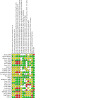
Risk of bias summary: review authors' judgements about each risk of bias item for each included study. Spaces are left blank in the case a judgement is not applicable (e.g. study reports only outcomes subjective to participants).
Allocation
Random sequence generation
Seven trials described a random component in the sequence generation process and were at low risk of selection bias (CALGB 90202; Ernst 2003; Fizazi 2011; Saad 2010; STAMPEDE; TRAPEZE 2016; ZAPCA). The other 18 trials were randomized studies, but without any further report on the sequence generation process (Abetz 2006; Elomaa 1992; Figg 2005; Fizazi 2009; GU02‐4; Kylmala 1993; Kylmala 1997; Meulenbeld 2012; Michaelson 2012; Pan 2014; PR05; Robertson 1995; Ryan 2007; Small 2003; Smith 1989; Strang 1997; Wang 2013; ZABTON‐PC); hence we judged the risk of selection bias for these studies as unclear.
Allocation concealment
Six studies reported on the method to conceal allocation and were at low risk of selection bias (Ernst 2003; Fizazi 2011; PR05; Ryan 2007; TRAPEZE 2016; ZAPCA). Nineteen trials provided no further information addressing allocation concealment and were considered to be at unclear risk of selection bias (Abetz 2006; CALGB 90202; Elomaa 1992; Figg 2005; Fizazi 2009; GU02‐4; Kylmala 1993; Kylmala 1997; Meulenbeld 2012; Michaelson 2012; Pan 2014; Robertson 1995; Saad 2010; Small 2003; Smith 1989; STAMPEDE; Strang 1997; Wang 2013; ZABTON‐PC).
Blinding
Blinding of participants (performance bias)
Twelve trials described some type of blinding of participants and were at low risk of performance bias (CALGB 90202; Ernst 2003; Fizazi 2011; Kylmala 1997; Pan 2014; PR05; Robertson 1995; Ryan 2007; Saad 2010; Small 2003; Smith 1989; Strang 1997). Six trials provided no information and were therefore at unclear risk of performance bias (Abetz 2006; Elomaa 1992; GU02‐4; Kylmala 1993; Michaelson 2012; Wang 2013). Seven trials were designed as open‐label studies and were at high risk of bias (Figg 2005; Fizazi 2009; Meulenbeld 2012; STAMPEDE; TRAPEZE 2016; ZABTON‐PC; ZAPCA).
Blinding of personnel (performance bias)
Nine trials described some type of blinding of personnel and were at low risk of performance bias (CALGB 90202; Ernst 2003; Fizazi 2011; GU02‐4; PR05; Robertson 1995; Saad 2010; Small 2003; Strang 1997). Nine trials provided no information and were at unclear risk of performance bias (Abetz 2006; Elomaa 1992; Kylmala 1993; Kylmala 1997; Michaelson 2012; Pan 2014; Ryan 2007; Smith 1989; Wang 2013). Seven trials were designed as open‐label studies and were at high risk of bias (Figg 2005; Fizazi 2009; Meulenbeld 2012; STAMPEDE; TRAPEZE 2016; ZABTON‐PC; ZAPCA).
Blinding of outcome assessment (detection bias)
Outcomes subjective to participants
Of the 25 included trials, 24 reported outcomes subjective to participants as defined in the Assessment of risk of bias in included studies section. Eight trials reported blinding of outcome assessment for subjective outcomes and were at low risk of detection bias (CALGB 90202; Ernst 2003; Fizazi 2011; Kylmala 1997; Robertson 1995; Saad 2010; Small 2003; Strang 1997). Nine trials provided insufficient information and were therefore judged as at unclear risk of bias (Abetz 2006; Elomaa 1992; GU02‐4; Kylmala 1993; Pan 2014; PR05; Ryan 2007; Smith 1989; Wang 2013). Seven trials were open‐label studies, which we judged as at high risk of bias (Figg 2005; Fizazi 2009; Meulenbeld 2012; STAMPEDE; TRAPEZE 2016; ZABTON‐PC; ZAPCA).
Outcomes subjective to outcome assessor
Eighteen of the 25 included studies reported outcomes defined as subjective to outcome assessor in the Assessment of risk of bias in included studies section. Three studies reported that outcome assessment was blinded and were judged as at low risk of detection bias (CALGB 90202; Fizazi 2011; PR05). Fifteen trials provided insufficient information on blinding of outcome assessment and were therefore judged as at unclear risk of bias (Figg 2005; Fizazi 2009; Meulenbeld 2012; Michaelson 2012; Pan 2014; Robertson 1995; Ryan 2007; Saad 2010; Small 2003; STAMPEDE; Strang 1997; TRAPEZE 2016; Wang 2013; ZABTON‐PC; ZAPCA).
Objective outcomes
Of the 25 included trials, 19 reported objective outcomes as defined in the Assessment of risk of bias in included studies section. Twelve studies provided detailed information on blinding of outcome assessment for objective outcomes and were at low risk of detection bias (CALGB 90202; Ernst 2003; Fizazi 2011; GU02‐4; Meulenbeld 2012; Michaelson 2012; Pan 2014; PR05; Robertson 1995; Ryan 2007; Saad 2010; Wang 2013). Seven trials provided no further information and were judged as at unclear risk of detection bias because objective outcomes are by nature unaffected by blinding (Elomaa 1992; Figg 2005; Fizazi 2009; Small 2003; STAMPEDE; TRAPEZE 2016; ZABTON‐PC).
Mortality
Eighteen of the 25 included studies reported mortality as an outcome (CALGB 90202; Elomaa 1992; Ernst 2003; Figg 2005; Fizazi 2009; Fizazi 2011; GU02‐4; Kylmala 1993; Meulenbeld 2012; Pan 2014; PR05; Robertson 1995; Saad 2010; STAMPEDE; TRAPEZE 2016; Wang 2013; ZABTON‐PC; ZAPCA); these were all judged as at low risk of detection bias given that mortality is not influenced by blinding.
Incomplete outcome data
We assessed attrition bias for different types of outcomes separately, which we categorized as follows as time‐to‐event data, patient‐reported outcomes (other than safety data), safety data, and other outcomes.
Seventeen trials reported time‐to‐event data, of which 12 trials addressed incomplete outcome data adequately, describing reasons for missing data or including all randomized participants in the statistical analysis; we assessed these studies as at low risk of attrition bias (CALGB 90202; Ernst 2003; Figg 2005; Fizazi 2009; Fizazi 2011; Meulenbeld 2012; Pan 2014; PR05; Saad 2010; STAMPEDE; Wang 2013; ZAPCA). Five studies provided insufficient information and were at unclear risk of attrition bias (Elomaa 1992; GU02‐4; Kylmala 1993; TRAPEZE 2016; ZABTON‐PC).
Eighteen trials reported patient‐reported outcomes, of which five were judged as at low risk of attrition bias (Ernst 2003; Meulenbeld 2012; Pan 2014; PR05; ZAPCA). Ten studies provided insufficient information and were judged as at unclear risk of attrition bias (Abetz 2006; CALGB 90202; Elomaa 1992; Kylmala 1993; Kylmala 1997; Robertson 1995; Saad 2010; TRAPEZE 2016; Wang 2013; ZABTON‐PC). Small 2003 excluded 7.4% of randomized participants from statistical efficacy analysis because of protocol violations; we therefore judged the risk of bias as high. Smith 1989 excluded 10.5% of randomized participants from statistical analysis because they did not complete one month of treatment. Consequently, we judged the risk of bias as high. Strang 1997 mentioned two different numbers of randomized participants (55 and 52 participants). We judged the risk of bias as high because of a potential loss of data of three participants with no information on what happened to these participants.
Of the 25 included trials, 21 reported safety data. We judged the risk of attrition bias as low for seven studies (Figg 2005; Fizazi 2009; Fizazi 2011; Meulenbeld 2012; Pan 2014; PR05; ZAPCA). Twelve trials provided insufficient information and were judged as at unclear risk of attrition bias (CALGB 90202; Elomaa 1992; Ernst 2003; GU02‐4; Kylmala 1997; Michaelson 2012; Robertson 1995; Saad 2010; STAMPEDE; TRAPEZE 2016; Wang 2013; ZABTON‐PC). Ryan 2007 reported that adverse events were retrospectively abstracted from patient charts, and Small 2003 excluded 7.4% of randomized participants from statistical efficacy analysis because of protocol violations, for which we judged the risk of attrition bias as high.
For other outcomes, we judged risk of attrition bias as low for five trials (CALGB 90202; Figg 2005; Fizazi 2011; Saad 2010; ZAPCA), unclear for 10 trials (Abetz 2006; Elomaa 1992; Fizazi 2009; Pan 2014; Robertson 1995; Ryan 2007; Strang 1997; TRAPEZE 2016; Wang 2013; ZABTON‐PC), and high for Small 2003 for the previously mentioned reasons.
Selective reporting
Six trials published a study protocol or included all expected outcomes and were at low risk of reporting bias (CALGB 90202; Fizazi 2009; GU02‐4; Meulenbeld 2012; PR05; STAMPEDE). Fifteen trials provided little information on primary or secondary outcomes and their definition and were therefore judged as at unclear risk for reporting bias (Abetz 2006; Elomaa 1992; Ernst 2003; Figg 2005; Fizazi 2011; Kylmala 1993; Kylmala 1997; Michaelson 2012; Pan 2014; Robertson 1995; Ryan 2007; Saad 2010; Small 2003; Smith 1989; Strang 1997; Wang 2013). ZABTON‐PC initially planned per protocol to analyze survival data, but excluded survival data in the final publication. TRAPEZE 2016 and ZAPCA did not analyze all prespecified outcomes (e.g. quality of life). Hence, we judged the risk of bias for these three studies as high.
Other potential sources of bias
Abetz 2006 did not report on methods sufficiently. Smith 1989 provided no information on statistical analysis of observed results. Strang 1997 was prematurely terminated because of low accrual. We judged the risk of bias for these three studies as high.
Effects of interventions
See: Table 1
Bisphosphonates and RANKL‐inhibitor versus no treatment/placebo
We performed network meta‐analysis where possible. Risk ratios represent network estimates unless reported differently. Figures showing plots present network meta‐analysis unless reported differently. Plots with green or orange effect estimates refer to network meta‐analysis results. We calculated pairwise meta‐analysis only for outcomes if studies included denosumab, since other results were already shown elsewhere (Macherey 2017). Pairwise meta‐analysis plots are shown with blue effect estimates. An overview of included studies and comparisons and extracted data used for each outcome is shown in Appendix 4.
An overview of the results of the most relevant treatment options, denosumab and zoledronic acid, compared to no treatment/placebo is shown in Table 1.
Primary outcome: proportion of participants with pain response
Network meta‐analysis
Four studies reported on the outcome proportion of participants with pain response and are included in the statistical analysis (Ernst 2003; Meulenbeld 2012; Smith 1989; Wang 2013). Eight other studies planned to analyze pain, but did not report on the proportion of participants with pain response and were therefore not included in the analysis Abetz 2006; Elomaa 1992; Kylmala 1993; Kylmala 1997; Pan 2014; Small 2003; Strang 1997; ZAPCA).
The network diagram is presented in Figure 4. It includes 1013 participants comparing zoledronic acid, clodronate, risedronate, and etidronate and the main comparator no treatment/placebo. The network includes no closed loops.
4.
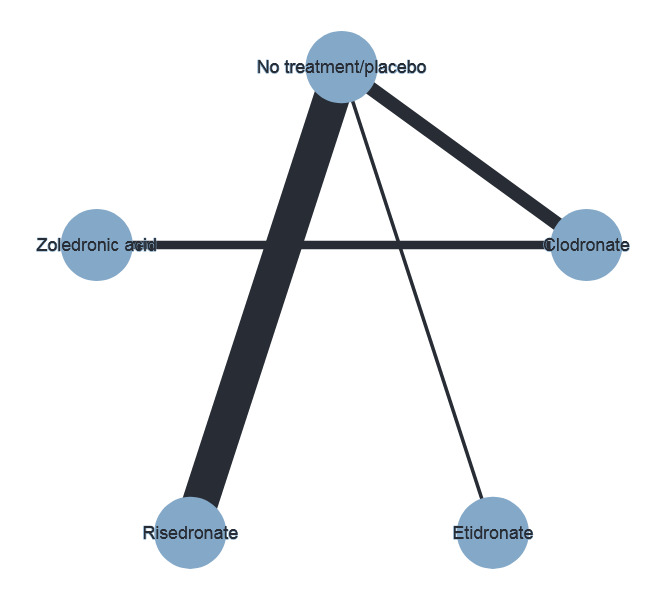
Network diagram for outcome pain response. Any two treatments are connected by a line when there is at least one study comparing the two treatments. Line width: number of participants.
Ernst 2003 and Meulenbeld 2012 used Present Pain Intensity (PPI) scales from the 'McGill Pain Questionnaire' to measure pain. Smith 1989 described using a numeric and a linear scale as assessment tools. Wang 2013 used a 10‐centimeter visual analogue scale (VAS) to assess participant pain during the trial.
In these four trials, definitions of pain response were as follows.
Ernst 2003: PPI score = 0 or decrease of 2 points without an increase in analgesic score or evidence of disease progression; or a greater than 50% decrease in analgesic score without an increase in PPI. These criteria had to be maintained on two consecutive evaluations at least three weeks apart.
Meulenbeld 2012: at least 2‐point reduction from baseline PPI score without an increase in analgesic class or decrease in analgesic class without increased PPI score.
Smith 1989: no definition provided.
Wang 2013 considered the improvement of at least 2‐points as reasonable to identify perceptible pain relief.
Treatment with zoledronic acid probably neither reduces nor increases the proportion of participants with pain response when compared to no treatment/placebo (risk ratio (RR) 1.46, 95% confidence interval (CI) 0.93 to 2.32; moderate‐certainty evidence). Treatment with clodronate also likely does not increase the proportion of participants with pain response compared to no treatment/placebo (RR 1.23, 95% CI 0.80 to 1.89; moderate‐certainty evidence). Treatment with etidronate and risedronate may not increase the proportion of participants with pain response compared to no treatment/placebo (RR 1.30, 95% CI 0.31 to 5.43 and RR 1.12, 95% CI 0.87 to 1.44, respectively; Figure 5). By comparing the different bone‐modifying agents with each other, only the comparison between zoledronic acid and clodronate results in a difference (RR 1.19, 95% CI 1.03 to 1.39), favoring zoledronic acid (Figure 6).
5.
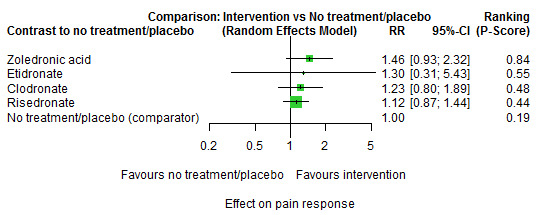
Forest plot for outcome pain response: random‐effects model. Reference treatment: no treatment/placebo. Treatments are ordered by P‐score (descending). The fixed‐effect model yields similar results.
6.
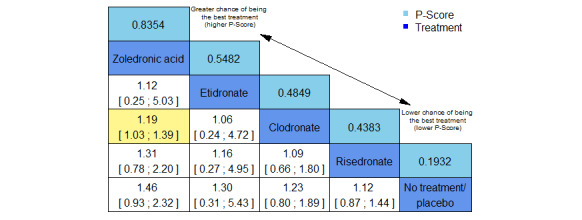
Leaguetable of network meta‐analysis for the outcome proportion of participants with pain response. Treatment options are ranked as indicated by the arrow from top: greater chance of being the best treatment (higher P‐scores) to bottom: lower chance of being the best treatment (lower P‐score). Network estimates with 95% confidence intervals indicating an effect between two of the treatment options are marked in yellow: treatment option in column better than treatment option in row.
No. of studies: 4. No. of treatments: 5. No. of pairwise comparisons: 4. No. of designs: 4
Heterogeneity/inconsistency: Qtotal = 0, P = not available; I2 = not available; Tau2 = not available Treatment effects + 95% confidence intervals (risk ratios, random‐effects model)
Ranking according to P‐scores indicates zoledronic acid as the best treatment option followed by etidronate, clodronate, and risedronate (Figure 5; Figure 6). The fixed‐effect model yields similar results (data/results not shown). For pain response, data were not sufficient to estimate prediction intervals. Generalized heterogeneity statistic Qtotal and generalized I2 statistic could not be analyzed.
Subgroup analysis
When no treatment and placebo were observed separately, the network split in two subnetworks without connection. A statement on differences by observing them separately was therefore not possible.
mCRPC versus mCSPC
Three of the four studies that reported proportion of participants with pain response included participants with mCRPC (Ernst 2003; Meulenbeld 2012; Smith 1989). Network meta‐analysis of only these three studies resulted in a slight change of the relative ranking of treatment options according to P‐score: clodronate and etidronate exchanged compared to ranking in Figure 6 (data not shown). The network meta‐analysis (NMA) effect estimates only considering mCRPC continue to suggest no differences between the treatment options (clodronate, etidronate, risedronate, and no treatment/placebo).
Since the only study reporting on treatment with zoledronic acid included mCSPC patients (Wang 2013), we were not able to include zoledronic acid in the comparison with the other treatment options, and no analysis could be performed regarding this subgroup.
Sensitivity analysis
We included three studies in the sensitivity analysis due to low risk of bias (Ernst 2003; Smith 1989; Wang 2013). The network includes 421 participants. The treatments considered were zoledronic acid, clodronate, etidronate, and the main comparator no treatment/placebo. There is no closed loop (network diagram not shown).
Compared to no treatment/placebo, treatment with zoledronic acid (RR 1.46, 95% CI 0.93 to 2.32), etidronate (RR 1.30, 95% CI 0.31 to 5.43), and clodronate (RR 1.23, 95% CI 0.80 to 1.89) likely results in little to no difference in pain response (Figure 7). By comparing the different bone‐modifying agents with each other, zoledronic acid compared to clodronate still results in differences favoring zoledronic acid (RR 1.19, 95% CI 1.03 to 1.39; Figure 8).
7.
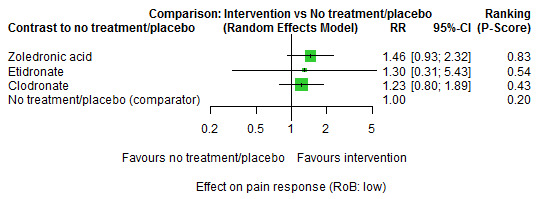
Forest plot for sensitivity analysis for outcome pain response (risk of bias (RoB) low): random‐effects model. Reference treatment: no treatment/placebo. Treatments are ordered by P‐score (descending). The fixed‐effect model yields similar results.
8.
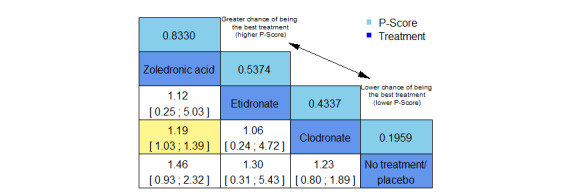
Leagutetable of sensitivity network meta‐analysis including only studies with low risk of bias for outcome proportion of participants with pain response. Treatment options are ranked as indicated by the arrow from top: greater chance of being the best treatment (higher P‐scores) to bottom: lower chance of being the best treatment (lower P‐score). Network estimates with 95% confidence intervals indicating an effect between two of the treatment options are marked in yellow: treatment option in column better than treatment option in row.
No. of studies: 3. No. of treatments: 4. No. of pairwise comparisons: 3. No. of designs: 3
Heterogeneity/inconsistency: Qtotal = 0, P = not available; I2 = not available; Tau2 = not available Treatment effects + 95% confidence intervals (risk ratios, random‐effects model)
Ranking according to P‐scores still indicates zoledronic acid as the best treatment option followed by etidronate and clodronate (Figure 7; Figure 8). The fixed‐effect model yields similar results (data not shown). For the sensitivity analysis of pain response, data were not sufficient to estimate prediction intervals. Generalized heterogeneity statistic Qtotal and generalized I2 statistic could not be analyzed.
Pairwise meta‐analysis
Since no studies with denosumab reported the proportion of participants with pain response as an outcome, no pairwise meta‐analysis is shown.
Primary outcome: adverse event: renal impairment
Network meta‐analysis
Eight studies reported the adverse event renal impairment, and six studies with at least one event are included in the statistical analysis (CALGB 90202; Elomaa 1992; Figg 2005; Saad 2010; Wang 2013; ZAPCA). Two studies with zero events could not be included in the final network (Kylmala 1997; Pan 2014). The network diagram is presented in Figure 9. The network includes 1769 participants. Treatments considered were zoledronic acid, clodronate, and alendronate as well as the main comparator no treatment/placebo. There is one closed loop.
9.
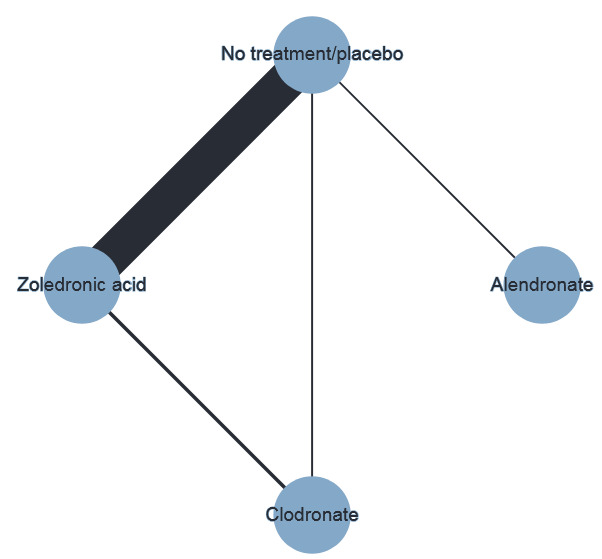
Network diagram for outcome adverse event: renal impairment. Any two treatments are connected by a line when there is at least one study comparing the two treatments. Line width: number of participants.
Compared to no treatment/placebo, treatment with zoledronic acid likely increases renal impairment (RR 1.63, 95% CI 1.08 to 2.45; moderate‐certainty evidence). Treatment with clodronate likely results in little to no difference in renal impairment (RR 1.25, 95% CI 0.7 to 2.23; moderate‐certainty evidence) as well as with alendronate (RR 2.00, 95% CI 0.19 to 21.09) (Figure 10). By comparing the different bone‐modifying agents with each other, no meaningful differences between the three active treatments are shown (Figure 11).
10.
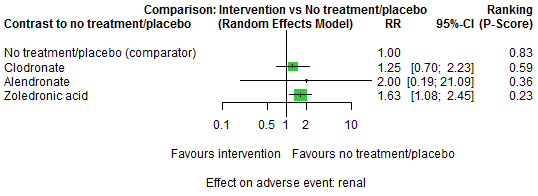
Forest plot for the outcome adverse events: renal impairment. Random‐effects model. Reference treatment: no treatment/placebo. Treatments are ordered by P‐score (descending). The fixed‐effect model yields similar results.
11.

Leaguetable of network meta‐analysis for outcome adverse event: renal impairment. Treatment options are ranked as indicated by the arrow from top: greater chance of being the best treatment (higher P‐scores) to bottom: lower chance of being the best treatment (lower P‐score). Network estimates with 95% confidence intervals indicating an effect between two of the treatment options are marked in yellow: treatment option in column better than treatment option in row. Global approach to check inconsistency/heterogeneity: Q‐statistics, I2.
No. of studies: 6. No. of treatments: 4. No. of pairwise comparisons: 6. No. of designs: 4
Qtotal = 0.92, P = 0.82/Qwithin = 0.56; P = 0.76/Qbetween = 0.36, P = 0.55; I2 = 0.0%, Tau2 = 0 Treatment effects + 95% confidence intervals (risk ratios, random‐effects model)
Ranking according to P‐scores indicates zoledronic acid as the worst treatment option followed by alendronate and clodronate (Figure 10; Figure 11). Prediction intervals, to be interpreted as the 95% range of true RR to be expected in similar future trials, are given in Figure 12; related leaguetables with prediction intervals are shown in Table 2. The fixed‐effect model yields similar results (data not shown).
12.
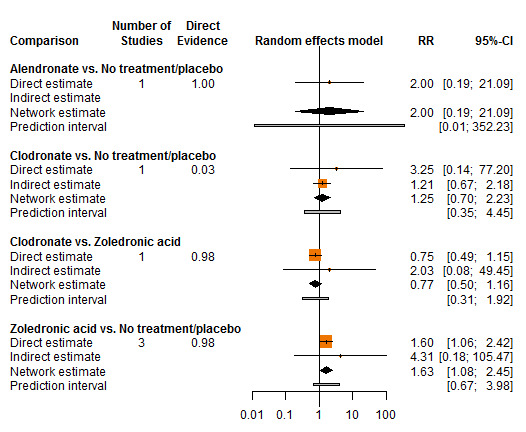
Forest plot of splitting direct and indirect evidence for the outcome adverse event: renal impairment. In addition to the confidence interval for the network estimate, prediction intervals are shown as bars for each comparison.
Local approach to check inconsistency—comparison of direct and indirect estimates for closed loops. As presented in Figure 9, there is one closed loop in the network (zoledronic acid—clodronate—no treatment/placebo). There is no significant difference between direct and indirect estimate (P value of test for disagreement: P = 0.547).
1. Results of network meta‐analysis for outcome adverse event: renal impairment. Prediction intervals. Treatments are ordered by P‐score (descending).
| 95% prediction intervals (risk ratios, random‐effects model) | |||
| No treatment/placebo | [ 0.35, 4.45 ] | [ 0.01, 352.23 ] | [ 0.67, 3.98 ] |
| [ 0.22, 2.86 ] | Clodronate | [ 0.01, 329.39 ] | [ 0.52, 3.28 ] |
| [ 0, 88.06 ] | [ 0, 128.15 ] | Alendronate | [ 0, 154.88 ] |
| [ 0.25, 1.5 ] | [ 0.31, 1.92 ] | [ 0.01, 233.44 ] | Zoledronic acid |
In the entire network, generalized heterogeneity statistic Qtotal and generalized I2 statistic showed no notable inconsistency between studies (Qtotal = 0.92, P = 0.82/Qwithin = 0.56, P = 0.76/Qbetween = 0.36, P = 0.55; I2 = 0.0%, Tau2 = 0). Net heat plot does not show any hot spots of inconsistency (Figure 13). The splitting into the contribution of direct and indirect evidence reveals the same results; test of agreement between direct and indirect evidence does not find local inconsistency for the closed loop (P = 0.55, Figure 12).
13.
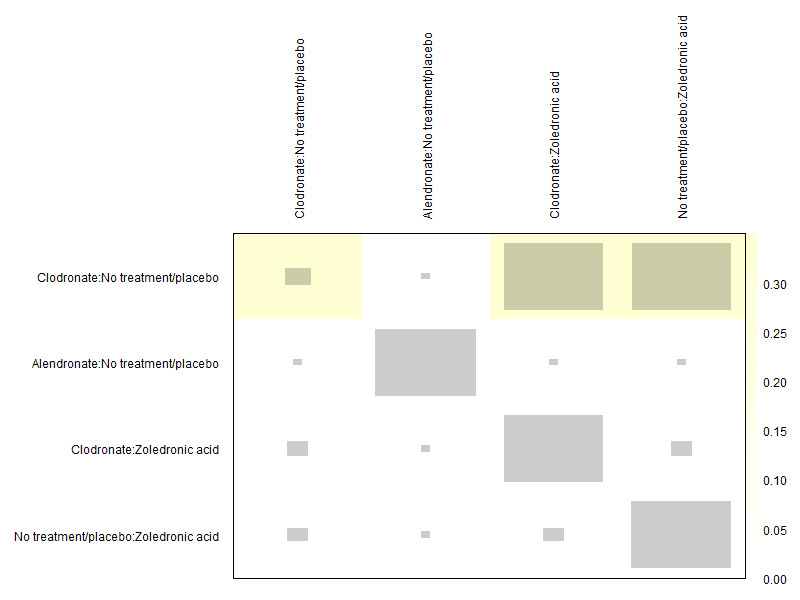
Net heat plot for outcome adverse events: renal impairment (random‐effects model).
There are negligible signs of inconsistency in the net heat plot.
Local approach to check inconsistency—comparison of direct and indirect estimates for closed loops.
Renal impairment is not considered an adverse event of treatment with denosumab. One study that compared zoledronic acid with denosumab reported adverse events "potentially associated with renal impairment occurred in 139 patients (15%) in the denosumab group and 153 patients (16%) in the zoledronic acid group" (Fizazi 2011). Since these were not further defined, we did not include these in our analysis or the ranking. Another study reported that "denosumab had no effect on renal function – creatinine levels 0.0 at 25 weeks" (Fizazi 2009).
Subgroup analysis
When no treatment and placebo were observed separately, the order of the ranking did differ slightly, but the results showed that treatment with zoledronic acid likely neither reduces nor decreases renal impairment compared to no treatment or placebo (network diagram and data not shown).
mCRPC versus mCSPC
Three of the six studies that reported the adverse event renal impairment included participants with mCRPC (CALGB 90202; Figg 2005; Saad 2010). Network meta‐analysis of only these three studies resulted in no change of the relative ranking of treatment options according to P‐score compared to ranking in Figure 11 (data not shown). Clodronate is no longer included in the ranking. The direction of NMA effect estimates did not change, and the effect estimates and confidence intervals only changed slightly without impact on interpretations.
One study included mCSPC patients (Wang 2013). No analysis could be performed regarding this subgroup.
Sensitivity analysis
We included four studies in the sensitivity analysis due to low risk of bias (CALGB 90202; Elomaa 1992; Saad 2010; Wang 2013). The network includes 1473 participants. Treatments considered were zoledronic acid, clodronate, and the main comparator no treatment/placebo. There is one closed loop (network diagram not shown).
Compared to no treatment/placebo, treatment with zoledronic acid likely increases renal impairment (RR 1.60, 95% CI 1.06 to 2.41), and clodronate likely results in little to no difference (RR 1.22, 95% CI 0.68 to 2.19) (Figure 14). By comparing the different bone‐modifying agents with each other, no differences between the two active treatments were shown (Figure 15).
14.
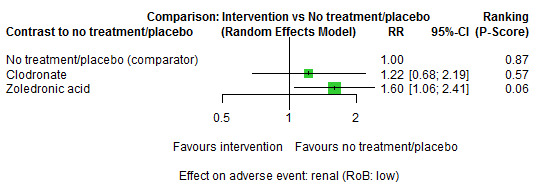
Forest plot for sensitivity analysis of the primary outcome adverse event: renal impairment (risk of bias (RoB) low): random‐effects model. Reference treatment: no treatment/placebo. Treatments are ordered by P‐score (descending). The fixed‐effect model yields similar results.
15.
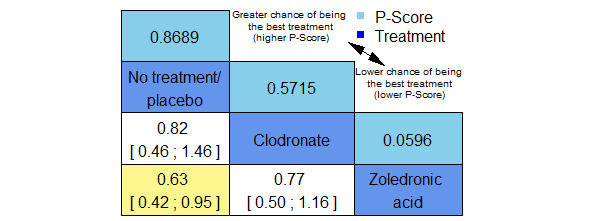
Leaguetable of sensitivity network meta‐analysis including only studies with low risk of bias for outcome adverse event: renal impairment. Treatment options are ranked as indicated by the arrow from top: greater chance of being the best treatment (higher P‐scores) to bottom: lower chance of being the best treatment (lower P‐score). Network estimates with 95% confidence intervals indicating an effect between two of the treatment options are marked in yellow: treatment option in column better than treatment option in row.
No. of studies: 4. No. of treatments: 3. No. of pairwise comparisons: 4. No. of designs: 3
Qtotal = 0.38, P = 0.83/Qwithin = 0.00, P = 0.95/Qbetween = 0.38, P = 0.54; I2 = 0.0%, Tau2 = 0 Treatment effects + 95% confidence intervals (risk ratios, random‐effects model).
Ranking according to P‐scores still indicates zoledronic acid as the worst treatment option followed by clodronate (Figure 14; Figure 15). Prediction intervals, to be interpreted as the 95% range of true RR to be expected in similar future trials, are given in Figure 16; related leaguetables with prediction intervals are shown in Table 3. The fixed‐effect model yields similar results (data not shown).
16.
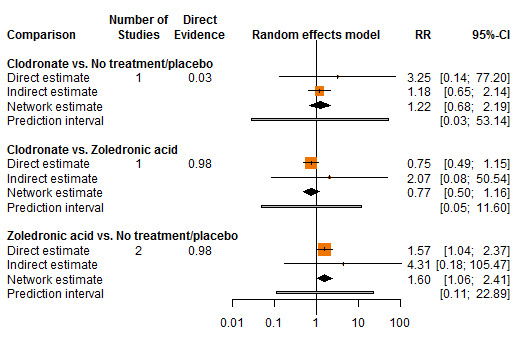
Forest plot of splitting direct and indirect evidence for outcome adverse event: renal impairment (risk of bias: low). In addition to the confidence interval for the network estimator, a prediction interval is shown.
Local approach to check inconsistency—comparison of direct and indirect estimate for closed loops. There is one closed loop in the network (graph not shown; zoledronic acid—clodronate—no treatment/placebo). There is no significant difference between direct and indirect estimate (P value of test for disagreement: P = 0.538).
2. Results of sensitivity network meta‐analysis for outcome adverse event: renal impairment (risk of bias low). Prediction intervals. Treatments are ordered by P‐score (descending). Only subnetworks with > 1 design.
| 95% prediction intervals (risk ratios, random‐effects model) | ||
| No treatment/placebo | [ 0.03, 53.14 ] | [ 0.11, 22.89 ] |
| [ 0.02, 35.56 ] | Clodronate | [ 0.09, 19.76 ] |
| [ 0.04, 8.99 ] | [ 0.05, 11.6 ] | Zoledronic acid |
Primary outcome: adverse event: osteonecrosis of the jaw
Network meta‐analysis
Seven studies reported the adverse event ONJ (CALGB 90202; Fizazi 2011; Meulenbeld 2012; Pan 2014; Wang 2013; ZABTON‐PC; ZAPCA), of which four studies with at least one event are included in the statistical analysis (CALGB 90202; Fizazi 2011; Wang 2013; ZAPCA). Three studies with zero events could not be included in the final network (Meulenbeld 2012; Pan 2014; ZABTON‐PC). The network diagram is presented in Figure 17. The network includes 3006 participants. Treatments considered were zoledronic acid, clodronate, denosumab, as well as the main comparator no treatment/placebo. The network includes no closed loops.
17.
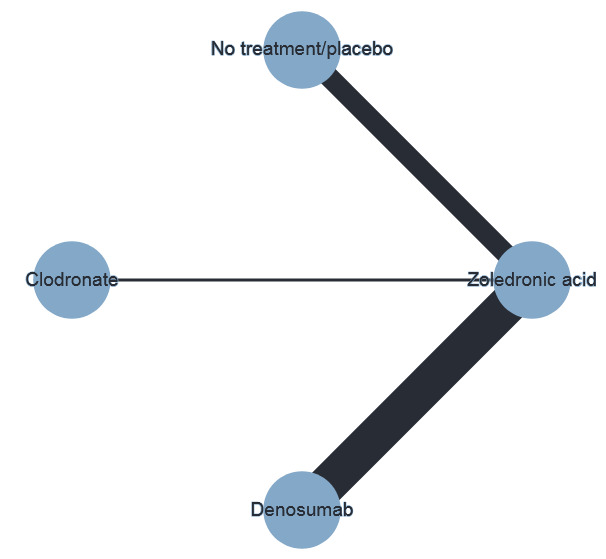
Network diagram for the outcome adverse event: osteonecrosis of the jaw. Any two treatments are connected by a line when there is at least one study comparing the two treatments. Line width: number of participants.
Compared to no treatment/placebo, treatment with denosumab results in an increased occurrence of ONJ (RR 3.45, 95% CI 1.06 to 11.24; high‐certainty evidence), and treatment with zoledronic acid likely results in little to no difference in ONJ (RR 1.88, 95% CI 0.73 to 4.87; moderate‐certainty evidence). The evidence suggests that treatment with clodronate also results in little to no difference in ONJ (RR 0.64, 95% CI 0.02 to 17.63; low‐certainty evidence; Table 1) (Figure 18). By comparing the different bone‐modifying agents with each other, no differences between the three active treatments were shown (Figure 19).
18.
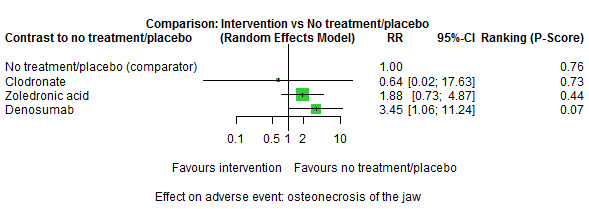
Forest plot for the outcome adverse event: osteonecrosis of the jaw. Random‐effects model. Reference treatment: no treatment/placebo. Treatments are ordered by P‐score (descending). The fixed‐effect model yields similar results.
Since there are no closed loops in the network, no local approach to check inconsistency comparing direct and indirect estimates was done. Also, prediction intervals could not be calculated.
19.
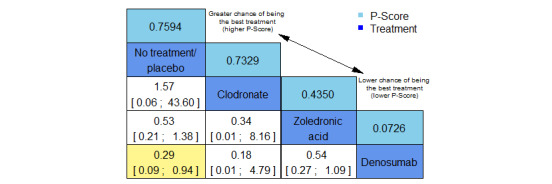
Leaguetable of network meta‐analysis for outcome adverse event: osteonecrosis of the jaw. Treatment options are ranked as indicated by the arrow from top: greater chance of being the best treatment (higher P‐scores) to bottom: lower chance of being the best treatment (lower P‐score). Network estimates with 95% confidence intervals indicating an effect between two of the treatment options are marked in yellow: treatment option in column better than treatment option in row. Global approach to check inconsistency/heterogeneity: Q‐statistics, I2.
No. of studies: 4. No. of treatments: 4. No. of pairwise comparisons: 4. No. of designs: 3
Heterogeneity/inconsistency: Qtotal = 0.45, P = 0.50; I2 = 0.0%, Tau2 = 0 Treatment effects + 95% confidence intervals (risk ratios, random‐effects model)
Ranking according to P‐scores indicates denosumab as the worst treatment option followed by zoledronic acid and then clodronate, which ranks similar to no treatment/placebo (Figure 18; Figure 19). The fixed‐effect model yields similar results (data not shown). For ONJ, data were not sufficient to estimate prediction intervals.
In the entire network, generalized heterogeneity statistic Qtotal and generalized I2 statistic showed no notable inconsistency between studies (Qtotal = 0.45, P = 0.50; I2 = 0.0%, Tau2 = 0).
Subgroup analysis
When no treatment and placebo were observed separately, the order of the ranking did not differ, but the results of the comparison between treatment with denosumab and no treatment or placebo were not shown (network diagram and data not shown).
mCRPC versus mCSPC
Two of the four included studies that reported the adverse event ONJ included participants with mCRPC (CALGB 90202; Fizazi 2011). Network meta‐analysis of only these three studies resulted in no change of the relative ranking of treatment options according to P‐score compared to ranking in Figure 19 (data not shown). Clodronate is no longer included in the ranking. The direction of NMA effect estimates did not change, but the confidence interval of the effect estimate comparing denosumab to no treatment/placebo includes the line of no effect and therefore suggests no evidence for a difference any longer.
One study included mCSPC patients (Wang 2013). No analysis could be performed regarding this subgroup.
Sensitivity analysis
We included three studies in the sensitivity analysis due to low risk of bias (CALGB 90202; Fizazi 2011; Wang 2013). The network includes 2782 participants. Treatments considered were zoledronic acid, denosumab, clodronate, and the main comparator no treatment/placebo. There is no closed loop (network diagram not shown).
Compared to no treatment/placebo, treatment with denosumab (RR 3.10, 95% CI 0.92 to 10.52) and treatment with zoledronic acid (RR 1.69, 95% CI 0.62 to 4.60) likely results in little to no difference in occurrence of ONJ. The evidence suggests the same for clodronate (RR 0.57, 95% CI 0.02 to 16.07) (Figure 20).
20.
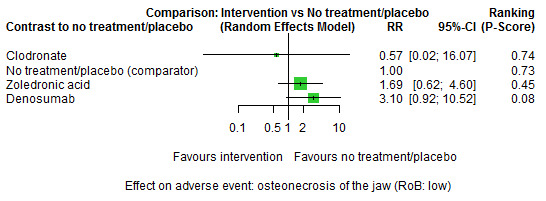
Forest plot for sensitivity analysis of outcome adverse event: osteonecrosis of the jaw (risk of bias (RoB) low): random‐effects model. Reference treatment: no treatment/placebo. Treatments are ordered by P‐score (descending). The fixed‐effect model yields similar results.
Ranking according to P‐scores shows denosumab as the worst treatment option followed by zoledronic acid, no treatment/placebo, and clodronate (Figure 20; Figure 21). The fixed‐effect model yields similar results (data not shown). For the sensitivity analysis of ONJ, data were not sufficient to estimate prediction intervals.
21.
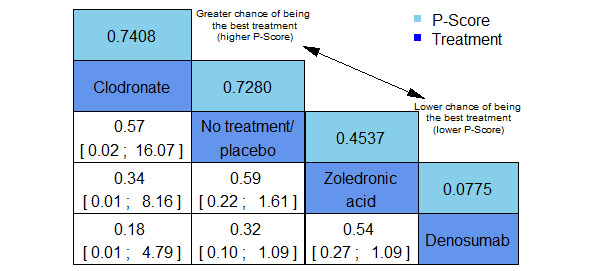
Leaguetable of sensitivity network meta‐analysis including only studies with low risk of bias for outcome adverse event: osteonecrosis of the jaw. Treatment options are ranked as indicated by the arrow from top: greater chance of being the best treatment (higher P‐scores) to bottom: lower chance of being the best treatment (lower P‐score). Network estimates with 95% confidence intervals indicating an effect between two of the treatment options would have been marked in yellow: treatment option in column better than treatment option in row.
No. of studies: 3. No. of treatments: 4. No. of pairwise comparisons: 3. No. of designs: 3
Heterogeneity/inconsistency: Qtotal = 0, P = not available; I2 = not available, Tau2 = not available Treatment effects + 95% confidence intervals (risk ratios, random‐effects model)
Pairwise meta‐analysis
Only one study reported a comparison with denosumab (Fizazi 2011), therefore no pairwise meta‐analysis was conducted.
Secondary outcome: total number of skeletal‐related events (SREs)
Network meta‐analysis
Twelve studies reported total number of SREs (CALGB 90202; Fizazi 2009; Fizazi 2011; GU02‐4; Pan 2014; PR05; Saad 2010; Small 2003; TRAPEZE 2016; Wang 2013; ZABTON‐PC; ZAPCA), all of which are included in the statistical analysis. Other studies focused on bone mineral density instead of SREs (Elomaa 1992; Kylmala 1993; Kylmala 1997; Michaelson 2012; Ryan 2007); did not report results for the subgroup of prostate cancer patients with metastases (Robertson 1995; STAMPEDE); or only focused on other outcomes like pain (Abetz 2006; Ernst 2003; Figg 2005; Meulenbeld 2012; Smith 1989; Strang 1997). The network diagram is presented in Figure 22. The network includes 5240 participants. Treatments considered were zoledronic acid, denosumab, clodronate, risedronate, pamidronate, as well as the main comparator no treatment/placebo. There is one closed loop.
22.
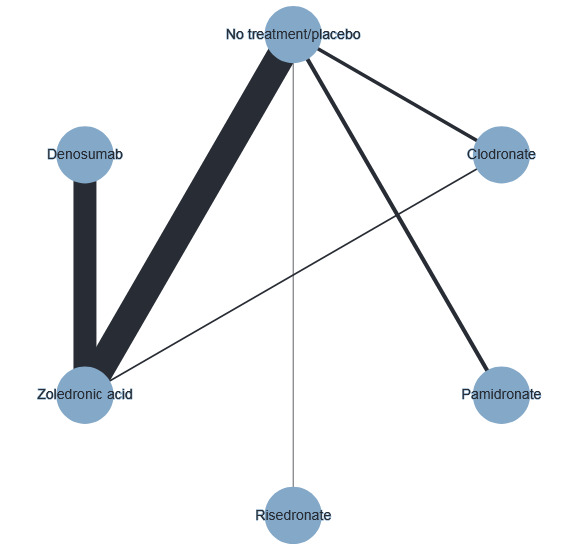
Network diagram for outcome total number of skeletal‐related events. Any two treatments are connected by a line when there is at least one study comparing the two treatments. Line width: number of participants.
Compared to no treatment/placebo, treatment with zoledronic acid (RR 0.84, 95% CI 0.72 to 0.97) and denosumab (RR 0.72, 95% CI 0.54 to 0.96) may reduce total number of SREs (both low‐certainty evidence). The evidence suggests that treatment with clodronate results in little to no difference in total number of SREs (RR 0.93, 95% CI 0.72 to 1.20; low‐certainty evidence). Compared to no treatment/placebo, risedronate (RR 0.97, 95% CI 0.40 to 2.32) and pamidronate (RR 0.98, 95% CI 0.64 to 1.49) may not reduce the total number in SREs (Figure 23; Figure 24). By comparing the different bone‐modifying agents with each other, no differences between the five active treatments were shown (Figure 24).
23.
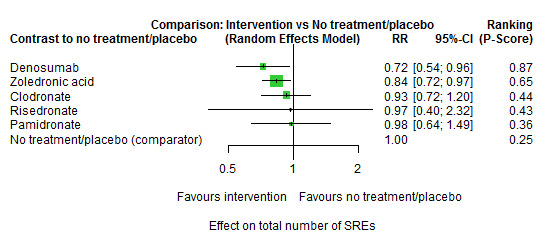
Forest plot for the outcome total number of skeletal‐related events (SREs). Random‐effects model. Reference treatment: no treatment/placebo. Treatments are ordered by P‐score (descending). The fixed‐effect model yields slightly different results (Figure 99).
24.
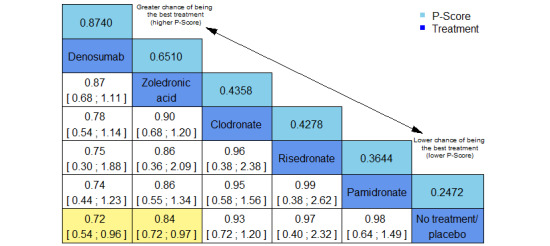
Leaguetable of network meta‐analysis for outcome total number of skeletal‐related events. Treatment options are ranked as indicated by the arrow from top: greater chance of being the best treatment (higher P‐scores) to bottom: lower chance of being the best treatment (lower P‐score). Network estimates with 95% confidence intervals indicating an effect between two of the treatment options are marked in yellow: treatment option in column better than treatment option in row. Global approach to check inconsistency/heterogeneity: Q‐statistics, I2.
No. of studies: 12. No. of treatments: 6. No. of pairwise comparisons: 12. No. of designs: 6
Qtotal = 11.48, P = 0.12/Qwithin = 11.38, P = 0.077/Qbetween = 0.09, P = 0.76; I2 = 39%, Tau2 = 0.0124 Treatment effects + 95% confidence intervals (risk ratios, random‐effects model)
Ranking according to P‐scores indicates denosumab as the best treatment option followed by zoledronic acid, and then clodronate, risedronate, and pamidronate (Figure 23; Figure 24; Figure 25). Prediction intervals, to be interpreted as the 95% range of true RR to be expected in similar future trials, are given in Figure 26; related leaguetables with prediction intervals are shown in Table 4. The fixed‐effect model yields slightly different results (Figure 25).
25.
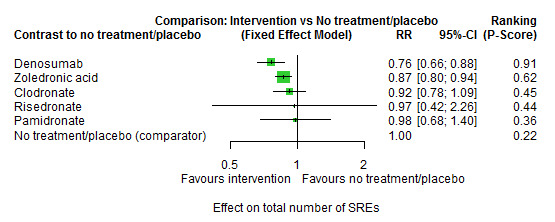
Forest plot for the outcome: total number of skeletal‐related events (SREs). Fixed‐effect model.
26.
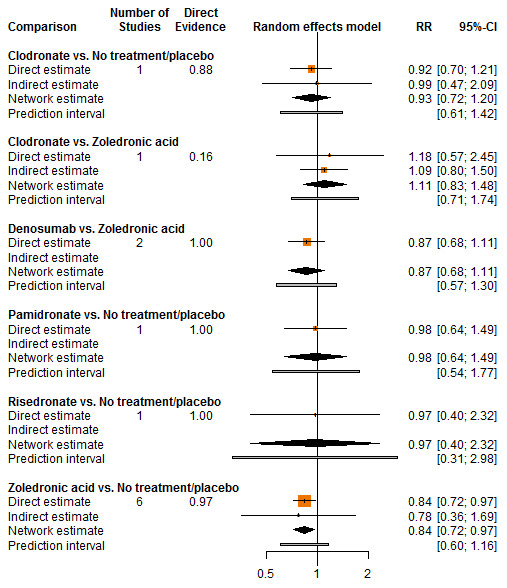
Forest plot of splitting direct and indirect evidence for the outcome total number of skeletal‐related events. In addition to the confidence interval for the network estimate, prediction intervals are shown as bars for each comparison.
Local approach to check inconsistency—comparison of direct and indirect estimates for closed loops. As presented in Figure 22, there is one closed loop in the network (zoledronic acid—clodronate—no treatment/placebo). There is no significant difference between direct and indirect estimate (P value of test for disagreement: P = 0.847).
3. Results of network meta‐analysis for outcome total number of skeletal‐related events. Prediction intervals. Treatments are ordered by P‐score (descending). Only subnetworks with > 1 design.
| 95% prediction intervals (risk ratios, random‐effects model) | |||||
| Denosumab | [ 0.77, 1.74 ] | [ 0.74, 2.21 ] | [ 0.41, 4.35 ] | [ 0.68, 2.7 ] | [ 0.88, 2.16 ] |
| [ 0.57, 1.3 ] | Zoledronic acid | [ 0.71, 1.74 ] | [ 0.37, 3.62 ] | [ 0.63, 2.18 ] | [ 0.86, 1.66 ] |
| [ 0.45, 1.35 ] | [ 0.57, 1.42 ] | Clodronate | [ 0.32, 3.37 ] | [ 0.54, 2.07 ] | [ 0.71, 1.65 ] |
| [ 0.23, 2.43 ] | [ 0.28, 2.7 ] | [ 0.3, 3.09 ] | Risedronate | [ 0.29, 3.5 ] | [ 0.34, 3.18 ] |
| [ 0.37, 1.48 ] | [ 0.46, 1.59 ] | [ 0.48, 1.87 ] | [ 0.29, 3.43 ] | Pamidronate | [ 0.56, 1.85 ] |
| [ 0.46, 1.13 ] | [ 0.6, 1.16 ] | [ 0.61, 1.42 ] | [ 0.31, 2.98 ] | [ 0.54, 1.77 ] | No treatment/placebo |
In the entire network, generalized heterogeneity statistic Qtotal and generalized I2 statistic showed no notable inconsistency between studies (Qtotal = 11.48, P = 0.12/Qwithin = 11.38, P = 0.077/Qbetween = 0.09, P = 0.76; I2 = 39%, Tau2 = 0.0124). Net heat plot does not show any hot spots of inconsistency (Figure 27). The splitting into the contribution of direct and indirect evidence reveals the same results: test of agreement between direct and indirect evidence does not find local inconsistency for the closed loop (P = 0.85, Figure 26).
27.
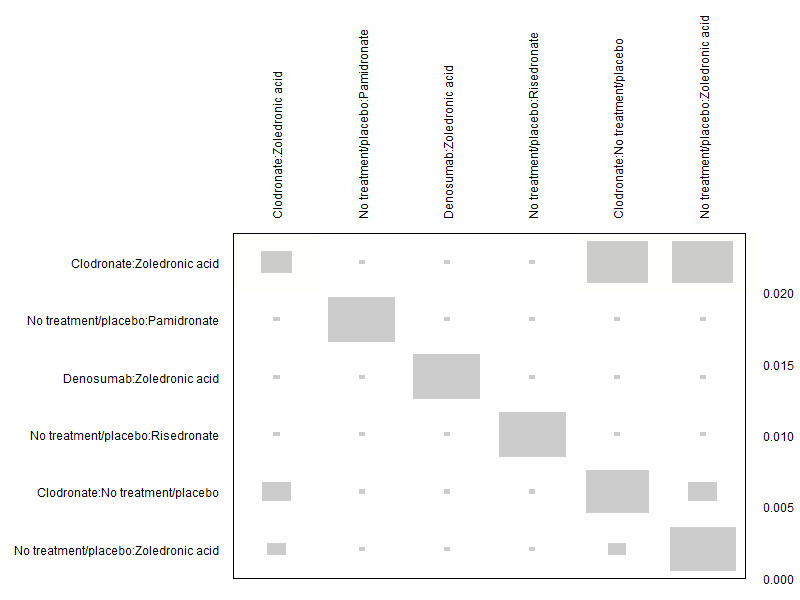
Net heat plot for outcome total number of skeletal‐related events (random‐effects model). There are no signs of inconsistency in the net heat plot.
Subgroup analysis
When no treatment and placebo were observed separately, the order of the ranking did not differ (network diagram and data not shown).
mCRPC versus mCSPC
Seven of the 12 studies that reported total number of adverse events included participants with mCRPC (CALGB 90202; Fizazi 2009; Fizazi 2011; Pan 2014; Saad 2010; Small 2003; TRAPEZE 2016). Network meta‐analysis of only these seven studies resulted in no change of the relative ranking of treatment options according to P‐score compared to ranking in Figure 24 (data not shown). Clodronate and risedronate are no longer included in the ranking. The direction of NMA effect estimates did not change, and effect estimates and confidence intervals only changed slightly without impact on interpretations. Inconsistency represented by I2 was reduced from 39% to 6.9%.
Two studies included participants with mCSPC (PR05; Wang 2013). Network meta‐analysis of only these two studies resulted in no change of the relative ranking only consisting of zoledronic acid, clodronate, and no treatment/placebo according to P‐score compared to ranking in Figure 24 (data not shown). The direction of NMA effect estimates did not change. The NMA effect estimate and confidence interval of the comparison zoledronic acid and no treatment/placebo do not suggest evidence for a difference any longer.
Sensitivity analysis
We included seven studies in the sensitivity analysis due to low risk of bias (CALGB 90202; Fizazi 2011; GU02‐4; Pan 2014; PR05; Saad 2010; Wang 2013). The network includes 3805 participants. Treatments considered were zoledronic acid, denosumab, clodronate, risedronate, and the main comparator no treatment/placebo. There is one closed loop (network diagram not shown).
Compared to no treatment/placebo, treatment with denosumab may reduce total number of SREs (RR 0.78, 95% CI 0.66 to 0.93), and treatment with zoledronic acid or clodronate may result in little to no difference (RR 0.89, 95% CI 0.79 to 1.00 and RR 0.93, 95% CI 0.78 to 1.09). Compared to no treatment/placebo, risedronate may not reduce total number of SREs (RR 0.97, 95% CI 0.42 to 2.26) (Figure 28; Figure 29). By comparing the different bone‐modifying agents with each other, the confidence interval for the comparison of denosumab and zoledronic acid suggests a better effectiveness for denosumab (RR 0.88, 95% 0.79 to 0.99) (Figure 29).
28.
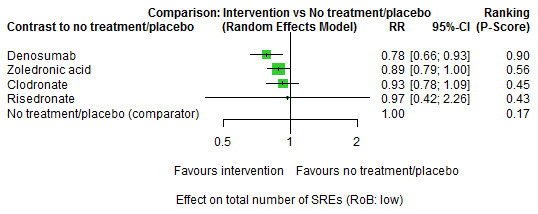
Forest plot for sensitivity analysis of outcome total number of skeletal‐related events (SREs) (risk of bias (RoB) low). Random‐effects model. Reference treatment: no treatment/placebo. Treatments are ordered by P‐score (descending). The fixed‐effect model yields similar results.
29.
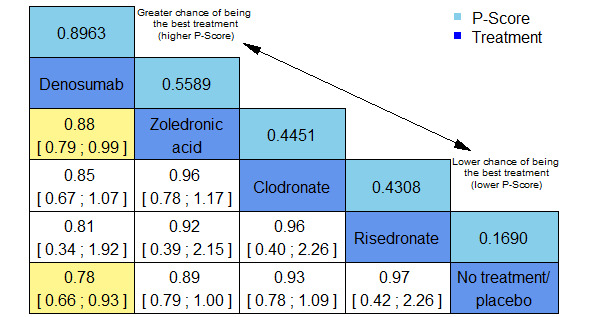
Leaguetable of sensitivity network meta‐analysis including only studies with low risk of bias for outcome total number of skeletal‐related events. Treatment options are ranked as indicated by the arrow from top: greater chance of being the best treatment (higher P‐scores) to bottom: lower chance of being the best treatment (lower P‐score). Network estimates with 95% confidence intervals indicating an effect between two of the treatment options are marked in yellow: treatment option in column better than treatment option in row. Global approach to check inconsistency/heterogeneity: Q‐statistics, I2.
No. of studies: 7. No. of treatments: 5. No. of pairwise comparisons: 7. No. of designs: 5
Qtotal = 2.09, df = 3, P = 0.55/Qwithin = 1.95, df = 2, P = 0.38/Qbetween = 0.14, df = 1, P = 0.71; I2 = 0%, Tau2 = 0 Treatment effects + 95% confidence intervals (risk ratios, random‐effects model)
Ranking according to P‐scores indicates denosumab as the best treatment option followed by zoledronic acid, clodronate, and risedronate (Figure 29). Prediction intervals, to be interpreted as the 95% range of true RR to be expected in similar future trials, are given in Figure 30; related leaguetables with prediction intervals are shown in Table 5. The fixed‐effect model yields similar results (data not shown).
30.
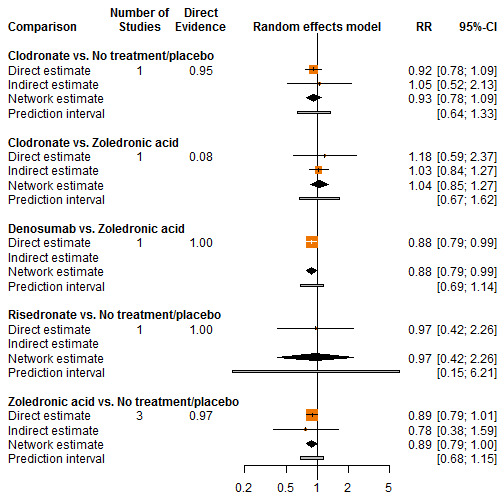
Forest plot of sensitivity analysis of splitting direct and indirect evidence for the outcome total number of skeletal‐related events (risk of bias low). In addition to the confidence interval for the network estimator, a prediction interval is shown.
Local approach to check inconsistency—comparison of direct and indirect estimate for closed loops. There is one closed loop in the network (graph not shown; zoledronic acid—clodronate—no treatment/placebo). There is no significant difference between direct and indirect estimate (P value of test for disagreement: P = 0.710).
4. Results of sensitivity network meta‐analysis for outcome total number of skeletal‐related events (sensitivity risk of bias). Prediction intervals. Treatments are ordered by P‐score (descending). Only subnetworks with > 1 design.
| 95% prediction intervals (risk ratios, random‐effects model) | ||||
| Denosumab | [ 0.88, 1.45 ] | [ 0.71, 1.96 ] | [ 0.19, 8.21 ] | [ 0.89, 1.84 ] |
| [ 0.69, 1.14 ] | Zoledronic acid | [ 0.67, 1.62 ] | [ 0.17, 7.14 ] | [ 0.87, 1.47 ] |
| [ 0.51, 1.41 ] | [ 0.62, 1.49 ] | Clodronate | [ 0.16, 6.95 ] | [ 0.75, 1.55 ] |
| [ 0.12, 5.38 ] | [ 0.14, 5.98 ] | [ 0.14, 6.34 ] | Risedronate | [ 0.16, 6.62 ] |
| [ 0.54, 1.13 ] | [ 0.68, 1.15 ] | [ 0.64, 1.33 ] | [ 0.15, 6.21 ] | No treatment/placebo |
Pairwise meta‐analysis
Two studies are included in the pairwise meta‐analysis regarding total number of SREs through treatment with denosumab compared to zoledronic acid. Compared to zoledronic acid, denosumab likely does not reduce total number of SREs (pairwise RR 0.54, 95% CI 0.12 to 2.45; I2 = 57%, moderate heterogeneity) (Figure 31).
31.

Results of pairwise meta‐analysis of denosumab versus zoledronic acid for the outcome total number of skeletal‐related events (SREs).
Secondary outcome: SRE: pathological fractures
Network meta‐analysis
Eight studies reported the SRE pathological fractures (Fizazi 2011; Pan 2014; PR05; Saad 2010; Small 2003; TRAPEZE 2016; Wang 2013; ZABTON‐PC), all of which are included in the statistical analysis. The network diagram is presented in Figure 32. The network includes 4264 participants. Treatments considered were zoledronic acid, denosumab, clodronate, and pamidronate, as well as the main comparator no treatment/placebo. There is one closed loop.
32.
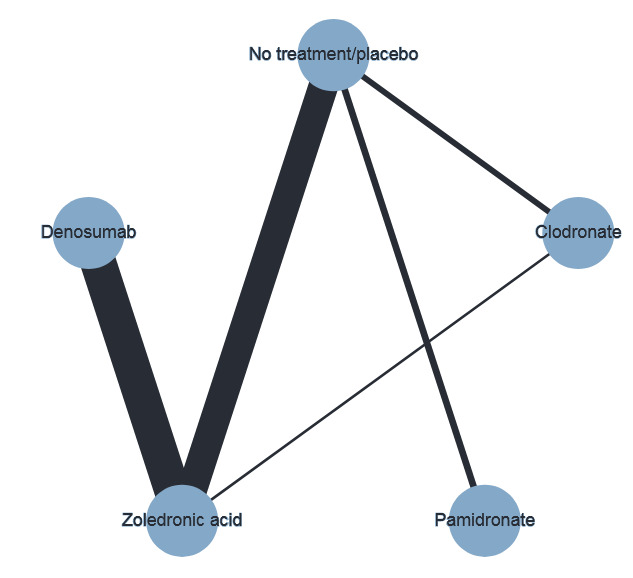
Network diagram for outcome skeletal‐related event: pathological fractures. Any two treatments are connected by a line when there is at least one study comparing the two treatments. Line width: number of participants.
Compared to no treatment/placebo, treatment with zoledronic acid and denosumab may reduce pathological fractures (RR 0.57, 95% CI 0.42 to 0.76 and RR 0.54, 95% CI 0.38 to 0.78, respectively). Treatment with clodronate and pamidronate may result in little to no difference in reducing pathological fractures (RR 0.74, 95% CI 0.35 to 1.58 and RR 1.22, 95% CI 0.71 to 2.07, respectively) (Figure 33; Figure 34). By comparing the different bone‐modifying agents with each other, no differences between the four active treatments are shown (Figure 34).
33.
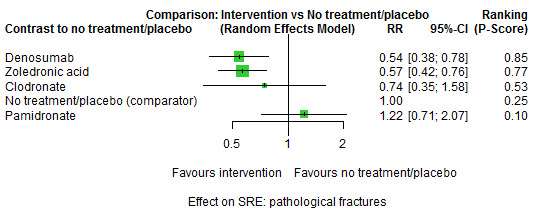
Forest plot for the outcome skeletal‐related event (SRE): pathological fractures. Random‐effects model. Reference treatment: no treatment/placebo. Treatments are ordered by P‐score (descending). The fixed‐effect model yields similar results.
34.
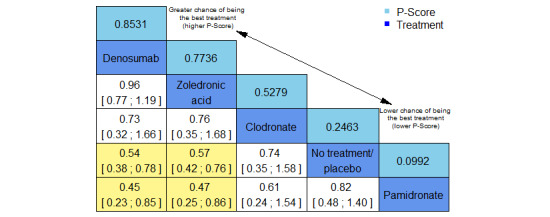
Leaguetable of network meta‐analysis for the outcome skeletal‐related event: pathological fractures. Treatment options are ranked as indicated by the arrow from top: greater chance of being the best treatment (higher P‐scores) to bottom: lower chance of being the best treatment (lower P‐score). Network estimates with 95% confidence intervals indicating an effect between two of the treatment options are marked in yellow: treatment option in column better than treatment option in row. Global approach to check inconsistency/heterogeneity: Q‐statistics, I2.
No. of studies: 8. No. of treatments: 5. No. of pairwise comparisons: 8. No. of designs: 5
Qtotal = 1.73, df = 4, P = 0.78/Qwithin = 1.73, df = 3, P = 0.63/Qbetween = 0.00, df = 1, P = 0.96; I2 = 0.0%, Tau2 = 0
Treatment effects + 95% confidence intervals (risk ratios, random‐effects model)
Ranking according to P‐scores indicates denosumab and zoledronic acid as the best treatment options followed by clodronate, no treatment/placebo, and pamidronate (Figure 33; Figure 34). Prediction intervals, to be interpreted as the 95% range of true RR to be expected in similar future trials, are given in Figure 35; related leaguetables with prediction intervals are shown in Table 6. The fixed‐effect model yields similar results (data not shown).
35.
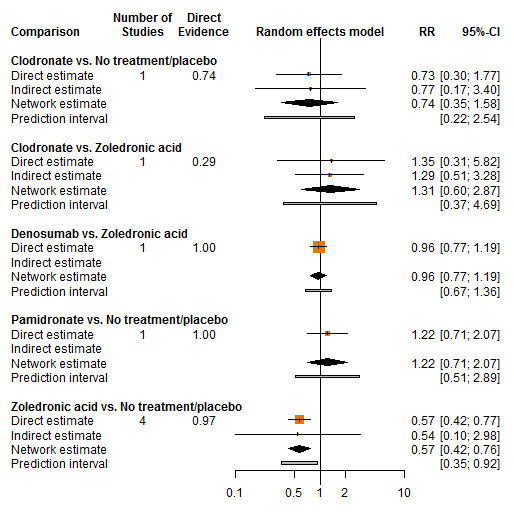
Forest plot of splitting direct and indirect evidence for outcome skeletal‐related event: pathological fractures. In addition to the confidence interval for the network estimator, a prediction interval is shown.
Local approach to check inconsistency—comparison of direct and indirect estimate for closed loops. As presented in Figure 32, there is one closed loop in the network (zoledronic acid—clodronate—no treatment/placebo). There is no significant difference between direct and indirect estimate (P value of test for disagreement: P = 0.958).
5. Results of network meta‐analysis for outcome skeletal‐related events: pathological fractures. Prediction intervals. Treatments are ordered by P‐score (descending).
| 95% prediction intervals (risk ratios, random‐effects model) | ||||
| Denosumab | [ 0.73, 1.48 ] | [ 0.36, 5.13 ] | [ 1.01, 3.34 ] | [ 0.78, 6.41 ] |
| [ 0.67, 1.36 ] | Zoledronic acid | [ 0.37, 4.69 ] | [ 1.09, 2.86 ] | [ 0.8, 5.79 ] |
| [ 0.19, 2.75 ] | [ 0.21, 2.74 ] | Clodronate | [ 0.39, 4.63 ] | [ 0.36, 7.41 ] |
| [ 0.3, 0.99 ] | [ 0.35, 0.92 ] | [ 0.22, 2.54 ] | No treatment/placebo | [ 0.51, 2.89 ] |
| [ 0.16, 1.28 ] | [ 0.17, 1.25 ] | [ 0.13, 2.75 ] | [ 0.35, 1.95 ] | Pamidronate |
In the entire network, generalized heterogeneity statistic Qtotal and generalized I2 statistic showed no notable inconsistency between studies (Qtotal = 1.73, P = 0.78/Qwithin = 1.73, P = 0.63/Qbetween = 0.00, P = 0.96; I2 = 0.0%, Tau2 = 0). Net heat plot does not show any hot spots of inconsistency (Figure 36). The splitting into the contribution of direct and indirect evidence reveals the same results; test of agreement between direct and indirect evidence does not find local inconsistency for the closed loop (P = 0.96, Figure 35).
36.
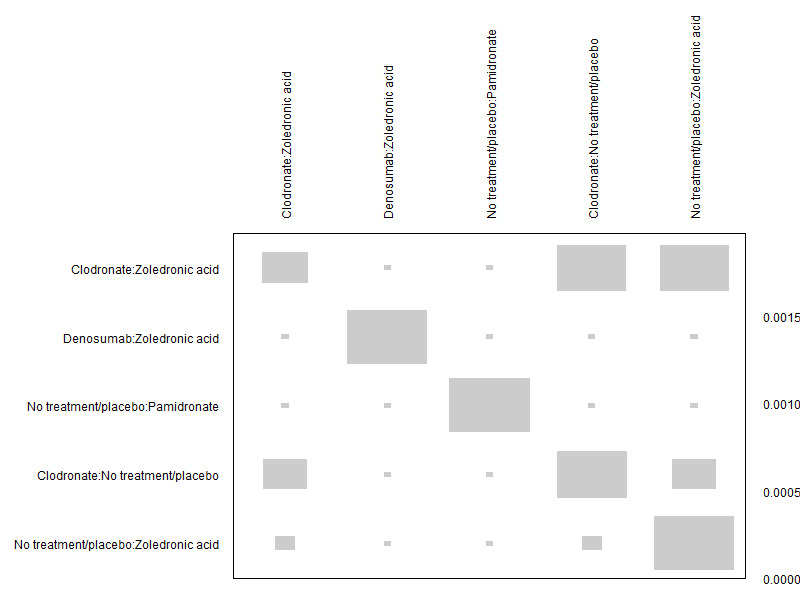
Net heat plot for outcome skeletal‐related event: pathological fractures (random‐effects model). There are no signs of inconsistency in the net heat plot.
Subgroup analysis
When no treatment and placebo were observed separately, the order of the ranking did not differ (network diagram and data not shown).
mCRPC versus mCSPC
Five of the eight studies that reported pathological fractures included participants with mCRPC (Fizazi 2011; Pan 2014; Small 2003; Smith 1989; TRAPEZE 2016). Network meta‐analysis of only these five studies resulted in no change of the relative ranking of treatment options according to P‐score compared to ranking in Figure 34 (data not shown). Clodronate is no longer included in the ranking. The direction of NMA effect estimates did not change, and effect estimates and confidence intervals only changed slightly without impact on interpretations.
Two studies included participants with mCSPC (PR05; Wang 2013). Network meta‐analysis of only these two studies resulted in no change of the relative ranking only consisting of zoledronic acid, clodronate, and no treatment/placebo according to P‐score compared to ranking in Figure 34 (data not shown). The direction of NMA effect estimates did not change. The NMA effect estimate and confidence intervals of the comparison zoledronic acid and no treatment/placebo do not suggest evidence for a difference any longer.
Pairwise meta‐analysis
Only one study reported a comparison with denosumab (Fizazi 2011), therefore no pairwise meta‐analysis was conducted.
Secondary outcome: SRE: spinal cord compression
Network meta‐analysis
Nine studies reported the SRE spinal cord compression (Elomaa 1992; Fizazi 2011; Pan 2014; PR05; Saad 2010; Small 2003; TRAPEZE 2016; Wang 2013; ZABTON‐PC), all of which are included in the statistical analysis. The network diagram is presented in Figure 37. The network includes 4339 participants. Treatments considered were zoledronic acid, denosumab, clodronate, and pamidronate, as well as the main comparator no treatment/placebo. There is one closed loop.
37.
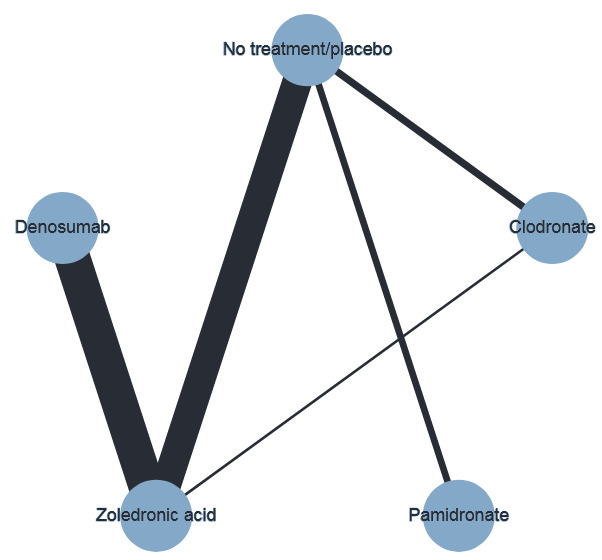
Network diagram for outcome skeletal‐related event: spinal cord compression. Any two treatments are connected by a line when there is at least one study comparing the two treatments. Line width: number of participants.
Compared to no treatment/placebo, treatment with denosumab and zoledronic acid may reduce spinal cord compression (RR 0.43, 95% CI 0.24 to 0.79 and RR 0.60, 95% CI 0.43 to 0.84, respectively). Treatment with clodronate and pamidronate may result in little to no difference in reducing spinal cord compression (RR 0.83, 95% CI 0.45 to 1.52 and RR 1.79, 95% CI 0.43 to 7.35, respectively) (Figure 38; Figure 39). By comparing the different bone‐modifying agents with each other, no differences between the four active treatments were shown (Figure 39).
38.
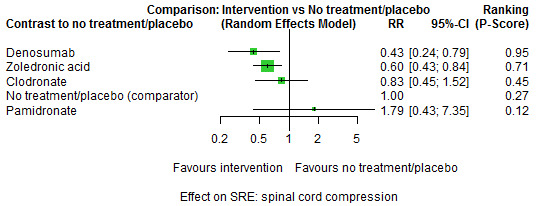
Forest plot for outcome skeletal‐related event (SRE): spinal cord compression. Random‐effects model. Reference treatment: no treatment/placebo. Treatments are ordered by P‐score (descending). The fixed‐effect model yields similar results.
39.
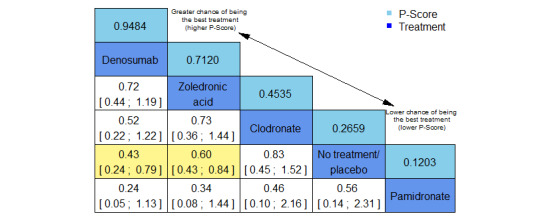
Leaguetable of network meta‐analysis for the outcome skeletal‐related event: spinal cord compression. Treatment options are ranked as indicated by the arrow from top: greater chance of being the best treatment (higher P‐scores) to bottom: lower chance of being the best treatment (lower P‐score). Network estimates with 95% confidence intervals indicating an effect between two of the treatment options are marked in yellow: treatment option in column better than treatment option in row. Global approach to check inconsistency/heterogeneity: Q‐statistics, I2.
No. of studies: 9. No. of treatments: 5. No. of pairwise comparisons: 9. No. of designs: 5
Qtotal = 2.43, P = 0.79/Qwithin = 2.38, P = 0.67/Qbetween = 0.05, P = 0.82; I2 = 0.0%, Tau2 = 0
Treatment effects + 95% confidence intervals (risk ratios, random‐effects model).
Ranking according to P‐scores indicates denosumab as the best treatment option followed by zoledronic acid, clodronate, no treatment/placebo, and pamidronate (Figure 38; Figure 39). Prediction intervals, to be interpreted as the 95% range of true RR to be expected in similar future trials, are given in Figure 40; related leaguetables with prediction intervals are shown in Table 7. The fixed‐effect model yields similar results (data not shown).
40.
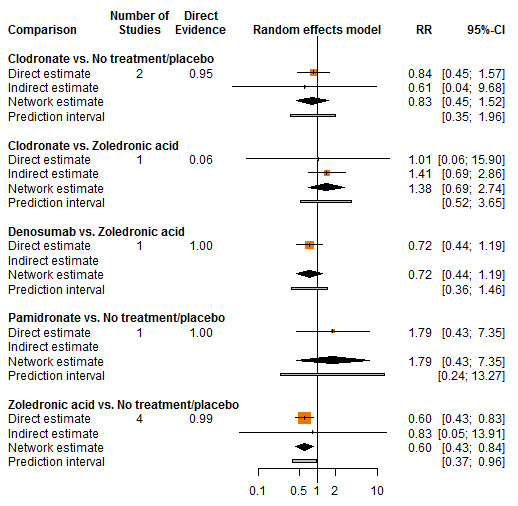
Forest plot of splitting direct and indirect evidence for the outcome skeletal‐related event: spinal cord compression. In addition to the confidence interval for the network estimator, a prediction interval is shown.
Local approach to check inconsistency—comparison of direct and indirect estimate for closed loops. As presented in Figure 37, there is one closed loop in the network (zoledronic acid—clodronate—no treatment/placebo). There is no significant difference between direct and indirect estimate (P value of test for disagreement: P = 0.822).
6. Results of network meta‐analysis for outcome skeletal‐related events: spinal cord compression. Prediction intervals. Treatments are ordered by P‐score (descending).
| 95% prediction intervals (risk ratios, random‐effects model) | ||||
| Denosumab | [ 0.68, 2.79 ] | [ 0.57, 6.34 ] | [ 0.99, 5.38 ] | [ 0.47, 36.34 ] |
| [ 0.36, 1.46 ] | Zoledronic acid | [ 0.52, 3.65 ] | [ 1.04, 2.67 ] | [ 0.38, 23.38 ] |
| [ 0.16, 1.74 ] | [ 0.27, 1.92 ] | Clodronate | [ 0.51, 2.88 ] | [ 0.24, 19.2 ] |
| [ 0.19, 1.01 ] | [ 0.37, 0.96 ] | [ 0.35, 1.96 ] | No treatment/placebo | [ 0.24, 13.27 ] |
| [ 0.03, 2.14 ] | [ 0.04, 2.64 ] | [ 0.05, 4.11 ] | [ 0.08, 4.16 ] | Pamidronate |
In the entire network, generalized heterogeneity statistic Qtotal and generalized I2 statistic showed no notable inconsistency between studies (Qtotal = 2.43, P = 0.79/Qwithin = 2.38, P = 0.67/Qbetween = 0.05, P = 0.82; I2 = 0.0%, Tau2 = 0). Net heat plot does not show any hot spots of inconsistency (Figure 41). The splitting into the contribution of direct and indirect evidence reveals the same results; test of agreement between direct and indirect evidence does not find local inconsistency for the closed loop (P = 0.82, Figure 40).
41.
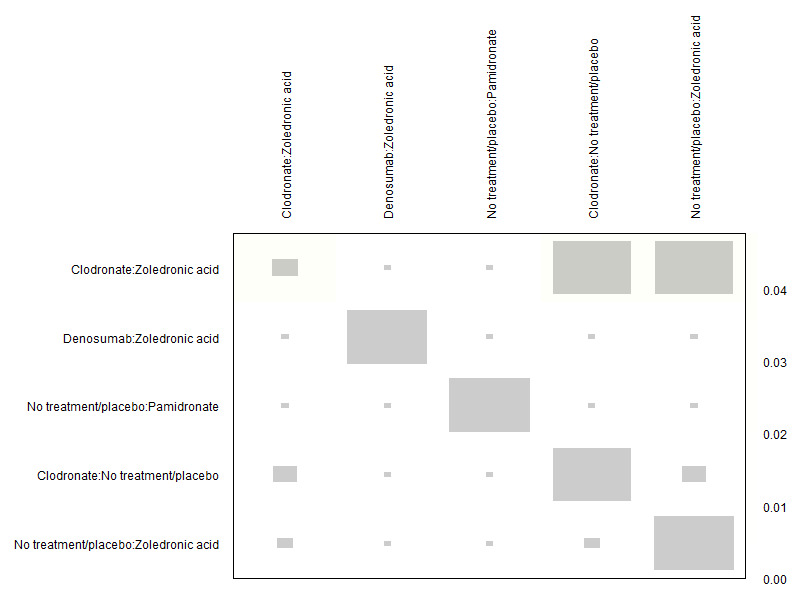
Net heat plot for the outcome skeletal‐related event: spinal cord compression (random‐effects model). There are no signs of inconsistency in the net heat plot.
Subgroup analysis
When no treatment and placebo were observed separately, the order of the ranking did not differ (network diagram and data not shown).
mCRPC versus mCSPC
Five of the nine studies that reported SRE spinal cord compression included participants with mCRPC (Fizazi 2011; Pan 2014; Small 2003; Smith 1989; TRAPEZE 2016). Network meta‐analysis of only these five studies resulted in no change of the relative ranking of treatment options according to P‐score compared to ranking in Figure 39 (data not shown). Clodronate is no longer included in the ranking. The direction of NMA effect estimates did not change, and effect estimates and confidence intervals only changed slightly without impact on interpretations.
Two studies included participants with mCSPC (PR05; Wang 2013). Network meta‐analysis of only these two studies resulted in a change of the relative ranking—zoledronic acid and clodronate exchanged, pamidronate and denosumab no longer in ranking—according to P‐score compared to ranking in Figure 39 (data not shown). The direction of NMA effect estimates did not change. The NMA effect estimate and confidence intervals of the comparison zoledronic acid and no treatment/placebo do not suggest evidence for a difference any longer.
Pairwise meta‐analysis
Only one study reported a comparison with denosumab (Fizazi 2011), therefore no pairwise meta‐analysis was conducted.
Secondary outcome: SRE: bone radiotherapy
Network meta‐analysis
Eight studies reported the SRE bone radiotherapy (Ernst 2003; Fizazi 2011; Pan 2014; PR05; Saad 2010; Small 2003; Wang 2013; ZABTON‐PC), all of which are included in the statistical analysis. The network diagram is presented in Figure 42. The network includes 3716 participants. Treatments considered were zoledronic acid, denosumab, clodronate, and pamidronate, as well as the main comparator no treatment/placebo. There is one closed loop.
42.
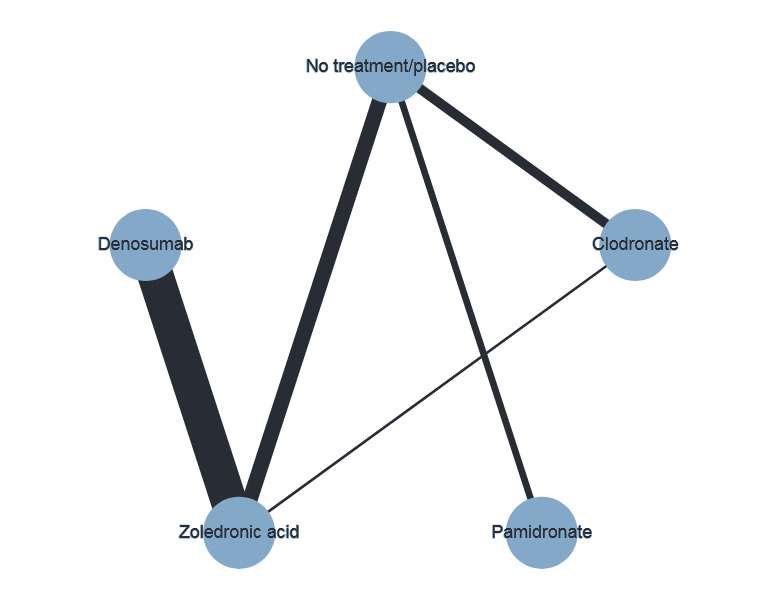
Network diagram for the outcome skeletal‐related event: radiotherapy. Any two treatments are connected by a line when there is at least one study comparing the two treatments. Line width: number of participants.
Compared to no treatment/placebo, treatment with denosumab may reduce the need for bone radiotherapy (RR 0.70, 95% CI 0.51 to 0.95). Treatment with zoledronic acid (RR 0.80, 95% CI 0.62 to 1.03), pamidronate (RR 0.98, 95% CI 0.64 to 1.50), and clodronate (RR 0.97, 95% CI 0.78 to 1.21) may result in little to no difference in reducing the need for bone radiotherapy (Figure 43; Figure 44). By comparing the different bone‐modifying agents with each other, no differences between the five active treatments are shown (Figure 44).
43.
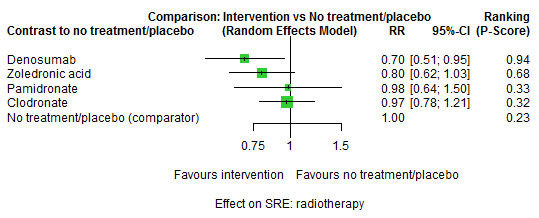
Forest plot for the outcome skeletal‐related event (SRE): radiotherapy. Random‐effects model. Reference treatment: no treatment/placebo. Treatments are ordered by P‐score (descending). The fixed‐effect model yields similar results.
44.
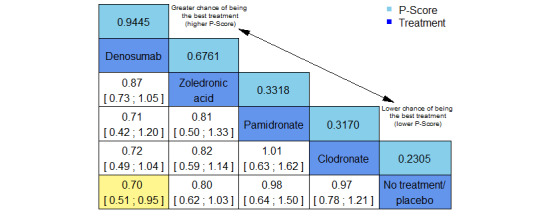
Leaguetable of network meta‐analysis for the outcome skeletal‐related event: radiotherapy. Treatment options are ranked as indicated by the arrow from top: greater chance of being the best treatment (higher P‐scores) to bottom: lower chance of being the best treatment (lower P‐score). Network estimates with 95% confidence intervals indicating an effect between two of the treatment options are marked in yellow: treatment option in column better than treatment option in row. Global approach to check inconsistency/heterogeneity: Q‐statistics, I2.
No. of studies: 8. No. of treatments: 5. No. of pairwise comparisons: 8. No. of designs: 5
Qtotal = 0.29, P = 0.99/Qwithin = 0.28, P = 0.96/Qbetween = 0.00, P = 0.95; I2 = 0.0%, Tau2 = 0
Treatment effects + 95% confidence intervals (risk ratios, random‐effects model)
Ranking according to P‐scores indicates denosumab as the best treatment option followed by zoledronic acid, and then pamidronate and clodronate (Figure 43; Figure 44). Prediction intervals, to be interpreted as the 95% range of true RR to be expected in similar future trials, are given in Figure 45; related leaguetables with prediction intervals are shown in Table 8. The fixed‐effect model yields similar results (data not shown).
45.
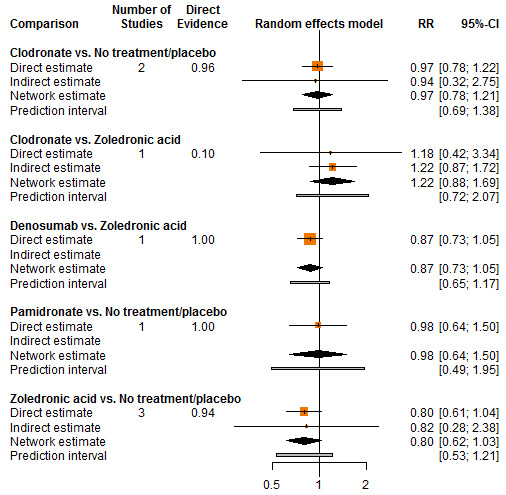
Forest plot of splitting direct and indirect evidence for the outcome skeletal‐related event: radiotherapy. In addition to the confidence interval for the network estimator, a prediction interval is shown.
Local approach to check inconsistency—comparison of direct and indirect estimate for closed loops. As presented in Figure 42, there is one closed loop in the network (zoledronic acid—clodronate—no treatment/placebo). There is no significant difference between direct and indirect estimate (P value of test for disagreement: P = 0.955).
7. Results of network meta‐analysis for outcome skeletal‐related events: bone radiotherapy. Prediction intervals. Treatments are ordered by P‐score (descending).
| 95% prediction intervals (risk ratios, random‐effects model) | ||||
| Denosumab | [ 0.85, 1.54 ] | [ 0.6, 3.31 ] | [ 0.76, 2.55 ] | [ 0.86, 2.38 ] |
| [ 0.65, 1.17 ] | Zoledronic acid | [ 0.55, 2.74 ] | [ 0.72, 2.07 ] | [ 0.83, 1.89 ] |
| [ 0.3, 1.67 ] | [ 0.37, 1.81 ] | Pamidronate | [ 0.46, 2.14 ] | [ 0.51, 2.03 ] |
| [ 0.39, 1.31 ] | [ 0.48, 1.39 ] | [ 0.47, 2.18 ] | Clodronate | [ 0.72, 1.46 ] |
| [ 0.42, 1.16 ] | [ 0.53, 1.21 ] | [ 0.49, 1.95 ] | [ 0.69, 1.38 ] | No treatment/placebo |
In the entire network, generalized heterogeneity statistic Qtotal and generalized I2 statistic showed no notable inconsistency between studies (Qtotal = 0.29, P = 0.99/Qwithin = 0.28, P = 0.96/Qbetween = 0.00, P = 0.95; I2 = 0.0%, Tau2 = 0). Net heat plot does not show any hot spots of inconsistency (Figure 46). The splitting into the contribution of direct and indirect evidence reveals the same results; test of agreement between direct and indirect evidence does not find local inconsistency for the closed loop (P = 0.95, Figure 45).
46.
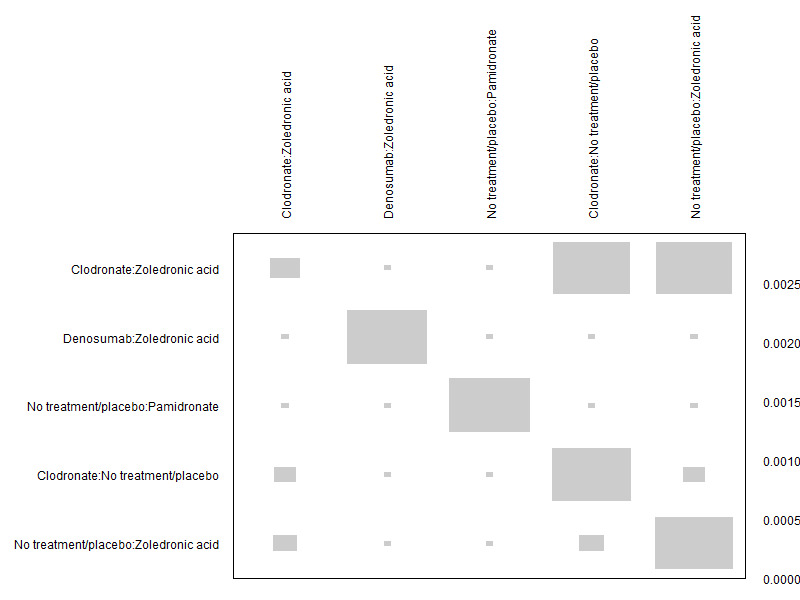
Net heat plot for the outcome skeletal‐related event: radiotherapy (random‐effects model). There are no signs of inconsistency in the net heat plot.
Subgroup analysis
When no treatment and placebo were observed separately, the order of the ranking did not differ (network diagram and data not shown).
mCRPC versus mCSPC
Five of the eight studies that reported SRE radiotherapy included participants with mCRPC (Ernst 2003; Fizazi 2011; Pan 2014; Saad 2010; Small 2003). Network meta‐analysis of only these five studies resulted in a change of the relative ranking of treatment options—clodronate and no treatment/placebo exchanged—according to P‐score compared to ranking in Figure 44 (data not shown). The direction of NMA effect estimates changed for the comparisons of pamidronate with clodronate and no treatment/placebo with clodronate, and effect estimates and confidence intervals only changed slightly without impact on interpretations, meaning that still only for the comparison of denosumab with no treatment/placebo do confidence intervals suggest evidence for a difference in effectiveness to prevent the SRE radiotherapy.
Two studies included participants with mCSPC (PR05; Wang 2013). Network meta‐analysis of only these two studies resulted in no change of the relative ranking only consisting of zoledronic acid, clodronate, and no treatment/placebo according to P‐score compared to ranking in Figure 44 (data not shown). The direction of NMA effect estimates did not change. The NMA effect estimate and confidence intervals of the comparison zoledronic acid and no treatment/placebo do not suggest evidence for a difference any longer.
Pairwise meta‐analysis
Only one study reported a comparison with denosumab (Fizazi 2011), therefore no pairwise meta‐analysis was conducted.
Secondary outcome: SRE: surgery
Network meta‐analysis
Seven studies reported the SRE surgery (Fizazi 2011; Pan 2014; Saad 2010; Small 2003; TRAPEZE 2016; Wang 2013; ZABTON‐PC), of which Pan 2014 reported zero events in both study arms and was therefore excluded from the statistical analysis. The network diagram is presented in Figure 47. The network includes 3848 participants. Treatments considered were zoledronic acid, denosumab, clodronate, and pamidronate, as well as the main comparator no treatment/placebo. There is no closed loop.
47.
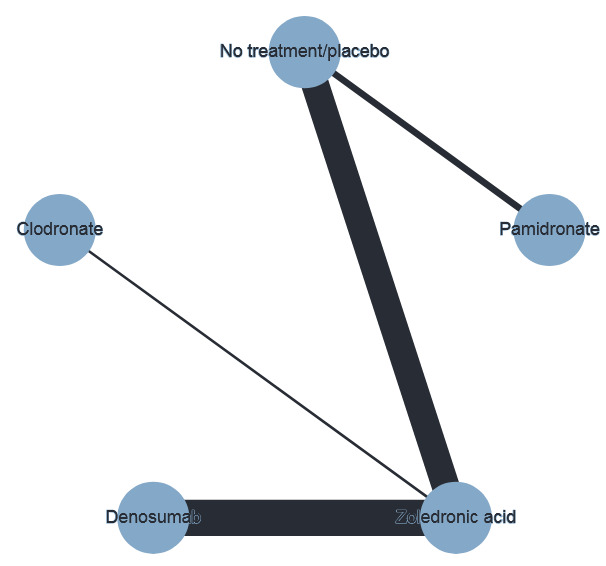
Network diagram for the outcome skeletal‐related event: bone surgery. Any two treatments are connected by a line when there is at least one study comparing the two treatments. Line width: number of participants.
Compared to no treatment/placebo, treatment with zoledronic acid may reduce the need for surgery to the bone slightly (RR 0.45, 95% CI 0.23 to 0.88). Treatment with denosumab (RR 0.11, 95% CI 0.01 to 1.14), clodronate (RR 0.15, 95% CI 0.01 to 4.01), and pamidronate (RR 0.89, 95% CI 0.27 to 2.97) may result in little to no difference in reducing the need for bone surgery (Figure 48; Figure 49). By comparing the different bone‐modifying agents with each other, no differences between the four active treatments are shown (Figure 49).
48.
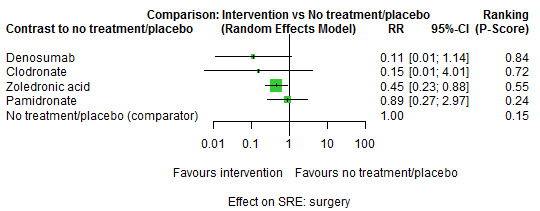
Forest plot for the outcome skeletal‐related event: surgery. Random‐effects model. Reference treatment: no treatment/placebo. Treatments are ordered by P‐score (descending). The fixed‐effect model yields slightly different confidence intervals (Figure 50).
49.
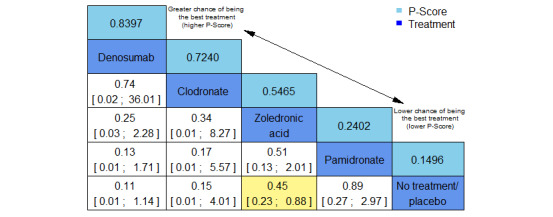
Leaguetable of network meta‐analysis for the outcome skeletal‐related event: surgery. Treatment options are ranked as indicated by the arrow from top: greater chance of being the best treatment (higher P‐scores) to bottom: lower chance of being the best treatment (lower P‐score). Network estimates with 95% confidence intervals indicating an effect between two of the treatment options are marked in yellow: treatment option in column better than treatment option in row. Global approach to check inconsistency/heterogeneity: Q‐statistics, I2.
No. of studies: 6. No. of treatments: 5. No. of pairwise comparisons: 6. No. of designs: 4
Heterogeneity/inconsistency: Qtotal = 2.11, P = 0.35; I2 = 5.3%, Tau2 = 0.0216
Treatment effects + 95% confidence intervals (risk ratios, random‐effects model)
Ranking according to P‐scores indicates denosumab as the best treatment option followed by clodronate, zoledronic acid, and pamidronate (Figure 48; Figure 49). The fixed‐effect model yields slightly different confidence intervals than the random‐effects model (Figure 50). For the SRE bone surgery, data were not sufficient to estimate prediction intervals.
50.
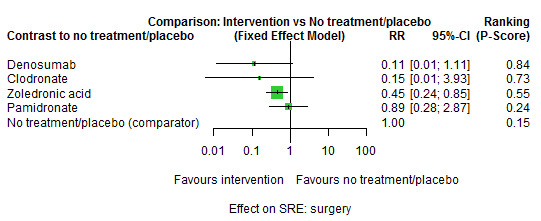
Forest plot for outcome skeletal‐related event (SRE): surgery. Fixed‐effect model. Reference treatment: no treatment/placebo. Treatments are ordered by P‐score (descending). Since there are no closed loops in the network, no local approach to check inconsistency was conducted.
In the entire network, generalized heterogeneity statistic Q and generalized I2 statistic showed no notable inconsistency between studies (Qtotal = 2.11, P = 0.35; I2 = 5.3%, Tau2 = 0.0216). Since there are no closed loops in the network, no local approach to check inconsistency could be conducted.
Subgroup analysis
When no treatment and placebo were observed separately, the order of the ranking did not differ (network diagram and data not shown).
mCRPC versus mCSPC
Four of the six studies that reported SRE surgery included participants with mCRPC (Fizazi 2011; Pan 2014; Saad 2010; Small 2003). Network meta‐analysis of only these five studies resulted in no change of the relative ranking of treatment options according to P‐score compared to ranking in Figure 49 (data not shown). The direction of NMA effect estimates did not change. The confidence interval of the effect estimate comparing zoledronic acid and no treatment/placebo includes the line of no‐effect and therefore suggests no evidence for a difference any longer. I2 rose from 5.3% to 52.1%, suggesting far higher inconsistency within the comparison.
One study included mCSPC participants (Wang 2013). No analysis could be performed regarding this subgroup.
Pairwise meta‐analysis
Only one study reported a comparison with denosumab (Fizazi 2011), therefore no pairwise meta‐analysis was conducted.
Secondary outcome: SRE: hypercalcemia
Network meta‐analysis
Five studies reported the SRE hypercalcemia (Fizazi 2009; Pan 2014; Small 2003; TRAPEZE 2016; Wang 2013), of which Fizazi 2009 reported zero events in both arms and could therefore not be incorporated in the statistical analysis. The network diagram is presented in Figure 51. The network includes 1349 participants. Treatments considered were zoledronic acid, clodronate, and pamidronate, as well as the main comparator no treatment/placebo. There is no closed loop.
51.
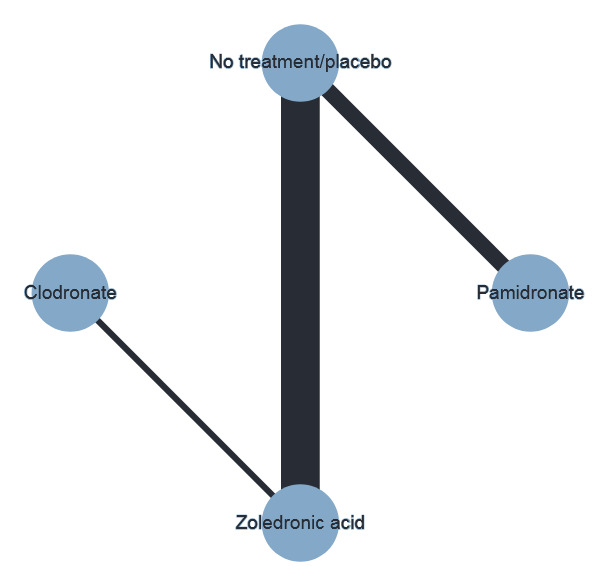
Network diagram for the outcome skeletal‐related event: hypercalcemia. Any two treatments are connected by a line when there is at least one study comparing the two treatments. Line width: number of participants.
Compared to no treatment/placebo, treatment with zoledronic acid (RR 0.48, 95% CI 0.06 to 3.69), pamidronate (RR 0.54, 95% CI 0.05 to 5.85), and clodronate (RR 0.98, 95% CI 0.04 to 22.37) may result in little to no difference in hypercalcemia (Figure 52; Figure 53). By comparing the different bone‐modifying agents with each other, no differences between the three active treatments were shown (Figure 53).
52.
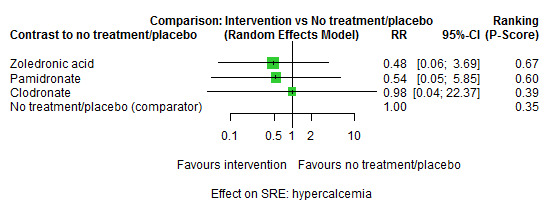
Forest plot for the outcome skeletal‐related event (SRE): hypercalcemia. Random‐effects model. Reference treatment: no treatment/placebo. Treatments are ordered by P‐score (descending). The fixed‐effect model yields similar results. Since there are no closed loops in the network, no local approach to check inconsistency was conducted.
53.

Leaguetable of network meta‐analysis for the outcome skeletal‐related event: hypercalcemia. Treatment options are ranked as indicated by the arrow from top: greater chance of being the best treatment (higher P‐scores) to bottom: lower chance of being the best treatment (lower P‐score). Network estimates with 95% confidence intervals indicating an effect between two of the treatment options would have been marked in yellow: treatment option in column better than treatment option in row. Global approach to check inconsistency/heterogeneity: Q‐statistics, I2.
No. of studies: 4. No. of treatments: 4. No. of pairwise comparisons: 4. No. of designs: 3
Heterogeneity / inconsistency: Qtotal = 0.57, P = 0.45; I2 = 0.0%, Tau2 = 0
Treatment effects + 95% confidence intervals (risk ratios, random‐effects model)
Ranking according to P‐scores indicate zoledronic acid and pamidronate as the best treatment option followed by clodronate (Figure 52; Figure 53). The fixed‐effect model yields similar results (data not shown). For the SRE hypercalcemia, data were not sufficient to estimate prediction intervals.
In the entire network, generalized heterogeneity statistic Q and generalized I2 statistic showed no notable inconsistency between studies (Qtotal = 0.57, P = 0.45; I2 = 0.0%, Tau2 = 0). Since there were no closed loops in the network, no local approach to check inconsistency could be conducted.
Subgroup analysis
When no treatment and placebo were observed separately, the network split in two subnetworks without connection, therefore a statement on differences by observing them separately was not possible.
mCRPC versus mCSPC
Three of the four studies that reported SRE hypercalcemia included participants with mCRPC (Pan 2014; Small 2003; TRAPEZE 2016). Network meta‐analysis of only these three studies resulted in no change of the relative ranking of treatment options according to P‐score compared to ranking in Figure 53 (data not shown). The direction of NMA effect estimates did not change, and effect estimates and confidence intervals were only changed slightly without impact on interpretations.
One study included mCSPC participants (Wang 2013). No analysis could be performed regarding this subgroup.
Secondary outcome: mortality
Network meta‐analysis
Thirteen studies reported mortality (CALGB 90202; Elomaa 1992; Ernst 2003; Fizazi 2011; GU02‐4; Kylmala 1993; Meulenbeld 2012; PR05; Saad 2010; Small 2003; STAMPEDE; Wang 2013; ZABTON‐PC), all of which were included in the statistical analysis. The network diagram is presented in Figure 54. The network includes 5494 participants. Treatments considered were zoledronic acid, denosumab, clodronate, risedronate, and pamidronate, as well as the main comparator no treatment/placebo. There is one closed loop.
54.
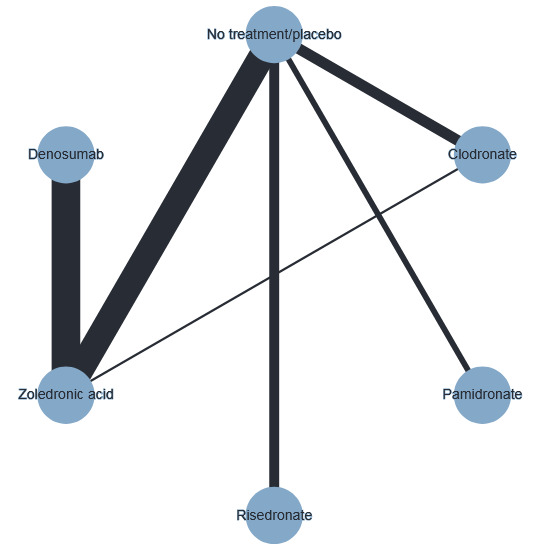
Network diagram for the outcome mortality. Any two treatments are connected by a line when there is at least one study comparing the two treatments. Line width: number of participants.
Compared to no treatment/placebo, treatment with zoledronic acid (RR 0.90, 95% CI 0.80 to 1.01; moderate‐certainty evidence), denosumab (RR 0.93, 95% CI 0.77 to 1.11; moderate‐certainty evidence), clodronate (RR 0.94, 95% CI 0.86 to 1.03; moderate‐certainty evidence), pamidronate (RR 0.90, 95% CI 0.53 to 1.53), and risedronate (RR 1.06, 95% CI 0.97 to 1.17) probably do not decrease mortality (Figure 55; Figure 56). By comparing the different bone‐modifying agents with each other, a difference was shown between zoledronic acid and risedronate in favor of zoledronic acid (RR 0.85, 95% 0.73 to 0.98) (Figure 56).
55.
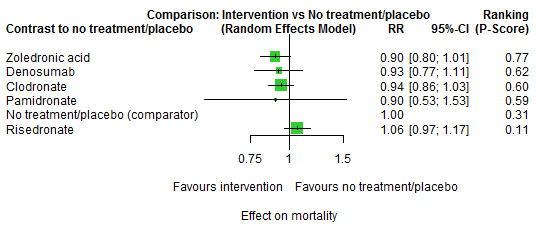
Forest plot for the outcome mortality. Random‐effects model. Reference treatment: no treatment/placebo. Treatments are ordered by P‐score (descending). The fixed‐effect model yields similar results.
56.
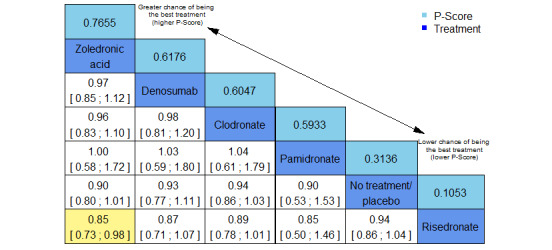
Leaguetable of network meta‐analysis for the outcome mortality. Treatment options are ranked as indicated by the arrow from top: greater chance of being the best treatment (higher P‐scores) to bottom: lower chance of being the best treatment (lower P‐score). Network estimates with 95% confidence intervals indicating an effect between two of the treatment options are marked in yellow: treatment option in column better than treatment option in row. Global approach to check inconsistency/heterogeneity: Q‐statistics, I2.
No. of studies: 13. No. of treatments: 6. No. of pairwise comparisons: 13. No. of designs: 6
Qtotal = 3.35, P = 0.91/Qwithin = 3.15, P = 0.87/Qbetween = 0.20, P = 0.65; I2 = 0.0%, Tau2 = 0
Treatment effects + 95% confidence intervals (risk ratios, random‐effects model)
Ranking according to P‐scores indicates zoledronic acid as the best treatment option followed by denosumab, clodronate, pamidronate, no treatment/placebo, and risedronate (Figure 55; Figure 56). Prediction intervals, to be interpreted as the 95% range of true RR to be expected in similar future trials, are given in Figure 57; related leaguetables with prediction intervals are shown in Table 9. The fixed‐effect model yields similar results (data not shown).
57.
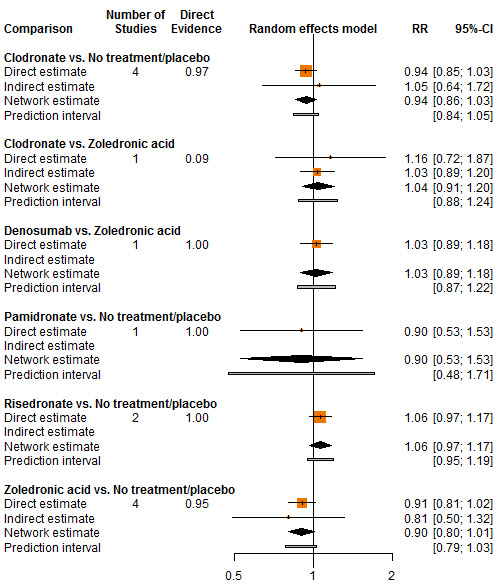
Forest plot of splitting direct and indirect evidence for the outcome mortality. In addition to the confidence interval for the network estimator, a prediction interval is shown. Local approach to check inconsistency—comparison of direct and indirect estimate for closed loops. As presented in Figure 54, there is one closed loop in the network (zoledronic acid—clodronate—no treatment/placebo). There is no significant difference between direct and indirect estimate (P value of test for disagreement: P = 0.654).
8. Results of network meta‐analysis for outcome mortality. Prediction intervals. Treatments are ordered by P‐score (descending).
| 95% prediction intervals (risk ratios, random‐effects model) | |||||
| Zoledronic acid | [ 0.87, 1.22 ] | [ 0.88, 1.24 ] | [ 0.52, 1.93 ] | [ 0.97, 1.27 ] | [ 0.99, 1.41 ] |
| [ 0.82, 1.15 ] | Denosumab | [ 0.8, 1.29 ] | [ 0.5, 1.92 ] | [ 0.87, 1.34 ] | [ 0.9, 1.47 ] |
| [ 0.81, 1.14 ] | [ 0.77, 1.25 ] | Clodronate | [ 0.5, 1.84 ] | [ 0.95, 1.19 ] | [ 0.96, 1.32 ] |
| [ 0.52, 1.92 ] | [ 0.52, 2.02 ] | [ 0.54, 2 ] | Pamidronate | [ 0.58, 2.1 ] | [ 0.61, 2.26 ] |
| [ 0.79, 1.03 ] | [ 0.75, 1.15 ] | [ 0.84, 1.05 ] | [ 0.48, 1.71 ] | No treatment/placebo | [ 0.95, 1.19 ] |
| [ 0.71, 1.01 ] | [ 0.68, 1.11 ] | [ 0.75, 1.04 ] | [ 0.44, 1.63 ] | [ 0.84, 1.06 ] | Risedronate |
In the entire network, generalized heterogeneity statistic Qtotal and generalized I2 statistic showed no notable inconsistency between studies (Qtotal = 3.35, P = 0.91/Qwithin = 3.15, P = 0.87/Qbetween = 0.20, P = 0.65; I2 = 0.0%, Tau2 = 0). Net heat plot also shows negligible signs of inconsistency (Figure 58). The splitting into the contribution of direct and indirect evidence reveals the same results; test of agreement between direct and indirect evidence does not find local inconsistency for the closed loop (P = 0.65, Figure 57).
58.
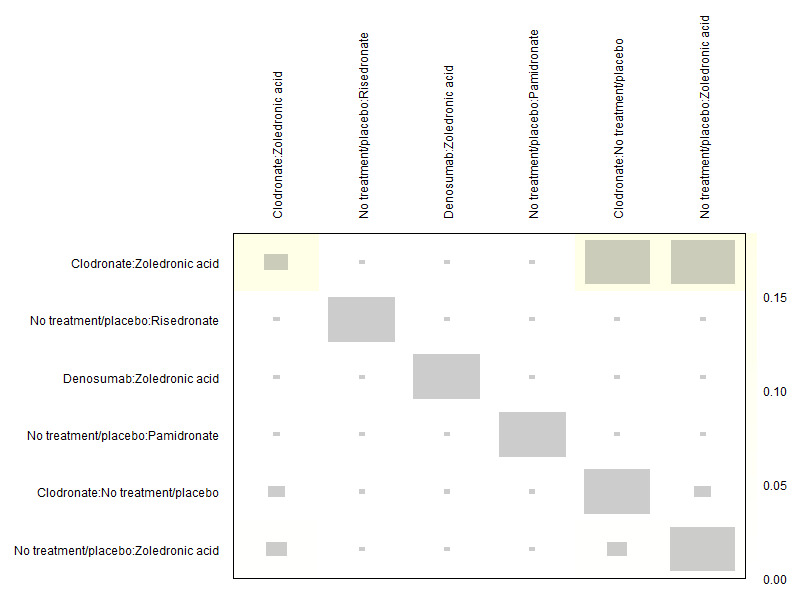
Net heat plot for outcome mortality (random‐effects model). There are negligible signs of inconsistency in the net heat plot.
Subgroup analysis
When no treatment and placebo were observed separately, the order of the ranking differed, but the results suggest no evidence for a difference between the different treatment options (network diagram and data not shown).
mCRPC versus mCSPC
Seven of the 13 studies that reported mortality included participants with mCRPC (CALGB 90202; Ernst 2003; Fizazi 2011; Kylmala 1993; Meulenbeld 2012; Saad 2010; Small 2003). Network meta‐analysis of only these seven studies resulted in a change of the relative ranking of treatment options ‐ clodronate and pamidronate exchanged ‐ according to P‐score compared to ranking in Figure 56 (data not shown). The direction of NMA effect estimates did not change. The confidence interval of the effect estimate comparing zoledronic acid and no treatment/placebo includes the line of no‐effect and therefore suggests no evidence for a difference between the two any longer.
Two studies included participants with mCSPC (PR05; Wang 2013). Network meta‐analysis of only these two studies resulted in no change of the relative ranking only consisting of zoledronic acid, clodronate, and no treatment/placebo according to P‐score compared to ranking in Figure 56 (data not shown). The direction of NMA effect estimates did not change. The confidence interval of the effect estimate comparing zoledronic acid and no treatment/placebo includes the line of no‐effect and therefore suggests no evidence for a difference between the two any longer.
Sensitivity analysis
We included nine studies with low risk of bias in sensitivity analysis (CALGB 90202; Elomaa 1992; Ernst 2003; Fizazi 2011; GU02‐4; Kylmala 1993; PR05; Saad 2010; STAMPEDE; Wang 2013). The network diagram is not shown. The network includes 4088 participants. Treatments considered were zoledronic acid, denosumab, clodronate, and risedronate, as well as the main comparator no treatment/placebo. There is one closed loop.
Compared to no treatment/placebo, treatment with zoledronic acid (RR 0.88, 95% CI 0.76 to 1.02), denosumab (RR 0.90, 95% CI 0.74 to 1.11), clodronate (RR 0.94, 95% CI 0.86 to 1.03), and risedronate (RR 0.97, 95% CI 0.38 to 2.44) probably results in no difference in mortality (Figure 59; Figure 60). By comparing the different bone‐modifying agents with each other, no differences between the four active treatments were shown (Figure 60).
59.

Forest plot for sensitivity analysis of outcome: mortality (low risk of bias (RoB)). Random‐effects model. Reference treatment: no treatment/placebo. Treatments are ordered by P‐score (descending). The fixed‐effect model yields similar results.
60.
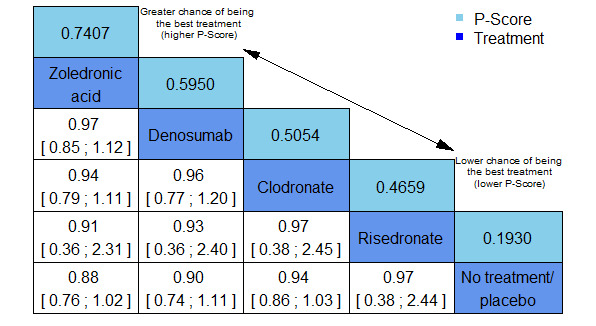
Leaguetable of sensitivity network meta‐analysis including only studies with low risk of bias for the outcome mortality. Treatment options are ranked as indicated by the arrow from top: greater chance of being the best treatment (higher P‐scores) to bottom: lower chance of being the best treatment (lower P‐score). Network estimates with 95% confidence intervals indicating an effect between two of the treatment options would have been marked in yellow: treatment option in column better than treatment option in row. Global approach to check inconsistency/heterogeneity: Q‐statistics, I2.
No. of studies: 9. No. of treatments: 5. No. of pairwise comparisons: 9. No. of designs: 5
Qtotal = 2.98, P = 0.70/Qwithin = 2.85, P = 0.58/Qbetween = 0.13, P = 0.72; I2 = 0%, Tau2 = 0
Treatment effects + 95% confidence intervals (risk ratios, random‐effects model)
Ranking according to P‐scores indicates zoledronic acid as the best treatment option followed by denosumab, clodronate, and risedronate (Figure 59; Figure 60). Prediction intervals, to be interpreted as the 95% range of true RR to be expected in similar future trials, are given in Figure 61; related leaguetables with prediction intervals are shown in Table 10. The fixed‐effect model yields similar results (data not shown).
61.
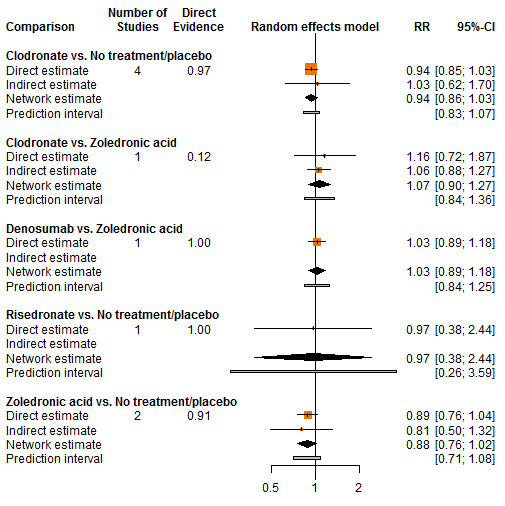
Forest plot for sensitivity analysis of splitting direct and indirect evidence for the outcome mortality (low risk of bias). In addition to the confidence interval for the network estimator, a prediction interval is shown.
Local approach to check inconsistency—comparison of direct and indirect estimate for closed loops. There is one closed loop in the network (graph not shown; zoledronic acid—clodronate—no treatment/placebo). There is no significant difference between direct and indirect estimate (P value of test for disagreement: P = 0.721).
9. Results of sensitivity network meta‐analysis for the outcome mortality (low risk of bias). Prediction intervals. Treatments are ordered by P‐score (descending). Only subnetworks with > 1 design.
| 95% prediction intervals (risk ratios, random‐effects model) | ||||
| Zoledronic acid | [ 0.84, 1.25 ] | [ 0.84, 1.36 ] | [ 0.29, 4.15 ] | [ 0.92, 1.4 ] |
| [ 0.8, 1.19 ] | Denosumab | [ 0.76, 1.42 ] | [ 0.28, 4.09 ] | [ 0.83, 1.48 ] |
| [ 0.74, 1.19 ] | [ 0.71, 1.31 ] | Clodronate | [ 0.28, 3.84 ] | [ 0.94, 1.21 ] |
| [ 0.24, 3.42 ] | [ 0.24, 3.56 ] | [ 0.26, 3.61 ] | Risedronate | [ 0.28, 3.82 ] |
| [ 0.71, 1.08 ] | [ 0.68, 1.21 ] | [ 0.83, 1.07 ] | [ 0.26, 3.59 ] | No treatment/placebo |
In the entire network, generalized heterogeneity statistic Qtotal and generalized I2 statistic showed no notable inconsistency between studies (Qtotal = 2.98, P = 0.70/Qwithin = 2.85, P = 0.58/Qbetween = 0.13, P = 0.72; I2 = 0%, Tau2 = 0). Net heat plot also shows negligible signs of inconsistency (Figure 62). The splitting into the contribution of direct and indirect evidence reveals the same results; test of agreement between direct and indirect evidence does not find local inconsistency for the closed loop (P = 0.72, Figure 61).
62.
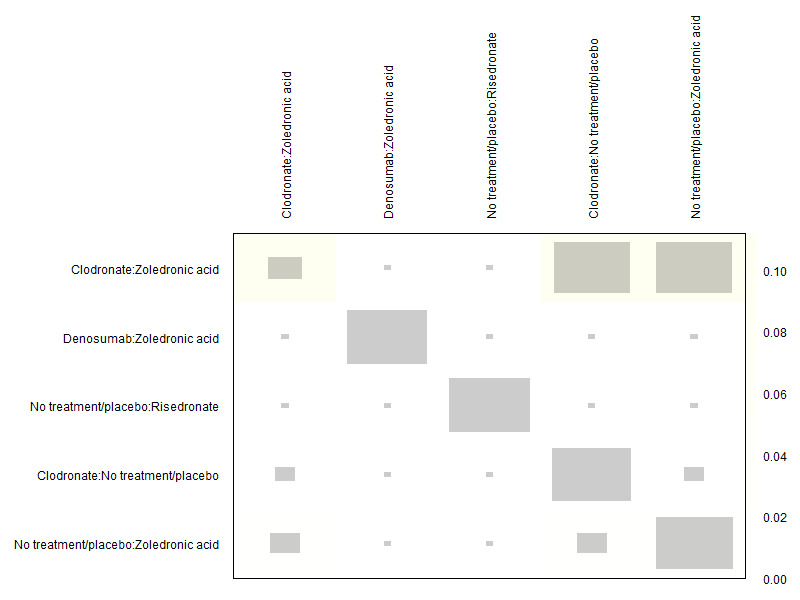
Net heat plot for sensitivity analysis of the outcome mortality (low risk of bias; random‐effects model). There are negligible signs of inconsistency in the net heat plot. The fixed‐effect model yields the same results.
Pairwise meta‐analysis
Only one study reported a comparison with denosumab (Fizazi 2011), therefore no pairwise meta‐analysis was conducted.
Secondary outcome: quality of life
Due to insufficient reporting, no analysis was possible for the outcome quality of life. Descriptive results of this outcome regarding bisphosphonates were already reported elsewhere (Macherey 2017). One trial analyzing the effects of zoledronic acid and denosumab reported cancer‐related quality of life in an abstract (Fizazi 2011). In this trial, participants completed the Functional Assessment of Cancer Therapy‐General questionnaire at baseline and at each monthly visit to determine cancer‐specific quality of life scores. Declining scores point to worsening cancer‐related quality of life, with a greater than or equal to five‐point decrease considered to be clinically meaningful. Over an 18‐month period, more zoledronic acid‐treated participants than denosumab‐treated participants experienced a greater than or equal to five‐point decrease in Functional Assessment of Cancer Therapy‐General total scores (average relative difference = 6.8%, range −9.4% to 14.6%) or worsening of cancer‐related quality of life.
Secondary outcome: adverse event: grade 3 to 4
Network meta‐analysis
Eight studies reported participants with adverse events grade 3 to 4 (CALGB 90202; Ernst 2003; Figg 2005; Fizazi 2009; Fizazi 2011; Meulenbeld 2012; Small 2003; ZAPCA), all of which are included in the statistical analysis. The network diagram is presented in Figure 63. The network includes 4053 participants. Treatments considered were zoledronic acid, denosumab, clodronate, risedronate, pamidronate, and alendronate, as well as the main comparator no treatment/placebo. There is no closed loop.
63.
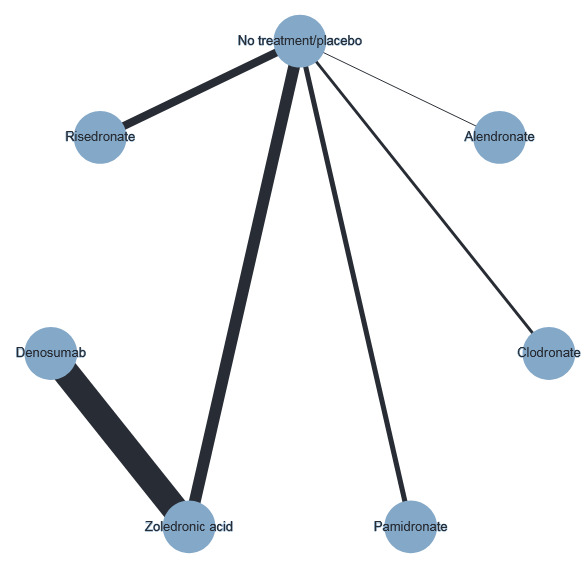
Network diagram for the outcome adverse event: grade 3 to 4. Any two treatments are connected by a line when there is at least one study comparing the two treatments. Line width: number of participants.
Compared to no treatment/placebo, treatment with denosumab may slightly increase grade 3 to 4 adverse events (RR 1.46, 95% CI 1.06 to 1.99). Compared to no treatment/placebo, treatment with zoledronic acid (RR 1.34, 95% CI 0.99 to 1.83), pamidronate (RR 1.20, 95% CI 0.80 to 1.79), alendronate (RR 1.25, 95% CI 0.37 to 4.28), clodronate (RR 1.10, 95% CI 0.81 to 1.50), and risedronate (RR 1.02, 95% CI 0.88 to 1.18) may result in little to no difference in grade 3 to 4 adverse events (Figure 64; Figure 65). By comparing the different bone‐modifying agents with each other, differences were shown between zoledronic acid and denosumab in favor of zoledronic acid (RR 0.92, 95% CI 0.87 to 0.98) and between risedronate and denosumab in favor of risedronate (RR 0.70, 95% CI 0.50 to 0.99) (Figure 65).
64.
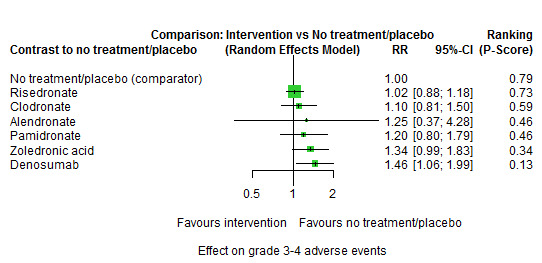
Forest plot for the outcome adverse event: grade 3 to 4. Random‐effects model. Reference treatment: no treatment/placebo. Treatments are ordered by P‐score (descending). The fixed‐effect model yields similar results. Since there are no closed loops in the network, no local approach to check inconsistency was conducted.
65.
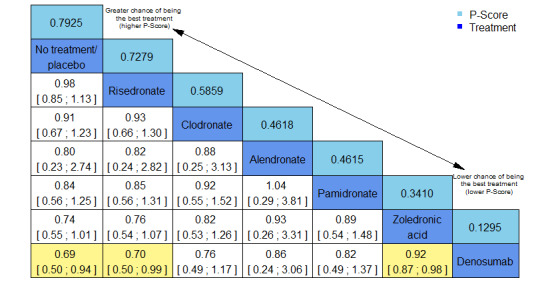
Leaguetable of network meta‐analysis for the outcome adverse event: grade 3 to 4. Treatment options are ranked as indicated by the arrow from top: greater chance of being the best treatment (higher P‐scores) to bottom: lower chance of being the best treatment (lower P‐score). Network estimates with 95% confidence intervals indicating an effect between two of the treatment options are marked in yellow: treatment option in column better than treatment option in row. Global approach to check inconsistency/heterogeneity: Q‐statistics, I2.
No. of studies: 8. No. of treatments: 7. No. of pairwise comparisons: 8. No. of designs: 6
Heterogeneity/inconsistency: Qtotal = 0.44, P = 0.80; I2 = 0.0%, Tau2 = 0
Treatment effects + 95% confidence intervals (risk ratios, random‐effects model)
Ranking according to P‐scores indicates risedronate as the best treatment option after no treatment/placebo followed by clodronate, alendronate, pamidronate, zoledronic acid, and denosumab (Figure 64; Figure 65). The fixed‐effect model yields similar results (data not shown). For grade 3 to 4 adverse events, data were not sufficient to estimate prediction intervals.
In the entire network, generalized heterogeneity statistic Qtotal and generalized I2 statistic showed no notable inconsistency between studies (Qtotal = 0.44, P = 0.80; I2 = 0.0%, Tau2 = 0). A test of agreement between direct and indirect evidence to find local inconsistency could not be conducted since there is no closed loop in the network.
Subgroup analysis
When no treatment and placebo were observed separately, the order of the ranking did differ slightly, but the results suggest no evidence for a difference between the different treatment options (network diagram and data not shown).
mCRPC versus mCSPC
Seven of the eight studies that reported grade 3 to 4 adverse events included participants with mCRPC (CALGB 90202; Ernst 2003; Figg 2005; Fizazi 2009; Fizazi 2011; Meulenbeld 2012; Small 2003). Network meta‐analysis of only these seven studies resulted in no change of the relative ranking of treatment options according to P‐score compared to ranking in Figure 65 (data not shown). The direction of NMA effect estimates did not change. The confidence intervals of the effect estimate comparing denosumab with no treatment/placebo and denosumab with risedronate include the line of no‐effect and therefore suggest no evidence for a difference between each of the two compared treatment options any longer.
No study reported including only participants with mCSPC.
Pairwise meta‐analysis
Two studies reported grade 3 to 4 adverse events for treatment with denosumab (Fizazi 2009; Fizazi 2011). Finally, 628/961 participants in the zoledronic acid arm and 680/976 participants in the denosumab arm experienced grade 3 to 4 adverse events. Treatment with denosumab may increase the occurrence of grade 3 to 4 adverse events compared to zoledronic acid (RR 0.92, 95% CI 0.87 to 0.98; I2 = 0%, Figure 66).
66.

Results of pairwise meta‐analysis for the outcome adverse event: grade 3 to 4 (random‐effects model).
Secondary outcome: adverse event: hypocalcemia
Network meta‐analysis
Nine studies reported hypocalcemia as an adverse event (CALGB 90202; Fizazi 2009; Fizazi 2011; Meulenbeld 2012; Pan 2014; PR05; Saad 2010; Wang 2013; ZABTON‐PC). Two studies with zero events were excluded from the statistical analysis (Pan 2014; ZABTON‐PC). The network diagram is presented in Figure 67. The network includes 4235 participants. Treatments considered were zoledronic acid, denosumab, clodronate, and risedronate, as well as the main comparator no treatment/placebo. There is one closed loop.
67.
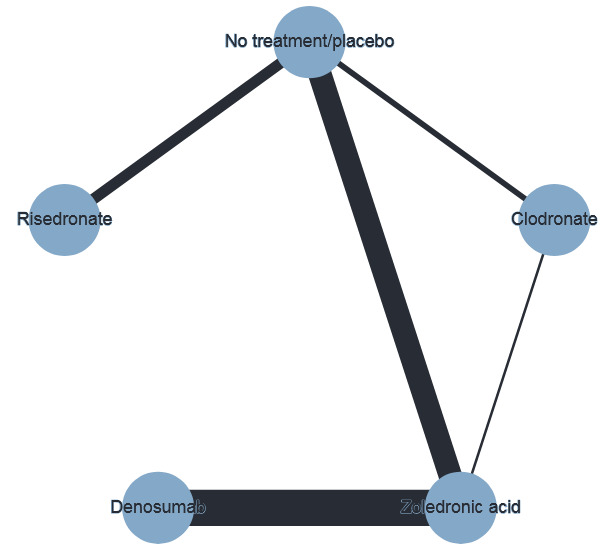
Network diagram for the outcome adverse event: hypocalcemia. Any two treatments are connected by a line when there is at least one study comparing the two treatments. Line width: number of participants.
Compared to no treatment/placebo, treatment with denosumab (RR 5.74, 95% CI 0.57 to 57.43), risedronate (RR 3.10, 95% CI 0.07 to 133.60), zoledronic acid (RR 2.38, 95% CI 0.47 to 11.96), and clodronate (RR 1.97, 95% CI 0.20 to 19.85) may result in little to no difference in the occurrence of hypocalcemia (Figure 68; Figure 69). By comparing the different bone‐modifying agents with each other, no differences between the four active treatments are shown (Figure 69).
68.
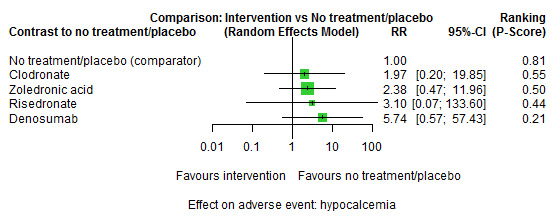
Forest plot for secondary outcome: adverse event: hypocalcemia. Random‐effects model. Reference treatment: no treatment/placebo. Treatments are ordered by P‐score (descending).
There are strong differences between the fixed‐effect and random‐effects estimates and confidence intervals. In addition, the treatments are ranked in a different order (Figure 70).
69.
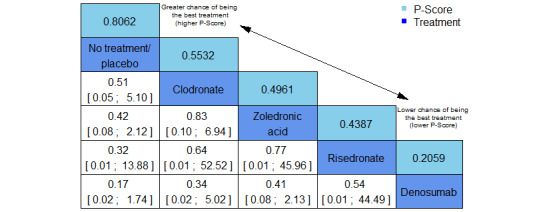
Leaguetable of network meta‐analysis for the outcome adverse event: hypocalcemia. Treatment options are ranked as indicated by the arrow from top: greater chance of being the best treatment (higher P‐scores) to bottom: lower chance of being the best treatment (lower P‐score). Network estimates with 95% confidence intervals indicating an effect between two of the treatment options would have been marked in yellow: treatment option in column better than treatment option in row. Global approach to check inconsistency/heterogeneity: Q‐statistics, I2.
No. of studies: 7. No. of treatments: 5. No. of pairwise comparisons: 7. No. of designs: 5
Qtotal = 6.90, P = 0.075/Qwithin = 2.39, P = 0.30/Qbetween = 4.51, P = 0.034; I2 = 56.5%, Tau2 = 1.0252
Treatment effects + 95% confidence intervals (risk ratios, random‐effects model)
There are strong differences between the fixed‐effect and random‐effects estimates and confidence intervals (Figure 68; Figure 70). In the random‐effects model, ranking according to P‐scores indicates clodronate as the best treatment option after no treatment/placebo, followed very closely by zoledronic acid, and then risedronate and denosumab (Figure 68; Figure 69). In addition, the treatments are ranked in a different order (Figure 70). Prediction intervals, to be interpreted as the 95% range of true RR to be expected in similar future trials, are given in Figure 71; related leaguetables with prediction intervals are shown in Table 11.
70.
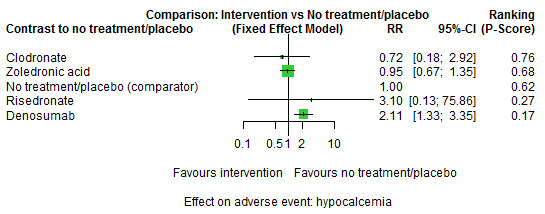
Forest plot for secondary outcome adverse event: hypocalcemia. Fixed‐effect model. Reference treatment: no treatment/placebo. Treatments are ordered by P‐score (descending).
71.
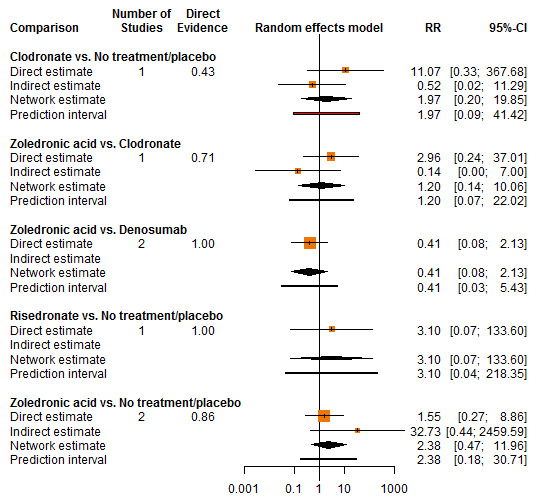
Forest plot of splitting direct and indirect evidence for the secondary outcome adverse event: hypocalcemia. In addition to the confidence interval for the network estimator, a prediction interval is shown. Local approach to check inconsistency—comparison of direct and indirect estimate for closed loops. As presented in Figure 67, there is one closed loop in the network (zoledronic acid—clodronate—no treatment/placebo). There is no significant difference between direct and indirect estimate (P value of test for disagreement: P = 0.20).
10. Results of network meta‐analysis for outcome adverse event: hypocalcemia. Prediction intervals. Treatments are ordered by P‐score (descending).
| 95% prediction intervals (risk ratios, random‐effects model) | ||||
| No treatment/placebo | [ 0, 1576.09 ] | [ 0.01, 654.71 ] | [ 0, 35260.46 ] | [ 0.01, 4541.37 ] |
| [ 0, 405.24 ] | Clodronate | [ 0, 710.22 ] | [ 0, 64752 ] | [ 0, 4419.4 ] |
| [ 0, 116.04 ] | [ 0, 489.59 ] | Zoledronic acid | [ 0, 28482.19 ] | [ 0.01, 688.08 ] |
| [ 0, 3662.25 ] | [ 0, 26156.52 ] | [ 0, 16690.04 ] | Risedronate | [ 0, 75668.22 ] |
| [ 0, 137.66 ] | [ 0, 521.01 ] | [ 0, 117.67 ] | [ 0, 22083.49 ] | Denosumab |
In the entire network, generalized heterogeneity statistic Qtotal and generalized I2 statistic showed moderate inconsistency between studies (Qtotal = 6.90, P = 0.075/Qwithin = 2.39, P = 0.30/Qbetween = 4.51, P = 0.034; I2 = 56.5%, Tau2 = 1.0252). Net heat plot also shows signs of inconsistency in the comparison clodronate versus no treatment/placebo (Figure 72). The fixed‐effect model shows inconsistency a little bit stronger (not shown). The splitting into the contribution of direct and indirect evidence reveals the same results: test of agreement between direct and indirect evidence does not find local inconsistency for the closed loop (P = 0.20, Figure 71).
72.
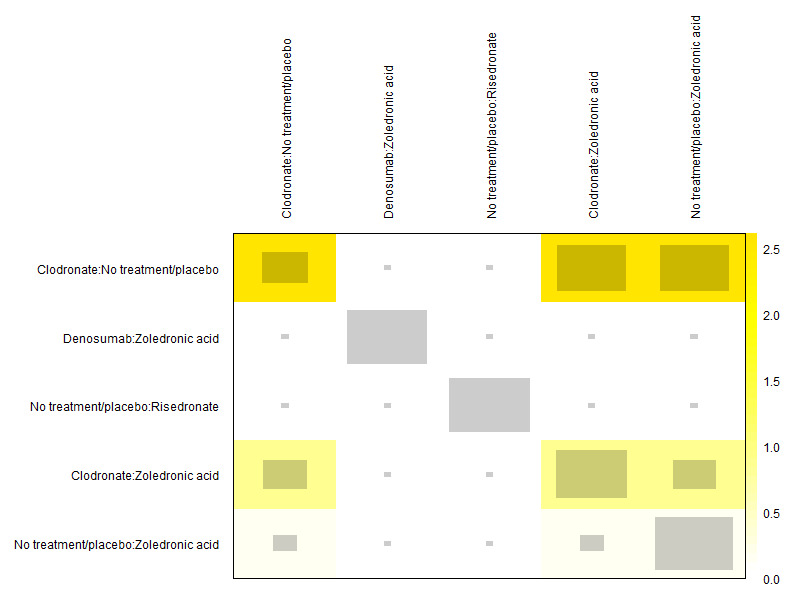
Net heat plot for secondary outcome adverse event: hypocalcemia (random‐effects model). There are signs of inconsistency in the net heat plot in the comparison clodronate versus no treatment/placebo. The fixed‐effect model shows even stronger inconsistency (not shown).
Subgroup analysis
When no treatment and placebo were observed separately, the network split in two subnetworks without connection, therefore a statement on differences by observing them separately is not possible (network diagram not shown).
mCRPC versus mCSPC
Five of the seven studies that reported the adverse event hypocalcemia included participants with mCRPC (CALGB 90202; Fizazi 2009; Fizazi 2011; Meulenbeld 2012; Saad 2010). Network meta‐analysis of only these five studies resulted in no change of the relative ranking of treatment options according to P‐score compared to ranking in Figure 69 (data not shown). The direction of NMA effect estimates changed slightly for the comparison denosumab versus risedronate. The confidence interval of the effect estimate comparing zoledronic acid and denosumab now excludes the line of no‐effect and therefore suggests evidence for a difference between the two favoring zoledronic acid.
Two studies included participants with mCSPC (PR05; Wang 2013). Network meta‐analysis of only these two studies resulted in no change of the relative ranking only consisting of zoledronic acid, clodronate, and no treatment/placebo according to P‐score compared to ranking in Figure 69 (data not shown). The direction of NMA effect estimates did not change. The confidence interval of the effect estimate comparing zoledronic acid and no treatment/placebo now excludes the line of no‐effect and therefore suggests evidence for a difference between the two favoring no treatment/placebo.
Pairwise meta‐analysis
Two studies reported hypocalcemia as an adverse event of treatment with denosumab (Fizazi 2009; Fizazi 2011). Eventually, 56/961 participants in the zoledronic acid arm and 127/976 participants in the denosumab arm experienced hypocalcemia. Treatment with denosumab may increase the occurrence of hypocalcemia compared to zoledronic acid (RR 0.45, 95% CI 0.33 to 0.61; I2 = 0%, Figure 73).
73.

Results of pairwise meta‐analysis for secondary outcome adverse event: hypocalcemia (random‐effects model).
Secondary outcome: adverse event: fatigue
Network meta‐analysis
Seven studies reported on participants experiencing fatigue (CALGB 90202; Figg 2005; Fizazi 2011; Pan 2014; Saad 2010; Small 2003; TRAPEZE 2016), all of which are included in the statistical analysis. All of these studies included participants with mCRPC only. The network diagram is presented in Figure 74. The network includes 4454 participants. Treatments considered were zoledronic acid, denosumab, pamidronate, and alendronate, as well as the main comparator no treatment/placebo. There is no closed loop.
74.
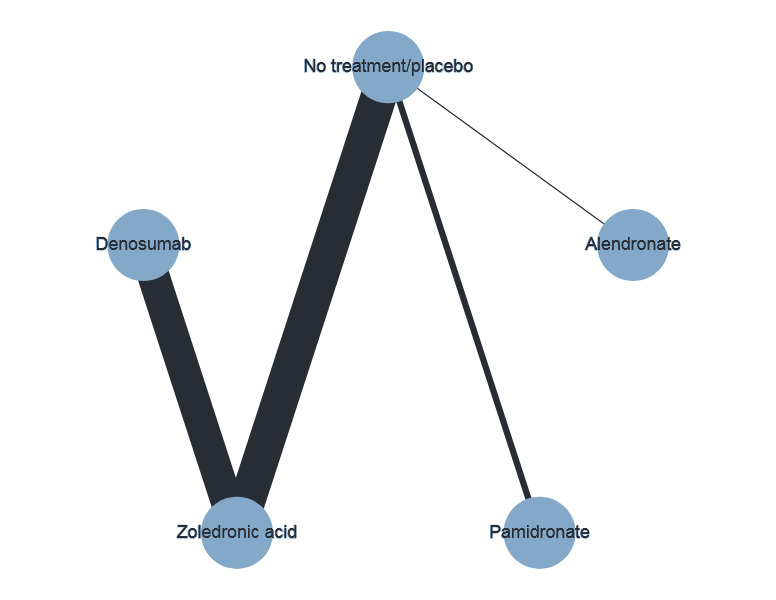
Network diagram for secondary outcome adverse event: fatigue. Any two treatments are connected by a line when there is at least one study comparing the two treatments. Line width: number of participants.
Compared to no treatment/placebo, treatment with alendronate (RR 0.86, 95% CI 0.56 to 1.31), zoledronic acid (RR 1.07, 95% CI 0.91 to 1.24), pamidronate (RR 1.26, 95% CI 0.85 to 1.87), and denosumab (RR 1.24, 95% CI 0.99 to 1.54) may result in little to no difference in fatigue (Figure 75; Figure 76). By comparing the different bone‐modifying agents with each other, no differences between the four active treatments are shown (Figure 76).
75.
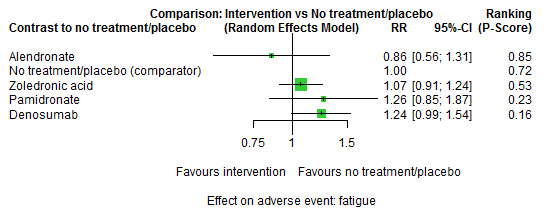
Forest plot for the secondary outcome adverse event: fatigue. Random‐effects model. Reference treatment: no treatment/placebo. Treatments are ordered by P‐score (descending). The fixed‐effect model yields similar results.
76.
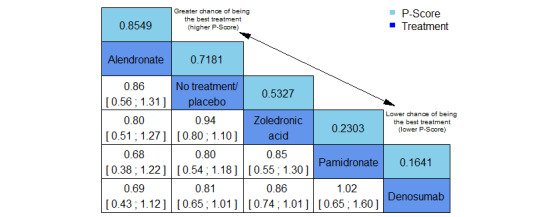
Leaguetable of network meta‐analysis for the outcome adverse event: fatigue. Treatment options are ranked as indicated by the arrow from top: greater chance of being the best treatment (higher P‐scores) to bottom: lower chance of being the best treatment (lower P‐score). Network estimates with 95% confidence intervals indicating an effect between two of the treatment options would have been marked in yellow: treatment option in column better than treatment option in row. Global approach to check inconsistency/heterogeneity: Q‐statistics, I2.
No. of studies: 7. No. of treatments: 5. No. of pairwise comparisons: 7. No. of designs: 4
Heterogeneity/inconsistency: Qtotal = 2.36, P = 0.50; I2 = 0.0%, Tau2 = 0
Treatment effects + 95% confidence intervals (risk ratios, random‐effects model)
Ranking according to P‐scores indicates alendronate as the best treatment option followed by no treatment/placebo, zoledronic acid, pamidronate, and denosumab (Figure 75; Figure 76). The fixed‐effect model yields similar results (data not shown). Prediction intervals, to be interpreted as the 95% range of true RR to be expected in similar future trials, are given in Table 12.
11. Results of network meta‐analysis for outcome adverse event: fatigue. Prediction intervals. Treatments are ordered by P‐score (descending).
| 95% prediction intervals (risk ratios, random‐effects model) | ||||
| Alendronate | [ 0.46, 2.98 ] | [ 0.46, 3.37 ] | [ 0.41, 5.28 ] | [ 0.5, 4.14 ] |
| [ 0.34, 2.19 ] | No treatment/placebo | [ 0.76, 1.5 ] | [ 0.53, 3 ] | [ 0.76, 2 ] |
| [ 0.3, 2.18 ] | [ 0.67, 1.32 ] | Zoledronic acid | [ 0.46, 3 ] | [ 0.83, 1.63 ] |
| [ 0.19, 2.45 ] | [ 0.33, 1.9 ] | [ 0.33, 2.16 ] | Pamidronate | [ 0.36, 2.66 ] |
| [ 0.24, 1.99 ] | [ 0.5, 1.31 ] | [ 0.61, 1.21 ] | [ 0.38, 2.75 ] | Denosumab |
In the entire network, generalized heterogeneity statistic Qtotal and generalized I2 statistic showed no notable inconsistency between studies (Qtotal = 2.36, P = 0.50; I2 = 0.0%, Tau2 = 0). A test of agreement between direct and indirect evidence to find local inconsistency could not be conducted since there is no closed loop in the network.
Subgroup analysis
When no treatment and placebo were observed separately, the order of the ranking did not differ, but when compared to placebo denosumab may result in an increased occurrence of fatigue (RR 0.78, 95% CI 0.62 to 0.89; network diagram and data not shown).
Secondary outcome: adverse event: diarrhea
Network meta‐analysis
Six studies reported participants experiencing diarrhea (CALGB 90202; Figg 2005; Fizazi 2009; Meulenbeld 2012; Saad 2010; Small 2003), all of which are included in the statistical analysis. All of these studies included participants with mCRPC only. The network diagram is presented in Figure 77. The network includes 2345 participants. Treatments considered were zoledronic acid, denosumab, pamidronate, risedronate, and alendronate, as well as the main comparator no treatment/placebo. There is no closed loop.
77.
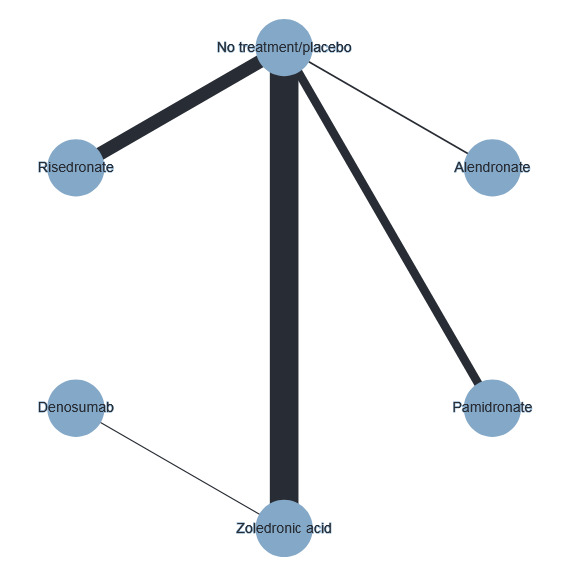
Network diagram for the secondary outcome adverse event: diarrhea. Any two treatments are connected by a line when there is at least one study comparing the two treatments. Line width: number of participants.
Compared to no treatment/placebo, treatment with zoledronic acid (RR 1.58, 95% CI 1.04 to 2.39) may increase diarrhea slightly. Treatment with risedronate (RR 1.11, 95% CI 0.78 to 1.59), alendronate (RR 1.29, 95% CI 0.51 to 3.21), pamidronate (RR 1.32, 95% CI 0.69 to 2.52), and denosumab (RR 3.82, 95% CI 0.46 to 31.91) may result in little to no difference in diarrhea (Figure 78; Figure 79). By comparing the different bone‐modifying agents with each other, no differences between the five active treatments are shown (Figure 79).
78.
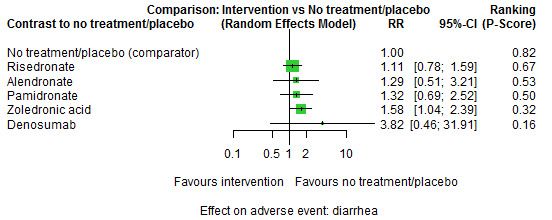
Forest plot for secondary outcome adverse event: diarrhea. Random‐effects model. Reference treatment: no treatment/placebo. Treatments are ordered by P‐score (descending). There are slight differences between the fixed‐effect and random‐effects estimates and confidence intervals (Figure 80).
79.
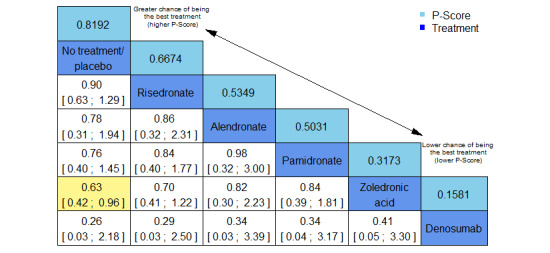
Leaguetable of network meta‐analysis for the outcome adverse event: diarrhea. Treatment options are ranked as indicated by the arrow from top: greater chance of being the best treatment (higher P‐scores) to bottom: lower chance of being the best treatment (lower P‐score). Network estimates with 95% confidence intervals indicating an effect between two of the treatment options are marked in yellow: treatment option in column better than treatment option in row. Global approach to check inconsistency/heterogeneity: Q‐statistics, I2.
No. of studies: 6. No. of treatments: 6. No. of pairwise comparisons: 6. No. of designs: 5
Heterogeneity/inconsistency: Qtotal = 1.23, P = 0.27; I2 = 18.7%, Tau2 = 0.0197
Treatment effects + 95% confidence intervals (risk ratios, random‐effects model)
Ranking according to P‐scores indicates risedronate as the best treatment option after no treatment/placebo followed by alendronate, pamidronate, zoledronic acid, and denosumab (Figure 78; Figure 79). The fixed‐effect model yields slightly different results (Figure 80). For the adverse event diarrhea, data were not sufficient to estimate prediction intervals.
80.
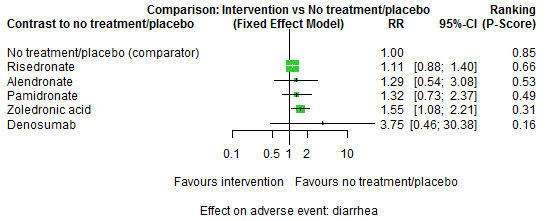
Forest plot for secondary outcome adverse event: diarrhea. Fixed‐effect model. Reference treatment: No treatment/placebo. Treatments are ordered by P‐score (descending).
In the entire network, generalized heterogeneity statistic Qtotal and generalized I2 statistic showed no notable inconsistency between studies (Qtotal = 1.23, P = 0.27; I2 = 18.7%, Tau2 = 0.0197). A test of agreement between direct and indirect evidence to find local inconsistency could not be conducted since there is no closed loop in the network.
Subgroup analysis
When no treatment and placebo were observed separately, the network split in two subnetworks without connection, therefore a statement on differences by observing them separately is not possible (network diagram not shown).
Pairwise meta‐analysis
Only one study reported a comparison with denosumab (Fizazi 2009), therefore no pairwise meta‐analysis was conducted.
Secondary outcome: adverse event: nausea
Network meta‐analysis
Nine studies reported nausea as an adverse event (CALGB 90202; Ernst 2003; Figg 2005; Fizazi 2009; Fizazi 2011; Kylmala 1997; Meulenbeld 2012; Saad 2010; Small 2003), all of which are included in the statistical analysis. All of these studies included participants with mCRPC only. The network diagram is presented in Figure 81. The network includes 4499 participants. Treatments considered were zoledronic acid, denosumab, clodronate, pamidronate, risedronate, and alendronate, as well as the main comparator no treatment/placebo. There is no closed loop.
81.
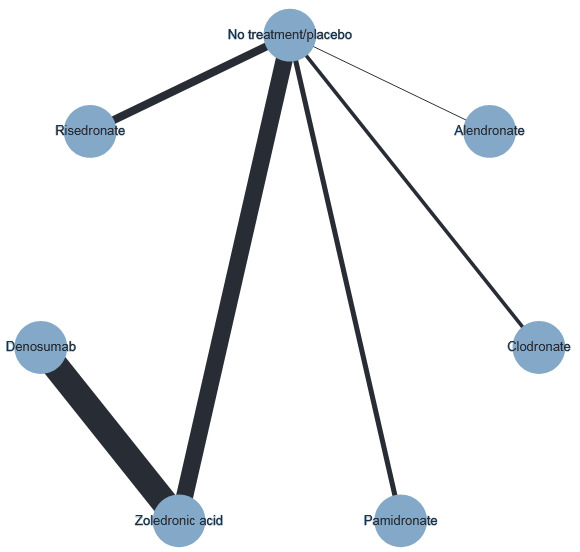
Network diagram for the secondary outcome adverse event: nausea. Any two treatments are connected by a line when there is at least one study comparing the two treatments. Line width: number of participants.
Compared to no treatment/placebo, treatment with denosumab (RR 1.28, 95% CI 1.01 to 1.63) may increase nausea slightly. Treatment with pamidronate (RR 1.25, 95% CI 0.88 to 1.78), risedronate (RR 1.14, 95% CI 0.93 to 1.41), zoledronic acid (RR 1.15, 95% CI 0.95 to 1.38), clodronate (RR 0.99, 95% CI 0.57 to 1.69), and alendronate (RR 0.75, 95% CI 0.42 to 1.35) may result in little to no difference in nausea (Figure 82; Figure 83). By comparing the different bone‐modifying agents with each other, no differences between the six active treatments are shown (Figure 83).
82.
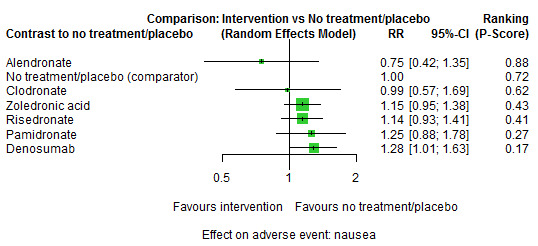
Forest plot for secondary outcome adverse event: nausea. Random‐effects model. Reference treatment: no treatment/placebo. Treatments are ordered by P‐score (descending). The fixed‐effect model yields similar results.
83.
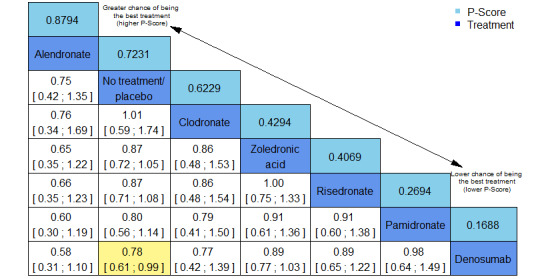
Leaguetable of network meta‐analysis for the outcome adverse event: nausea. Treatment options are ranked as indicated by the arrow from top: greater chance of being the best treatment (higher P‐scores) to bottom: lower chance of being the best treatment (lower P‐score). Network estimates with 95% confidence intervals indicating an effect between two of the treatment options are marked in yellow: treatment option in column better than treatment option in row. Global approach to check inconsistency/heterogeneity: Q‐statistics, I2.
No. of studies: 9. No. of treatments: 7. No. of pairwise comparisons: 9. No. of designs: 6
Heterogeneity/inconsistency: Qtotal = 2.33, P = 0.51; I2 = 0.0%, Tau2 = 0
Treatment effects + 95% confidence intervals (risk ratios, random‐effects model).
Ranking according to P‐scores indicates alendronate as the best treatment option followed by no treatment/placebo, clodronate, zoledronic acid, risedronate, pamidronate, and denosumab (Figure 82; Figure 83). The fixed‐effect model yields similar results (data not shown). For the adverse event nausea, data were not sufficient to estimate prediction intervals.
In the entire network, generalized heterogeneity statistic Qtotal and generalized I2 statistic showed no notable inconsistency between studies (Qtotal = 2.33, P = 0.51; I2 = 0.0%, Tau2 = 0). A test of agreement between direct and indirect evidence to find local inconsistency could not be conducted since there is no closed loop in the network.
Subgroup analysis
When no treatment and placebo were observed separately, the network split in two subnetworks without connection, therefore a statement on differences by observing them separately is not possible (network diagram not shown).
Pairwise meta‐analysis
Two studies reported nausea as an adverse event of treatment with denosumab (Fizazi 2009; Fizazi 2011). Finally, 248/961 participants in the zoledronic acid arm and 283/976 participants in the denosumab arm experienced nausea. Treatment with denosumab may not increase nausea compared to zoledronic acid (RR 0.89, 95% CI 0.77 to 1.03; I2 = 0%, Figure 84).
84.

Results of pairwise meta‐analysis for outcome adverse event: nausea (fixed‐effect and random‐effects).
Efficacy versus acceptability
Total number of SREs versus adverse event renal impairment
Optimal treatment should be characterized by both high efficacy and acceptability. A ranking plot between the outcomes total number of SREs and adverse event renal impairment is shown in Figure 85; the related leaguetable with network estimates (RR) and 95% CIs is given in Figure 86. Only studies reporting both efficacy (total number of SREs) and acceptability (adverse event renal impairment) are considered in the ranking plot (zoledronic acid, clodronate, and the main comparator no treatment/placebo). No treatment option can be found in the right upper corner, which would suggest superiority of both efficacy and acceptability at the same time.
85.
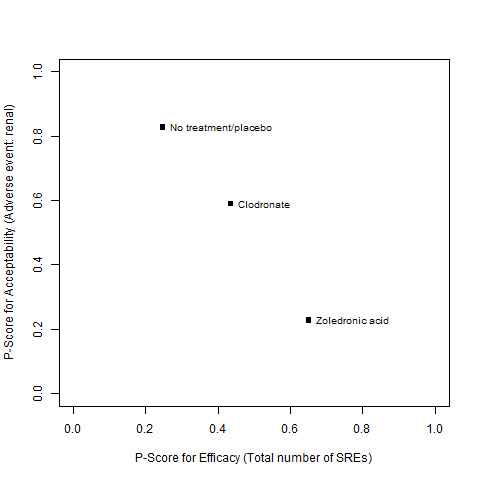
Ranking plot representing simultaneously the efficacy (x axis, total number of skeletal‐related events (SREs)) and the acceptability (y axis, adverse event: renal impairment) of all bone‐modifying agents for patients with prostate cancer and bone metastases. Optimal treatment should be characterized by both high efficacy and acceptability and should be in the right upper corner of this graph. Only studies reporting both efficacy (total numbers of SREs) and acceptability (adverse event: renal impairment) are considered in the ranking plot. Studies reporting only one of the two are not included in the statistical analysis for this plot.
86.

Leaguetable with network estimates of all pairwise comparisons for efficacy (total number of skeletal‐related events) and acceptability (adverse event: renal impairment). Treatments are presented in alphabetical order. Data are risk ratios (RRs) with corresponding 95% confidence intervals. For both efficacy and acceptability, RRs lower than 1 favor the first treatment in alphabetical order. To obtain RRs for comparisons in the opposite direction, reciprocals should be taken. Results not including the line of no effect in their confidence intervals and therefore suggesting evidence for a difference, are marked bold.
Total number of SREs versus adverse event osteonecrosis of the jaw
A ranking plot between the outcomes total number of SREs and adverse event osteonecrosis of the jaw is shown in Figure 87; the related leaguetable with network estimates (RR) and 95% CIs is given in Figure 88. Only studies reporting both efficacy (total number of SREs) and acceptability (adverse event ONJ) are considered in the ranking plot (zoledronic acid, denosumab, clodronate, and the main comparator no treatment/placebo). No treatment option can be found in the right upper corner, which would suggest superiority of both efficacy and acceptability at the same time.
87.
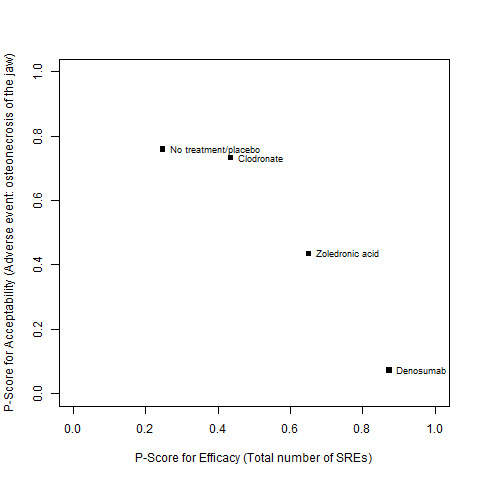
Ranking plot representing simultaneously the efficacy (x axis, total number of skeletal‐related events (SREs)) and the acceptability (y axis, adverse event: osteonecrosis of the jaw) of all bone‐modifying agents for patients with prostate cancer and bone metastases. Optimal treatment should be characterized by both high efficacy and acceptability and should be in the right upper corner of this graph. Only studies reporting both efficacy (total numbers of SREs) and acceptability (adverse event: osteonecrosis of the jaw) are considered in the ranking plot. Studies reporting only one of the two are not included in the statistical analysis for this plot.
88.

Leaguetable with network estimates of all pairwise comparisons for efficacy (total number of skeletal‐related events) and acceptability (adverse event: osteonecrosis of the jaw). Treatments are presented in alphabetical order. Data are risk ratios (RRs) with corresponding 95% confidence intervals. For both efficacy and acceptability, RRs lower than 1 favor the first treatment in alphabetical order. To obtain RRs for comparisons in the opposite direction, reciprocals should be taken. Results not including the line of no effect in their confidence intervals and therefore suggesting evidence for a difference, are marked bold.
Total number of SREs versus grade 3 to 4 adverse events
A ranking plot between the outcomes total number of SREs and grade 3 to 4 adverse events is shown in Figure 89; the related leaguetable with network estimates (RR) and 95% CIs is given in Figure 90. Only studies reporting both efficacy (total number of SREs) and acceptability (grade 3 to 4 adverse events) are considered in the ranking plot (zoledronic acid, denosumab, clodronate, risedronate, pamidronate, and the main comparator no treatment/placebo). No treatment option can be found in the right upper corner, which would suggest superiority of both efficacy and acceptability at the same time.
89.
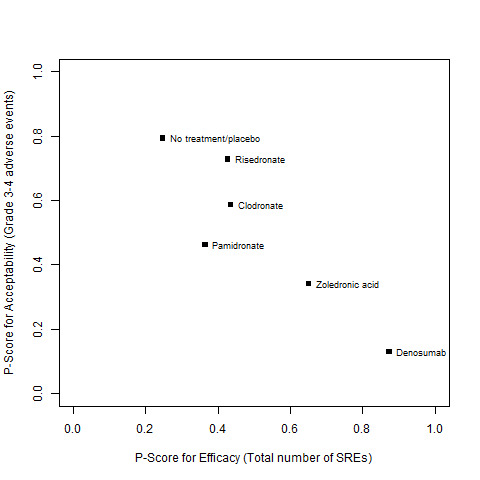
Ranking plot representing simultaneously the efficacy (x axis, total number of skeletal‐related events (SREs)) and the acceptability (y axis, grade 3 to 4 adverse events) of all bone‐modifying agents for patients with prostate cancer and bone metastases. Optimal treatment should be characterized by both high efficacy and acceptability and should be in the right upper corner of this graph. Only studies reporting both efficacy (total numbers of SREs) and acceptability (grade 3 to 4 adverse events) are considered in the ranking plot. Studies only reporting one of the two are not included in the statistical analysis for this plot. Results not including the line of no effect in their confidence intervals and therefore suggesting evidence for a difference, are marked bold.
90.

Leaguetable with network estimates of all pairwise comparisons for efficacy (total number of skeletal‐related events) and acceptability (grade 3 to 4 adverse events). Treatments are presented in alphabetical order. Data are risk ratios (RRs) with corresponding 95% confidence intervals. For both efficacy and acceptability, RRs lower than 1 favor the first treatment in alphabetical order. To obtain RRs for comparisons in the opposite direction, reciprocals should be taken. Results not including the line of no effect in their confidence intervals and therefore suggesting evidence for a difference, are marked bold.
Total number of SREs versus adverse event hypocalcemia
A ranking plot between the outcomes total number of SREs and adverse event hypocalcemia is shown in Figure 91; the related leaguetable with network estimates (RR) and 95% CIs is given in Figure 92. Only studies reporting both efficacy (total number of SREs) and acceptability (adverse event hypocalcemia) are considered in the ranking plot (zoledronic acid, denosumab, clodronate, risedronate, and the main comparator no treatment/placebo). No treatment option can be found in the right upper corner, which would suggest superiority of both efficacy and acceptability at the same time.
91.
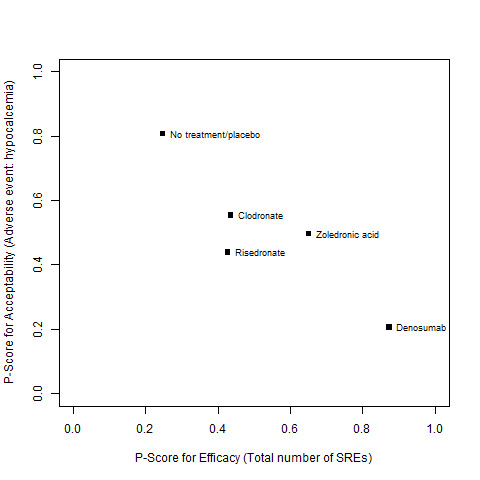
Ranking plot representing simultaneously the efficacy (x axis, total number of skeletal‐related events (SREs)) and the acceptability (y axis, adverse event: hypocalcemia) of all bone‐modifying agents for patients with prostate cancer and bone metastases. Optimal treatment should be characterized by both high efficacy and acceptability and should be in the right upper corner of this graph. Only studies reporting both efficacy (total numbers of SREs) and acceptability (adverse event: hypocalcemia) are considered in the ranking plot. Studies reporting only one of the two are not included in the statistical analysis for this plot.
92.

Leaguetable with network estimates of all pairwise comparisons for efficacy (total number of skeletal‐related events) and acceptability (adverse event: hypocalcemia). Treatments are presented in alphabetical order. Data are risk ratios (RRs) with corresponding 95% confidence intervals. For both efficacy and acceptability, RRs lower than 1 favor the first treatment in alphabetical order. To obtain RRs for comparisons in the opposite direction, reciprocals should be taken.
Discussion
Summary of main results
In this systematic review we aimed to compare different bone‐modifying agents as supportive therapy for men with treatment‐naive, castration‐resistant and hormone‐sensitive prostate cancer and bone metastases. Of the 25 (7435 participants) trials meeting our inclusion criteria, 21 (6892 participants) could be analyzed in network meta‐analysis. The four trials that could not be included reported biomedical markers of bone turnover and disease progression (Michaelson 2012), changes in bone mass density (Ryan 2007), or focused on pain outcomes, but their reporting was insufficient to be included (Abetz 2006; Robertson 1995). The main results are listed as follows.
The evidence suggests that use of any of the reported bisphosphonates may not increase the proportion of participants with pain response when compared to no treatment/placebo. For this outcome, none of the trials reported results for the use of denosumab or the other bisphosphonates. Since proportion of participants with pain response is reported subjectively, the risk for bias due to unblinded trials was high for one and unclear for one of the four studies reporting this outcome. Eight other studies also reported outcomes related to proportion of participants with pain response but could not be included in the analysis.
The use of zoledronic acid likely increases the adverse event renal impairment, while the evidence suggests little to no difference for this outcome with the use of clodronate and alendronate compared to no treatment/placebo. Since renal impairment has not previously been observed as an adverse event with the use of denosumab, studies likely do not report this outcome when analyzing the effects of denosumab. Denosumab was therefore not included in the quantitative analysis for this outcome and does not appear in the ranking.
Treatment with denosumab results in increased occurrence of the adverse event osteonecrosis of the jaw, while the evidence suggests that the bisphosphonates zoledronic acid and clodronate result in little to no difference for this outcome when compared to no treatment/placebo.
Zoledronic acid and denosumab may reduce SREs, while other bisphosphonates may result in little to no difference for this outcome when compared to no treatment/placebo. Considering sensitivity analysis only including trials at low risk of bias, these results changed slightly. The evidence of the sensitivity analysis suggests that zoledronic acid may reduce SREs when compared to no treatment/placebo, but the confidence interval includes the possibility of no effect, whereas the results for denosumab do not differ. When zoledronic acid was compared to denosumab in the main analysis, confidence intervals suggest an effect between the two favoring denosumab.
The evidence suggests little to no difference in mortality for the comparison of any of the bone‐modifying agents against no treatment/placebo. Compared to risedronate, zoledronic acid may be more effective in preventing mortality; however, this small effect does not persist when looking at the results of the sensitivity analysis only including trials considered as at low risk of bias.
We could not analyze quality of life quantitatively in a network meta‐analysis due to poor and inconsistent reporting of this outcome.
Comparing efficacy and acceptability of the bone‐modifying agents at the same time by choosing the prevention of SREs as the measure of efficacy versus different types and measures of adverse events as the measure of acceptability did not show a summary conclusion. The four ranking plots showed heterogenous results regarding the best treatment option which cannot be seen clearly from the ranking plots.
Regarding the three assumptions that need to hold to conduct network meta‐analysis, we epidemiologically judged transitivity between the trials by comparing the characteristics of included participants, interventions, basic anticancer therapy, and settings, and it holds. Regarding consistency and homogeneity, we looked at the statistics for each outcome. We only found inconsistency between direct and indirect evidence for one analysis, and the comparison of clodronate versus no treatment/placebo when analyzing the adverse event hypocalcemia. No relevant effect is shown either for direct evidence or the indirect evidence, but the effects are in different directions and contain wide CIs.
To illustrate efficacy against acceptability, we generated ranking plots with the aim of displaying the balancing of most important benefits against the most important harms. No clear statement could be made on which agent is the most effective and at the same time least harmful from the plots or the corresponding leaguetables for any of the comparisons.
The pairwise meta‐analyses we conducted only contained two included trials comparing denosumab with zoledronic acid. Since one of the trials contains only 49 participants, Fizazi 2009, and the other 1901 participants, Fizazi 2011, the results of the smaller trial only showed little to no influence on the results of the meta‐analyses, and neither trial showed relevant effects for the outcomes total number of SREs, adverse events grade 3 to 4, hypocalcemia, and nausea.
Overall completeness and applicability of evidence
We considered all seven possible bisphosphonates (zoledronic acid, risedronate, pamidronate, alendronate, etidronate, ibandronate, and clodronate) and RANKL‐inhibitors (denosumab) as supportive treatment for men with prostate cancer and bone metastases. We compared the different agents with each other and against no treatment/placebo, which we chose as our main comparator. We could not identify a randomized controlled trial reporting ibandronate for prostate cancer patients with bone metastases, excluding one trial reporting on ibandronate because it was non‐randomized (Heidenreich 2002).
We were able to conduct network meta‐analysis for 15 of 16 planned outcomes with some restrictions regarding the timing of outcome measurement (see Differences between protocol and review). No analysis was possible only for the outcome quality of life.
Not all trials reported all of the patient‐relevant outcomes, resulting in different graphical networks for each outcome. For each outcome, all comparisons formed one connected network, so no subnetworks with separate analyses exist. It should be noted that in the treatment rankings not all bone‐modifying agents appear depending on how they were reported, and that the P‐scores through which the rankings are generated represent mean chances of being the best/worst treatment. Only by looking at the corresponding league tables can relevant differences between treatment options be identified.
The focus of this analysis was the comparison of different bone‐modifying agents. However, different anticancer treatments given in the included trials might also influence our outcomes of interest, especially overall survival/mortality. We did consider the included participants and given anticancer treatments as homogenous enough to calculate the analysis.
We considered studies including participants with metastasized castration‐resistant and castration‐sensitive prostate cancer. To consider potential differences between the two, we conducted subgroup analyses regarding castration status. For most of the outcomes we found that analyses including only mCRPC or only mCSPC patients did not change the relative treatment rankings substantially compared to the combined analysis including both types of patients. Inconsistency was reduced for the total number of adverse events when including only mCRPC patients in the analysis, but was increased for the outcome SRE bone surgery. Considering mCSPC, where separate analysis was possible, NMA effect estimates and confidence intervals suggested no evidence of a difference for all effectiveness outcomes including SREs, pain response, and mortality; overall results for participants with mCSPC should therefore be interpreted with caution.
Since this analysis provides a comprehensive overview on the availability of data for patient‐relevant outcomes and demonstrates treatment rankings for each of them, the results can be used to increase the precision of guideline recommendations and inform decision‐making in clinical practice considering efficacy and acceptability. The analysis also reveals research gaps of head‐to‐head comparisons.
Quality of the evidence
We rated the risk of bias for each trial and every reported outcome of interest. We took into consideration if outcomes were objective or subjective to participants and outcome assessors. Overall, the risk of bias was low to unclear, with 11 studies showing high risk of bias in 2 or more domains, which was due mostly to unblinded trials.
We used the GRADE approach to evaluate the certainty in the evidence for three of the treatment options (zoledronic acid, denosumab, clodronate). Overall, the certainty was judged as high to low for the 25 included studies and the main outcomes. Specifically, our certainty in the evidence on the proportion of participants with pain response was moderate due to imprecision of the results for zoledronic acid and clodronate. Our certainty in the evidence of the adverse event renal impairment was also judged as moderate, due to inconsistency for zoledronic acid, since the prediction intervals shown in Figure 12 compared to confidence intervals would change clinical decision (but not the ranking of treatment options). For clodronate, our certainty in the evidence was judged as moderate due to imprecision of results. We were unable to judge certainty of the evidence for denosumab, since the included trials did not report the two above‐mentioned outcomes. We judged the certainty of the evidence as moderate for zoledronic acid, high for denosumab, and low for clodronate for the outcome adverse events: ONJ. The results for zoledronic acid showed some imprecision, and the certainty of the evidence for clodronate was downgraded twice for imprecision and wide confidence intervals. We judged the certainty of the evidence for total number of SREs as low for all three treatment options due to inconsistency and serious risk of bias for zoledronic acid and denosumab and imprecision and serious risk of bias for clodronate. Considering mortality, we judged the certainty of the evidence for all three treatment options as moderate due to imprecision of the results. Since quality of life could not be analyzed quantitatively, no judgement on the certainty of the evidence was possible.
Potential biases in the review process
We considered different dosages and types of application of one agent as one comparator, since our aim was to compare the different agents with each other and not compare different dosages, for which other types of studies would be beneficial. Only by doing this were networks connected, and we were able to perform a thorough statistical analysis. We considered placebo and no further treatment as the same comparator, even though we are aware of potential placebo effects. When considering placebo and no treatment separately, the network split in two subnetworks without connection for four outcomes (SRE hypercalcemia and the adverse events hypocalcemia, diarrhea, and nausea). If one network existed, the ranking of treatment options did not differ when considering placebo and no treatment as one or two separate comparators for seven outcomes. In three cases, the ranking differed when considering placebo and no treatment separately, but the results suggest no evidence for a difference between the different treatment options.
Furthermore, we planned to perform funnel plots to assess publication bias, but the number of studies was insufficient to do so.
Agreements and disagreements with other studies or reviews
The already cited Cochrane Review analyzing bisphosphonates per se as supportive treatment for men with prostate cancer and bone metastases includes the same, but not all, trials included in this review (Macherey 2017). Still, the results are in parallel with our results.
Compared to a Cochrane Review analyzing the use of bisphosphonates on women with breast cancer with bone metastases, our results are in parallel regarding the use of bisphosphonates leading to a reduction in SREs (O'Carrigan 2017). They report no benefit for bisphosphonates regarding overall survival, which was also shown in our mortality analysis. Bone pain and quality of life could not be analyzed quantitatively.
In a systematic review looking at the effects of bisphosphonates as supportive treatment for women with breast cancer, the authors were not able to perform network meta‐analysis for most of the outcomes, but an effect was seen for zoledronic acid and denosumab as well as for pamidronate regarding SREs when compared to placebo (Tesfamariam 2019). These results are in parallel with our results, with the exception that we did not see an effect for pamidronate.
Authors' conclusions
Implications for practice.
When considering bone‐modifying agents as supportive treatment, one has to balance efficacy and acceptability. As our analyses suggest, the most potent agents also likely bear the most adverse events.
Our results do give an overview of treatment rankings for each outcome, but do not show the whole picture since the included trials did not report results for each outcome consistently, leading to rankings of only three or four of the eight treatment options included in the analysis. Additionally, not all potential agents were included in the analysis due to missing data from randomized controlled trials. More trials with head‐to‐head comparisons including all potential agents are needed to draw the whole picture and proof the results of this analysis.
As current guidelines and organizations recommend denosumab or zoledronic acid for men with bone metastases from castration‐resistant prostate cancer (Alibhai 2017; Fitzpatrick 2014; Mohler 2019; Mottet 2017; Parker 2015), our results align with these recommendations for the most part.
Our analyses did not show efficacy of bone‐modifying agents for metastasized castration‐sensitive prostate cancer (mCSPC) patients only. Results of the overall analyses should therefore be interpreted with caution regarding this population.
Implications for research.
Even though direct and/or indirect comparisons of the different bone‐modifying agents are possible through performing network meta‐analysis, head‐to‐head trials are needed to be able to provide clear recommendations. Future trials should consider reporting all patient‐relevant outcomes more consistently. The finding that for every outcome a different graphical network emerged shows how the 25 included trials reported patient‐relevant outcomes inconsistently. The arising ranking of treatment options for many cases included only three or four of all potential treatment options, which makes an overall judgement impossible.
More studies should also include participants with mCSPC. Results should be reported separately for participants with metastasized castration‐resistant prostate cancer (mCRPC) and mCSPC.
What's new
| Date | Event | Description |
|---|---|---|
| 17 December 2020 | Amended | Under Abstract>Main results, the sentence "The adverse event renal impairment probably occurs more often when treated with zoledronic acid treatment/placebo compared to treatment/placebo.." was changed to "...compared to no treatment/placebo..." |
History
Protocol first published: Issue 5, 2018 Review first published: Issue 11, 2020
Notes
We have based parts of the Methods section of this review on a standard template developed by the Cochrane Metabolic and Endocrine Disorders Group, which has been modified and adapted for use by the Cochrane Urology Group. In addition, this review is partly based on suggested wording from the Pain, Palliative and Supportive Care Review Group (PaPaS CRG), the Cochrane Haematological Malignancies Review Group, and the protocol templates for a Cochrane intervention review that compares multiple interventions (Chaimani 2014; Chaimani 2017).
Acknowledgements
Special thanks to the peer reviewers who provided editorial, methodological, and clinical feedback that helped to make this review more clear, precise, and useful for further dissemination: Javier Cassinello, Mari Imamura, and Mark Klein.
We would like to thank members of Cochrane Urology, especially Robert Lane and Philipp Dahm, for their comments and for improving the review.
The views and opinions expressed therein are those of the authors and do not necessarily reflect those of the Systematic Reviews Programme.
Appendices
Appendix 1. Cochrane Central Register of Controlled Trials (CENTRAL) search strategy
Until March 2020
ID Search
#1 MeSH descriptor: [Prostatic Neoplasms] explode all trees
#2 (prostat* near/3 (cancer* or carcinoma* or malignan* or tumor* or tumour* or neoplas* or intraepithelial* or adenocarcinoma*))
#3 MeSH descriptor: [Prostatitis] explode all trees
#4 (prostatitis or prostatitides or prostatosis)
#5 #1 or #2 or #3 or #4
#6 MeSH descriptor: [Diphosphonates] explode all trees
#7 (diphosphonate* or diphosph*nate*)
#8 (bisphosph*nate* or biphosph*nate*)
#9 #6 or #7 or #8
#10 MeSH descriptor: [Alendronate] explode all trees
#11 (alendronat* or aledronic*)
#12 (fosamax* or binosto* or adronat* or alendros* or onclast*)
#13 #10 or #11 or #12
#14 MeSH descriptor: [Clodronic Acid] explode all trees
#15 (clodronic* or clodronat*)
#16 (bonefos* or clasteon* or difosfonal* or ossiten* or mebonat* or loron* or ostac*)
#17 Cl2MDP
#18 #14 or #15 or #16 or #17
#19 MeSH descriptor: [Etidronic Acid] explode all trees
#20 (etidronic* or etidronat*)
#21 (didronel* or xidifon* or dicalcium or xidiphon*)
#22 (HEDP or EHDP)
#23 #19 or #20 or #21 or #22
#24 MeSH descriptor: [Technetium Tc 99m Medronate] explode all trees
#25 (medronat* or medronic*)
#26 (Technetium near/2 Tc99m near/2 Medronat*)
#27 #24 or #25 or #26
#28 MeSH descriptor: [Pamidronate] explode all trees
#29 (pamidronat* or pamidronic* or amidronat*)
#30 (aredia* or ADP sodium* or aminomux*)
#31 (GCP23339A or GCP‐23339A or YM529 or YM‐529)
#32 #28 or #29 or #30 or #31
#33 MeSH descriptor: [Zoledronic Acid] explode all trees
#34 (zoledronic* or zoledronat*)
#35 (zometa* or zomera* or aclasta* or reclast* or aredia* or zoldron*)
#36 (m05BA08 or CGP‐42446* or CGP42446* or zol‐446 or zol446)
#37 #33 or #34 or #35 or #36
#38 MeSH descriptor: [Ibandronic Acid] explode all trees
#39 (ibandronic* or ibandrovic* or ibandronat*)
#40 (bon*iva* or bondronat* or bondranat* or adronil*)
#41 (RPR102289A or RPR‐102289A)
#42 (BM210955 or BM‐210955)
#43 #38 or #39 or #40 or #41 or #42
#44 MeSH descriptor: [Risedronic Acid] explode all trees
#45 (risedronic* or risedronat*)
#46 (actonel* or atelvia* or benet*)
#47 (NE58095 or NE‐58095)
#48 #44 or #45 or #46 or #47
#49 (neridronat* or neridronic*)
#50 ("AHHexBP" or "6AHHDP" or "6‐AHHDP")
#51 #49 or #50
#52 MeSH descriptor: [RANK Ligand] explode all trees
#53 (rank near/3 ligand*)
#54 RANK ligand inhibitor*
#55 (protein* near/2 (RANKL or TRANCE))
#56 Tumor Necrosis Factor‐Related Activation‐Induced Cytokin*
#57 #52 or #53 or #54 or #55 or #56
#58 MeSH descriptor: [Denosumab] explode all trees
#59 denosumab*
#60 (xgeva* or prolia*)
#61 (AMG162 or AMG‐162)
#62 #58 or #59 or #60 or #61
#63 tiludronat* or tiludronic* or skelid*
#64 Incadronat* or YM175 or YM‐175
#65 olpadronat* or olpadronic*
#66 #63 or #64 or #65
#67 #9 or #13 or #18 or #23 or #27 or #32 or #37 or #43 or #48 or #51 or #57 or #62 or #66
key: *: truncation, near/#: adjacent within # number of words
Appendix 2. MEDLINE search strategy
| # | Searches until March 2020 |
| 1 | exp PROSTATIC NEOPLASMS/ |
| 2 | ((prostat* adj3 cancer*) or (prostat* adj3 carcinoma*) or (prostat* adj3 malignan*) or (prostat* adj3 tumo?r*) or (prostat* adj3 neoplas*) or (prostat* adj3 intraepithelial) or (prostat* adj3 adenocarcinoma*)).tw. |
| 3 | ((prostat* adj6 cancer*) or (prostat* adj6 carcinoma*) or (prostat* adj6 tumo?r*) or (prostat* adj6 neoplas*) or (prostat* adj6 adenocarcinoma*)).ab,ti. |
| 4 | PROSTATITIS/ |
| 5 | (prostatitis or prostatitides or prostatosis).tw. |
| 6 | or/1‐5 |
| 7 | exp DIPHOSPHONATES/ |
| 8 | (diphosphonate* or diphosph#nate*).tw,kf,ot,nm. |
| 9 | (bisphosph#nate* or biphosph#nate*).tw,kf,ot,nm. |
| 10 | or/7‐9 |
| 11 | ALENDRONATE/ |
| 12 | (alendronat* or aledronic*).tw,kf,ot,nm. |
| 13 | (fosamax* or binosto* or adronat* or alendros* or onclast*).tw,kf,ot,nm. |
| 14 | or/11‐13 |
| 15 | CLODRONIC ACID/ |
| 16 | (clodronic* or clodronat*).tw,kf,ot,nm. |
| 17 | (bonefos* or clasteon* or difosfonal* or ossiten* or mebonat* or loron* or ostac*).tw,kf,ot,nm. |
| 18 | Cl2MDP.tw,kf,ot,nm. |
| 19 | or/15‐18 |
| 20 | ETIDRONIC ACID/ |
| 21 | (etidronic* or etidronat*).tw,kf,ot,nm. |
| 22 | (didronel* or xidifon* or dicalcium* or didrocal* or xidiphon*).tw,kf,ot. |
| 23 | (HEDP or EHDP).tw,kf,ot. |
| 24 | or/20‐23 |
| 25 | TECHNETIUM TC 99M MEDRONATE/ |
| 26 | (medronat* or medronic*).tw,kf,ot,nm. |
| 27 | (Technetium adj2 Tc 99m adj2 Medronat*).tw,kf,ot,nm. |
| 28 | or/25‐27 |
| 29 | PAMIDRONATE/ |
| 30 | (pamidronat* or pamidronic* or amidronat*).tw,kf,ot,nm. |
| 31 | (aredia* or ADP sodium* or incadron* or aminomux*).tw,kf,ot,nm. |
| 32 | (GCP23339A or GCP‐23339A or YM529 or YM‐529 or ahprbp).tw,kf,ot,nm. |
| 33 | or/29‐32 |
| 34 | ZOLEDRONIC ACID/ |
| 35 | (zoledronic* or zoledronat*).tw,kf,ot,nm. |
| 36 | (zometa* or zomera* or aclasta* or zoldron* or reclast* or aredia*).tw,kf,ot,nm. |
| 37 | (m05BA08 or CGP‐42446* or CGP42446* or zol‐446 or zol446).tw,kf,ot,nm. |
| 38 | or/34‐37 |
| 39 | IBANDRONIC ACID/ |
| 40 | (ibandronic* or ibandrovic* or ibandronat*).tw,kf,ot,nm. |
| 41 | (bon?iva* or bondronat* or bondranat* or adronil*).tw,kf,ot,nm. |
| 42 | (RPR102289A or RPR‐102289A).tw,kf,ot,nm. |
| 43 | (BM210955 or BM‐210955).tw,kf,ot,nm. |
| 44 | or/39‐43 |
| 45 | RISEDRONIC ACID/ |
| 46 | (risedronic* or risedronat*).tw,kf,ot,nm. |
| 47 | (actonel* or atelvia* or benet*).tw,kf,ot,nm. |
| 48 | (NE58095 or NE‐58095).tw,kf,ot,nm. |
| 49 | or/45‐48 |
| 50 | (neridronat* or neridronic*).tw,kf,ot,nm. |
| 51 | (AHHexBP or 6AHHDP or 6‐AHHDP).tw,kf,ot,nm. |
| 52 | or/50‐51 |
| 53 | RANK Ligand/ |
| 54 | (rank* adj3 ligand*).tw,kf,ot,nm. |
| 55 | RANK ligand inhibitor*.tw,kf,ot,nm. |
| 56 | (protein* adj2 (RANKL or TRANCE)).tw,kf,ot,nm. |
| 57 | Tumor Necrosis Factor‐Related Activation‐Induced Cytokin*.tw,kf,ot,nm. |
| 58 | or/53‐57 |
| 59 | DENOSUMAB/ |
| 60 | denosumab*.tw,kf,ot,nm. |
| 61 | (xgeva* or prolia*).tw,kf,ot,nm. |
| 62 | (AMG162 or AMG‐162).tw,kf,ot,nm. |
| 63 | or/59‐62 |
| 64 | (tiludronat* or tiludronic* or skelid*).tw,kf,ot,nm. |
| 65 | (Incadronat* or YM175 or YM‐175).tw,kf,ot,nm. |
| 66 | (olpadronat* or olpadronic*).tw,kf,ot,nm. |
| 67 | 10 or 14 or 19 or 24 or 28 or 33 or 38 or 44 or 49 or 52 or 58 or 63 or 64 or 65 or 66 |
| 68 | 6 and 67 |
| 69 | randomized controlled trial.pt. |
| 70 | controlled clinical trial.pt. |
| 71 | randomi?ed.ab. |
| 72 | placebo.ab. |
| 73 | drug therapy.fs. |
| 74 | randomly.ab. |
| 75 | trial.ab. |
| 76 | groups.ab. |
| 77 | or/69‐76 |
| 78 | exp ANIMALS/ not HUMANS/ |
| 79 | 77 not 78 |
| 80 | 68 and 79 |
key: tw: text word, kf: keyword heading word, ot: original title, pt: publication type, ab: abstract; nm: substance name, fs: floating subheading; sh: medical subject heading word
Appendix 3. Embase search strategy
| # | Searches until March 2020 |
| 1 | exp PROSTATE TUMOR/ |
| 2 | ((prostat* adj3 cancer*) or (prostat* adj3 carcinoma*) or (prostat* adj3 malignan*) or prostat* tumor* or (prostat* adj3 tumour*) or (prostat* adj3 neoplas*) or (prostat* adj3 intraepithelial*) or (prostat* adj3 adenocarcinoma*)).tw. |
| 3 | exp PROSTATITIS/ |
| 4 | (prostatitis or prostatitides or prostatosis).tw. |
| 5 | or/1‐4 |
| 6 | exp BISPHOSPHONIC ACID DERIVATIVE/ |
| 7 | (diphosphonate* or diphosph*nate*).tw,kw. |
| 8 | (bisphosph*nate* or biphosph*nate*).tw,kw. |
| 9 | or/6‐8 |
| 10 | ALENDRONIC ACID/ |
| 11 | (alendronat* or aledronic*).tw,kw. |
| 12 | (fosamax* or binosto* or adronat*).tw,kw. |
| 13 | (alendros* or onclast*).tw,kw. |
| 14 | or/10‐13 |
| 15 | CLODRONIC ACID/ |
| 16 | (clodronic* or clodronat*).tw,kw. |
| 17 | (bonefos* or clasteon* or difosfonal*).tw,kw. |
| 18 | (ossiten* or mebonat* or loron* or ostac*).tw,kw. |
| 19 | Cl2MDP.tw,kw. |
| 20 | or/15‐19 |
| 21 | ETIDRONIC ACID/ |
| 22 | (etidronic* or etidronat*).tw,kw. |
| 23 | (didronel* or xidifon*).tw,kw. |
| 24 | (dicalcium* or xidiphon*).tw,kw. |
| 25 | (HEDP or EHDP).tw,kw. |
| 26 | or/21‐25 |
| 27 | MEDRONATE TECHNETIUM TC 99M/ |
| 28 | (medronat* or medronic*).tw,kw. |
| 29 | (Technetium adj2 'Tc 99m' adj2 Medronat*).tw,kw. |
| 30 | or/27‐29 |
| 31 | PAMIDRONIC ACID/ |
| 32 | (pamidronat* or pamidronic* or amidronat*).tw,kw. |
| 33 | (aredia* or ADP sodium* or aminomux*).tw,kw. |
| 34 | (GCP23339A or GCP‐23339A or YM529 or YM‐529).tw,kw. |
| 35 | or/31‐34 |
| 36 | ZOLEDRONIC ACID/ |
| 37 | (zoledronic* or zoledronat*).tw,kw. |
| 38 | (zometa* or zomera* or aclasta* or reclast* or aredia* or zoldron*).tw,kw. |
| 39 | (m05BA08 or CGP‐42446* or CGP42446* or zol‐446 or zol446).tw,kw. |
| 40 | or/36‐39 |
| 41 | IBANDRONIC ACID/ |
| 42 | (ibandronic* or ibandrovic* or ibandronat*).tw,kw. |
| 43 | (bon*iva* or bondronat* or bondranat* or adronil*).tw,kw. |
| 44 | (RPR102289A or RPR‐102289A).tw,kw. |
| 45 | (BM210955 or BM‐210955).tw,kw. |
| 46 | or/41‐45 |
| 47 | RISEDRONIC ACID/ |
| 48 | (risedronic* or risedronat*).tw,kw. |
| 49 | (actonel* or atelvia* or benet*).tw,kw. |
| 50 | (NE58095 or NE‐58095).tw,kw. |
| 51 | or/47‐50 |
| 52 | NERIDRONIC ACID/ |
| 53 | (neridronat* or neridronic*).tw,kw. |
| 54 | (AHHexBP or 6AHHDP or 6‐AHHDP or nerixia).tw,kw. |
| 55 | or/52‐54 |
| 56 | OSTEOCLAST DIFFERENTIATION FACTOR/ |
| 57 | 'osteoclast differentiation factor*.tw,kw. |
| 58 | osteoprotegerin ligand*.tw,kw. |
| 59 | (rank adj3 ligand*).tw,kw. |
| 60 | (RANK ligand inhibitor* or receptor activator of NF kappa B ligand).tw,kw. |
| 61 | ((protein* adj2 RANKL) or (protein* adj2 TRANCE) or (protein* adj2 TNFSF 11) or (protein* adj2 TNFSF11)).tw,kw. |
| 62 | (antigen* adj1 cd254).tw,kw. |
| 63 | or/56‐62 |
| 64 | DENOSUMAB/ |
| 65 | denosumab*.tw,kw. |
| 66 | (xgeva* or prolia*).tw,kw. |
| 67 | (AMG162 or AMG‐162).tw,kw. |
| 68 | or/64‐67 |
| 69 | TILUDRONIC ACID/ |
| 70 | (tiludronat* or tiludronic* or skelid*).tw,kw. |
| 71 | (sr 41319 or sr 41319b or sr41319 or sr41319b).tw,kw. |
| 72 | or/69‐71 |
| 73 | INCADRONIC ACID/ |
| 74 | (YM175 or YM‐175 or ym 21175 or ym21175).tw,kw. |
| 75 | (incadronat* or incadronic* or cimadronat* or cimadronic* or bisphonal*).tw,kw. |
| 76 | or/73‐75 |
| 77 | OLPADRONIC ACID/ |
| 78 | (olpadronat* or olpadronic*).tw,kw. |
| 79 | (ig 8801 or ig8801).tw,kw. |
| 80 | or/77‐79 |
| 81 | 9 or 14 or 20 or 26 or 26 or 30 or 35 or 40 or 46 or 51 or 55 or 63 or 68 or 72 or 76 or 80 |
| 82 | RANDOMIZED CONTROLLED TRIAL/ |
| 83 | CONTROLLED CLINICAL STUDY/ |
| 84 | random*.ti,ab. |
| 85 | RANDOMIZATION/ |
| 86 | INTERMETHOD COMPARISON/ |
| 87 | placebo.ti,ab. |
| 88 | (compare or compared or comparison).ti. |
| 89 | (open adj label).ti,ab. |
| 90 | ((double or single or doubly or singly) adj (blind or blinded or blindly)).ti,ab. |
| 91 | double blind procedure/ |
| 92 | parallel group$1.ti,ab. |
| 93 | (crossover or cross over).ti,ab. |
| 94 | ((assign$ or match or matched or allocation) adj5 (alternate or group$1 or intervention$1 or patient$1 or subject$1 or participant$1)).ti,ab. |
| 95 | (controlled adj7 (study or design or trial)).ti,ab. |
| 96 | (volunteer or volunteers).ti,ab. |
| 97 | trial.ti. |
| 98 | or/82‐97 |
| 99 | (ANIMAL EXPERIMENT/ or ANIMAL EXPERIMENT/) not (HUMAN EXPERIMENT/ or HUMAN/) |
| 100 | 98 not 99 |
| 101 | 5 and 81 and 100 |
| 102 | limit 101 to em=201801‐201918 |
Appendix 4. Descriptive figures of comparisons of each outcome
Figure 93; Figure 94; Figure 95; Figure 96; Figure 97; Figure 98; Figure 99
93.
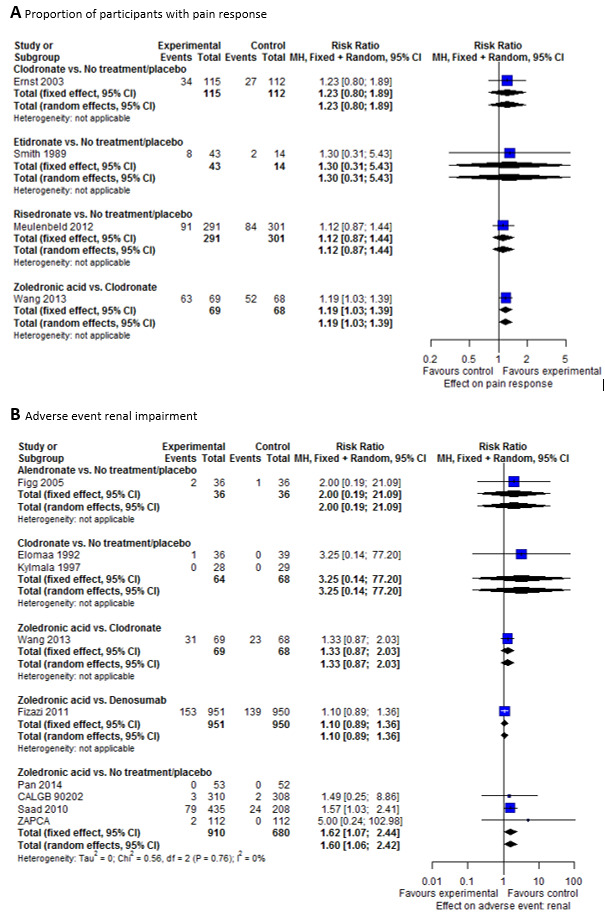
Overview of included studies and comparisons for outcome proportion of participants with pain response (A) and adverse event: renal impairment (B).
94.
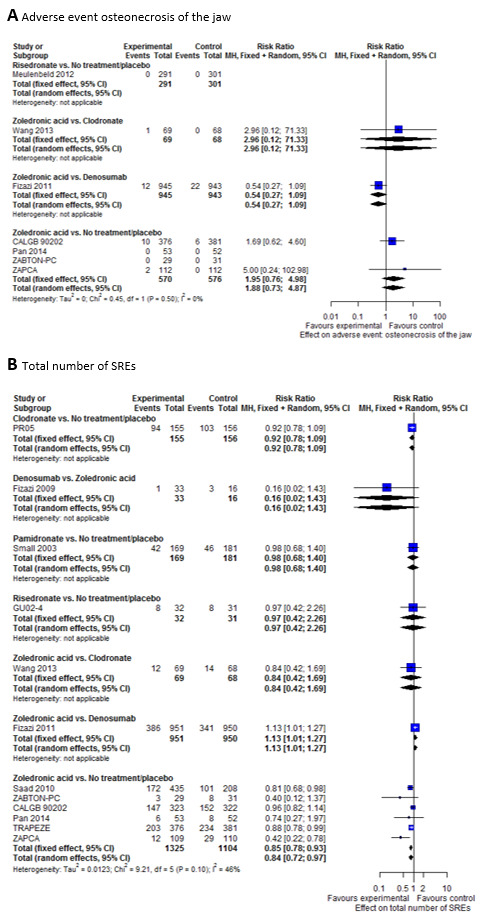
Overview of included studies and comparisons for the outcome adverse event: osteonecrosis of the jaw (A) and total number of skeletal‐related events (SREs) (B).
95.

Overview of included studies and comparisons for the outcome skeletal‐related event (SRE): pathological fractures (A) and SRE: spinal cord compression (B).
96.
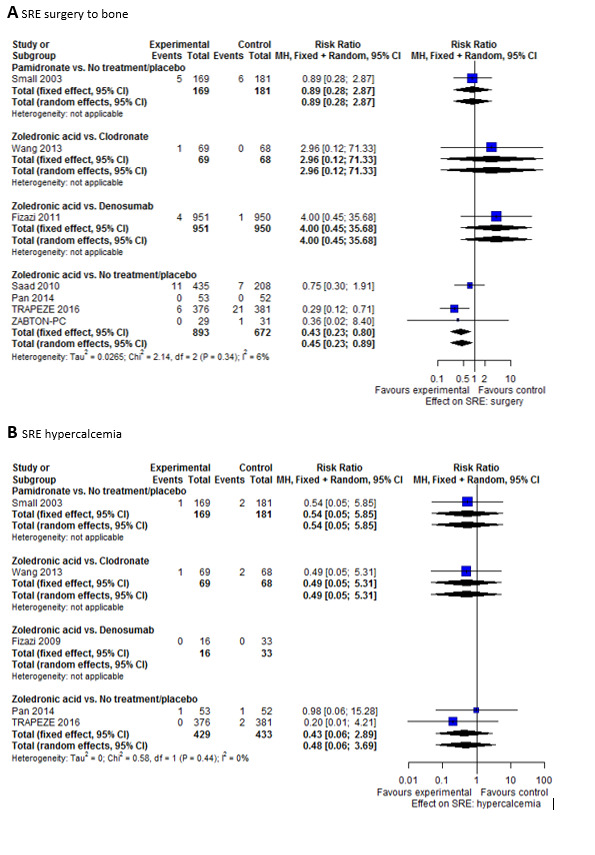
Overview of included studies and comparisons for the outcome skeletal‐related event (SRE): bone surgery (A) and SRE: hypercalcemia (B).
97.
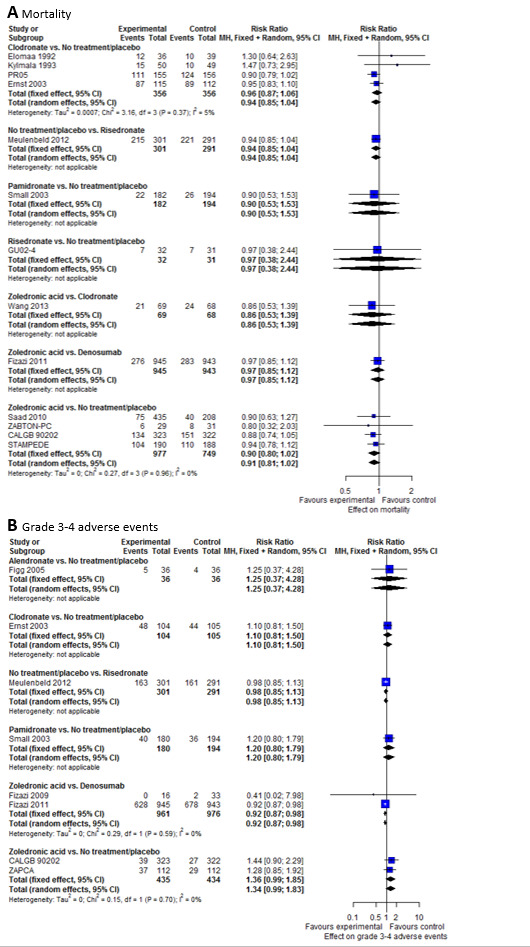
Overview of included studies and comparisons for the outcome mortality (A) and grade 3 to 4 adverse events (B).
98.
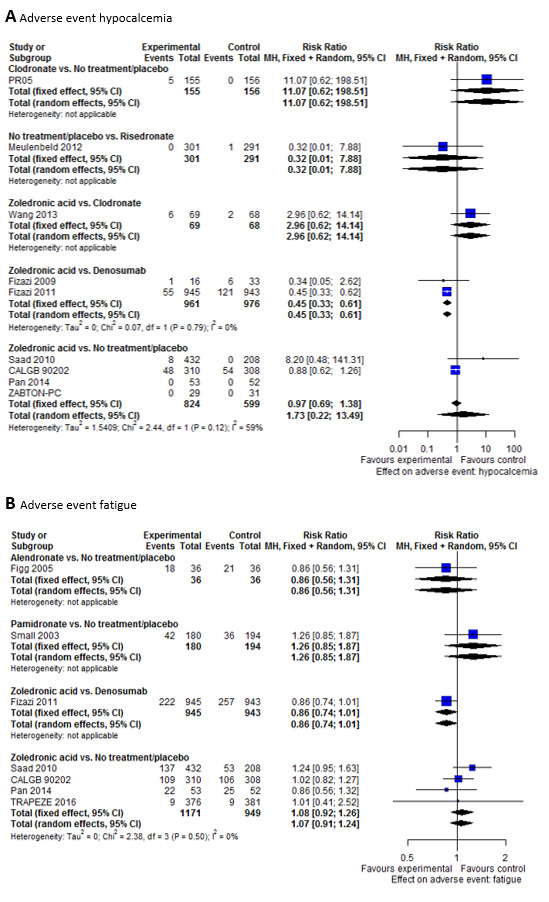
Overview of included studies and comparisons for the outcome adverse event: hypocalcemia (A) and adverse event: fatigue (B).
99.
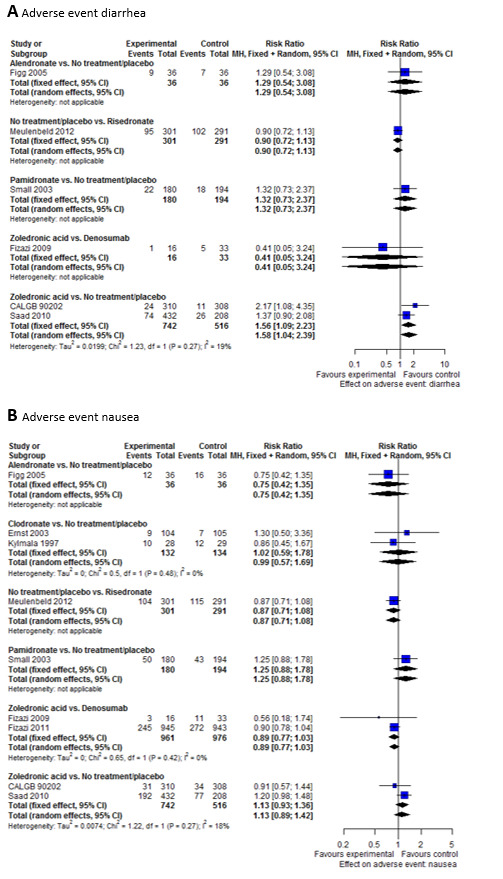
Overview of included studies and comparisons for the outcome adverse event: diarrhea (A) and adverse event: nausea (B).
Characteristics of studies
Characteristics of included studies [ordered by study ID]
Abetz 2006.
| Study characteristics | ||
| Methods | Recruitment period:
Outcomes:
Pain assessment tool:
Randomization:
|
|
| Participants | Eligibility criteria:
Exclusion criteria:
Participants randomized:
Mean age:
Country of participants:
|
|
| Interventions | Previous interventions:
Interventions during study period:
|
|
| Outcomes | Reported and analyzed in this review:
|
|
| Funding sources | Funding sources:
|
|
| Declarations of interest | Conflicts of interest: see meeting.ascopubs.org/cgi/content/abstract/24/18 suppl/4638?sid=2d509f53‐6021‐4c00‐8de9‐6bbec9c7cf92
|
|
| Notes | Only abstracts available, insufficient reporting on methods. | |
| Risk of bias | ||
| Bias | Authors' judgement | Support for judgement |
| Random sequence generation (selection bias) | Unclear risk | No information on sequence generation |
| Allocation concealment (selection bias) | Unclear risk | No information on allocation concealment |
| Blinding of participants and personnel (performance bias) Blinding of participants | Unclear risk | Placebo‐controlled trial, but no information about blinding of participants or personnel |
| Blinding of participants and personnel (performance bias) Blinding of personnel | Unclear risk | Placebo‐controlled trial, but no information about blinding of participants or personnel |
| Blinding of outcome assessment (detection bias) Outcomes subjective to participants | Unclear risk | Insufficient information on blinding of outcome assessment |
| Incomplete outcome data (attrition bias) Patient‐reported outcomes (other than safety data) | Unclear risk | "Post‐baseline missing data was replaced by Last Observation Carried Forward (LOCF)"; insufficient information regarding discontinuations and intention‐to‐treat |
| Incomplete outcome data (attrition bias) Other outcomes | Unclear risk | No reporting on outcomes other than patient‐reported outcomes. Insufficient information regarding discontinuations and ITT |
| Selective reporting (reporting bias) | Unclear risk | No study protocol available. |
| Other bias | High risk | Insufficient reporting on methods |
CALGB 90202.
| Study characteristics | ||
| Methods | Recruitment period:
Outcomes:
Pain assessment tool:
Randomization:
|
|
| Participants | Eligibility criteria:
Exclusion criteria:
Participants randomized:
Mean age:
Country of participants:
|
|
| Interventions | Previous interventions:
Interventions during study period:
|
|
| Outcomes | Reported and analyzed in this review:
|
|
| Funding sources | Funding sources:
|
|
| Declarations of interest | Conflicts of interest:
|
|
| Notes | Prematurely completed after corporate supporter withdrew study drug supply | |
| Risk of bias | ||
| Bias | Authors' judgement | Support for judgement |
| Random sequence generation (selection bias) | Low risk | “Randomized block design was used.” |
| Allocation concealment (selection bias) | Unclear risk | Insufficient information on allocation concealment |
| Blinding of participants and personnel (performance bias) Blinding of participants | Low risk | Quote from protocol: “Masking: Double Blind (Subject, Caregiver, Investigator, Outcomes Assessor).” |
| Blinding of participants and personnel (performance bias) Blinding of personnel | Low risk | Quote from protocol: “Masking: Double Blind (Subject, Caregiver, Investigator, Outcomes Assessor).” |
| Blinding of outcome assessment (detection bias) Outcomes subjective to participants | Low risk | Quote from protocol: “Masking: Double Blind (Subject, Caregiver, Investigator, Outcomes Assessor).” |
| Blinding of outcome assessment (detection bias) Outcomes subjective to outcome assessors | Low risk | Quote from protocol: “Masking: Double Blind (Subject, Caregiver, Investigator, Outcomes Assessor).” |
| Blinding of outcome assessment (detection bias) Objective outcomes | Low risk | Quote from protocol: “Masking: Double Blind (Subject, Caregiver, Investigator, Outcomes Assessor).” |
| Incomplete outcome data (attrition bias) Time‐to‐event data | Low risk | "An intention‐to‐treat approach was used in the analysis for all clinical end points, with the exception of toxicity" |
| Incomplete outcome data (attrition bias) Patient‐reported outcomes (other than safety data) | Low risk | "An intention‐to‐treat approach was used in the analysis for all clinical end points, with the exception of toxicity" |
| Incomplete outcome data (attrition bias) Safety data | Unclear risk | "Sixty‐five patients in the zoledronic acid group and 38 patients in the placebo group withdrew from the study because of adverse events." |
| Incomplete outcome data (attrition bias) Other outcomes | Low risk | "An intention‐to‐treat approach was used in the analysis for all clinical end points, with the exception of toxicity." |
| Selective reporting (reporting bias) | Low risk | Report on every endpoint (primary and secondary) mentioned in the original protocol. |
| Other bias | Low risk | None identified |
Elomaa 1992.
| Study characteristics | ||
| Methods | Recruitment period:
Outcomes:
Pain assessment tool:
Randomization:
|
|
| Participants | Eligibility criteria:
Exclusion criteria:
Participants randomized:
Mean age:
Country of participants:
|
|
| Interventions | Previous interventions:
Interventions during study period:
|
|
| Outcomes | Reported and analyzed in this review:
|
|
| Funding sources | Funding sources:
|
|
| Declarations of interest | Conflicts of interest:
|
|
| Notes | ||
| Risk of bias | ||
| Bias | Authors' judgement | Support for judgement |
| Random sequence generation (selection bias) | Unclear risk | Insufficient information on sequence generation |
| Allocation concealment (selection bias) | Unclear risk | Insufficient information on allocation concealment |
| Blinding of participants and personnel (performance bias) Blinding of participants | Unclear risk | Placebo‐controlled trial. Insufficient information on blinding of participants and personnel |
| Blinding of outcome assessment (detection bias) Outcomes subjective to participants | Unclear risk | Insufficient information on blinding of participants |
| Blinding of outcome assessment (detection bias) Objective outcomes | Low risk | Insufficient information on blinding of outcome assessment, but no known reason for bias |
| Incomplete outcome data (attrition bias) Time‐to‐event data | Unclear risk | No information regarding discontinuations and ITT |
| Incomplete outcome data (attrition bias) Patient‐reported outcomes (other than safety data) | Unclear risk | No information regarding discontinuations and ITT |
| Incomplete outcome data (attrition bias) Safety data | Unclear risk | No information regarding discontinuations and ITT |
| Incomplete outcome data (attrition bias) Other outcomes | Unclear risk | No information regarding discontinuations and ITT |
| Selective reporting (reporting bias) | Unclear risk | No study protocol available. |
| Other bias | Low risk | None identified |
Ernst 2003.
| Study characteristics | ||
| Methods | Recruitment period:
Outcomes:
Pain assessment tool:
Randomization:
|
|
| Participants | Eligibility criteria:
Exclusion criteria:
Participants randomized:
Median age:
Country of participants:
|
|
| Interventions | Previous interventions:
Interventions during study period:
|
|
| Outcomes | Reported and analyzed in this review:
|
|
| Funding sources | Funding sources:
|
|
| Declarations of interest | Conflicts of interest:
|
|
| Notes | ||
| Risk of bias | ||
| Bias | Authors' judgement | Support for judgement |
| Random sequence generation (selection bias) | Low risk | “Patients were randomly assigned using a block‐randomization procedure with equal probability of assignment to either arm.” |
| Allocation concealment (selection bias) | Unclear risk | “The treating staff and patients were blinded to treatment allocation.” However, the concealment process was not described in detail. |
| Blinding of participants and personnel (performance bias) Blinding of participants | Low risk | “The treating staff and patients were blinded to treatment allocation.” |
| Blinding of participants and personnel (performance bias) Blinding of personnel | Low risk | “The treating staff and patients were blinded to treatment allocation.” |
| Blinding of outcome assessment (detection bias) Outcomes subjective to participants | Low risk | “The treating staff and patients were blinded to treatment allocation.” |
| Blinding of outcome assessment (detection bias) Objective outcomes | Low risk | “The treating staff and patients were blinded to treatment allocation.” |
| Incomplete outcome data (attrition bias) Time‐to‐event data | Low risk | "All patients were seen and reviewed every 3 weeks.... response rates, survival, time to progression, and health‐related quality of life were undertaken on an intent‐to‐treat basis for all eligible patients." |
| Incomplete outcome data (attrition bias) Patient‐reported outcomes (other than safety data) | Low risk | "All patients were seen and reviewed every 3 weeks.... response rates, survival, time to progression, and health‐related quality of life were undertaken on an intent‐to‐treat basis for all eligible patients." |
| Incomplete outcome data (attrition bias) Safety data | Unclear risk | "Safety and drug exposure analyses were based on the actual drug received." |
| Selective reporting (reporting bias) | Unclear risk | Protocol available (NCT00003232), but outcomes not prespecified in the protocol. |
| Other bias | Low risk | None identified |
Figg 2005.
| Study characteristics | ||
| Methods | Recruitment period:
Outcomes:
Pain assessment tool:
Randomization:
|
|
| Participants | Eligibility criteria:
Exclusion criteria:
Participants randomized:
Mean age:
Country of participants:
|
|
| Interventions | Previous interventions:
Interventions during study period:
|
|
| Outcomes | Reported and analyzed in this review:
|
|
| Funding sources | Funding sources:
|
|
| Declarations of interest | Conflicts of interest:
|
|
| Notes | ||
| Risk of bias | ||
| Bias | Authors' judgement | Support for judgement |
| Random sequence generation (selection bias) | Unclear risk | Insufficient information on sequence generation |
| Allocation concealment (selection bias) | Unclear risk | Insufficient information on allocation concealment |
| Blinding of participants and personnel (performance bias) Blinding of participants | High risk | “This was an open label, randomized, phase II study [...]” |
| Blinding of participants and personnel (performance bias) Blinding of personnel | High risk | “This was an open label, randomized, phase II study [...]” |
| Blinding of outcome assessment (detection bias) Outcomes subjective to participants | High risk | “This was an open label, randomized, phase II study [...]” |
| Blinding of outcome assessment (detection bias) Outcomes subjective to outcome assessors | Unclear risk | No information on blinding of outcome assessor |
| Blinding of outcome assessment (detection bias) Objective outcomes | Low risk | No information on blinding of outcome assessor, but no known reason for bias |
| Incomplete outcome data (attrition bias) Time‐to‐event data | Low risk | "The primary analysis was conducted on all patients who were randomized" |
| Incomplete outcome data (attrition bias) Safety data | Low risk | "Safety analyses were performed on randomized patients who received at least 1 dose of investigational drug" |
| Incomplete outcome data (attrition bias) Other outcomes | Low risk | Complete analysis of all randomized participants |
| Selective reporting (reporting bias) | Unclear risk | Protocol available (NCT00019695); more outcomes reported than prespecified in the protocol (e.g. overall survival). |
| Other bias | Low risk | None identified |
Fizazi 2009.
| Study characteristics | ||
| Methods | Recruitment period:
Outcomes:
Pain assessment tool:
Randomization:
|
|
| Participants | Eligibility criteria:
Exclusion criteria:
Participants randomized:
Mean age:
Country of participants:
|
|
| Interventions | Previous interventions:
Interventions during study period:
|
|
| Outcomes | Reported and analyzed in this review:
|
|
| Funding sources | Funding sources: supported by Amgen Inc. | |
| Declarations of interest | Conflicts of interest:
|
|
| Notes | ||
| Risk of bias | ||
| Bias | Authors' judgement | Support for judgement |
| Random sequence generation (selection bias) | Unclear risk | Insufficient information on sequence generation |
| Allocation concealment (selection bias) | Unclear risk | Insufficient information on allocation concealment |
| Blinding of participants and personnel (performance bias) Blinding of participants | High risk | "phase II, randomized, open label, active controlled study" |
| Blinding of participants and personnel (performance bias) Blinding of personnel | High risk | "phase II, randomized, open label, active controlled study" |
| Blinding of outcome assessment (detection bias) Outcomes subjective to participants | High risk | "phase II, randomized, open label, active controlled study" |
| Blinding of outcome assessment (detection bias) Outcomes subjective to outcome assessors | Unclear risk | "phase II, randomized, open label, active controlled study," but no information on blinding of outcome assessor |
| Blinding of outcome assessment (detection bias) Objective outcomes | Low risk | No information on blinding of outcome assessor, but bias unlikely for objective outcomes |
| Incomplete outcome data (attrition bias) Time‐to‐event data | Low risk | "The primary analysis was conducted on all patients who were randomized." In both groups there were discontinuations and loss to follow‐up with reasons described. |
| Incomplete outcome data (attrition bias) Safety data | Low risk | "Safety analyses were performed on randomized patients who received at least 1 dose of investigational drug." In both groups there were discontinuations and loss to follow‐up with reasons described. |
| Incomplete outcome data (attrition bias) Other outcomes | Unclear risk | In both groups there were discontinuations and loss to follow‐up with reasons described, but not for prostate cancer subgroup alone. |
| Selective reporting (reporting bias) | Low risk | Study protocol available (NCT00104650); no bias found. |
| Other bias | Low risk | None identified |
Fizazi 2011.
| Study characteristics | ||
| Methods | Recruitment period:
Outcomes:
Pain assessment tool:
Randomization:
|
|
| Participants | Eligibility criteria:
Exclusion criteria:
Participants randomized:
Mean age:
Country of participants:
|
|
| Interventions | Previous interventions:
Interventions during study period:
|
|
| Outcomes | Reported and analyzed in this review:
|
|
| Funding sources | Funding sources: Amgen | |
| Declarations of interest | Conflicts of interest:
|
|
| Notes | ||
| Risk of bias | ||
| Bias | Authors' judgement | Support for judgement |
| Random sequence generation (selection bias) | Low risk | "The computer‐generated randomization schedule was prepared by an individual independent of the study team" |
| Allocation concealment (selection bias) | Low risk | "An interactive voice response system was used to assign patients (1:1 ratio)" |
| Blinding of participants and personnel (performance bias) Blinding of participants | Low risk | "Patients, study staff, and investigators were masked to treatment assignment throughout the primary analysis period" |
| Blinding of participants and personnel (performance bias) Blinding of personnel | Low risk | "Patients, study staff, and investigators were masked to treatment assignment throughout the primary analysis period" |
| Blinding of outcome assessment (detection bias) Outcomes subjective to participants | Low risk | "Patients, study staff, and investigators were masked to treatment assignment throughout the primary analysis period" |
| Blinding of outcome assessment (detection bias) Outcomes subjective to outcome assessors | Low risk | "Patients, study staff, and investigators were masked to treatment assignment throughout the primary analysis period" |
| Blinding of outcome assessment (detection bias) Objective outcomes | Low risk | "Patients, study staff, and investigators were masked to treatment assignment throughout the primary analysis period" |
| Incomplete outcome data (attrition bias) Time‐to‐event data | Low risk | "The main analysis of both primary and secondary efficacy endpoints included all randomized patients, irrespective of administration of study treatments" |
| Incomplete outcome data (attrition bias) Safety data | Low risk | "The main analysis of both primary and secondary efficacy endpoints included all randomized patients, irrespective of administration of study treatments" |
| Incomplete outcome data (attrition bias) Other outcomes | Low risk | "The main analysis of both primary and secondary efficacy endpoints included all randomized patients, irrespective of administration of study treatments" |
| Selective reporting (reporting bias) | Unclear risk | NCT00321620; not all reported outcomes predefined in the protocol |
| Other bias | Low risk | None identified |
GU02‐4.
| Study characteristics | ||
| Methods | Recruitment period:
Outcomes:
Pain assessment tool:
Randomization:
|
|
| Participants | Eligibility criteria:
Exclusion criteria:
Participants randomized:
Mean age:
Country of participants:
|
|
| Interventions | Previous interventions:
Interventions during study period:
|
|
| Outcomes | Reported and analyzed in this review:
|
|
| Funding sources | Funding sources:
|
|
| Declarations of interest | Conflicts of interest:
|
|
| Notes | ||
| Risk of bias | ||
| Bias | Authors' judgement | Support for judgement |
| Random sequence generation (selection bias) | Unclear risk | Insufficient information on sequence generation |
| Allocation concealment (selection bias) | Unclear risk | Insufficient information on allocation concealment |
| Blinding of participants and personnel (performance bias) Blinding of participants | Unclear risk | Insufficient information on blinding of participants and personnel |
| Blinding of participants and personnel (performance bias) Blinding of personnel | Unclear risk | Placebo‐controlled trial, no further information |
| Blinding of outcome assessment (detection bias) Outcomes subjective to participants | Unclear risk | No information on blinding of outcome assessor |
| Blinding of outcome assessment (detection bias) Objective outcomes | Low risk | No known reason for bias |
| Incomplete outcome data (attrition bias) Time‐to‐event data | Unclear risk | Insufficient information on incomplete outcome data |
| Incomplete outcome data (attrition bias) Safety data | Unclear risk | Insufficient information on incomplete outcome data |
| Selective reporting (reporting bias) | Low risk | Protocol available (NCT00216060) |
| Other bias | Low risk | None identified |
Kylmala 1993.
| Study characteristics | ||
| Methods | Recruitment period:
Outcomes:
Pain assessment tool:
Randomization:
|
|
| Participants | Eligibility criteria:
Exclusion criteria:
Participants randomized:
Mean age:
Country of participants:
|
|
| Interventions | Previous interventions:
Interventions during study period:
|
|
| Outcomes | Reported and analyzed in this review:
|
|
| Funding sources | Funding sources:
|
|
| Declarations of interest | Conflicts of interest:
|
|
| Notes | ||
| Risk of bias | ||
| Bias | Authors' judgement | Support for judgement |
| Random sequence generation (selection bias) | Unclear risk | Insufficient information on sequence generation |
| Allocation concealment (selection bias) | Unclear risk | Insufficient information on allocation concealment |
| Blinding of participants and personnel (performance bias) Blinding of participants | Unclear risk | Insufficient information on blinding of participants and personnel |
| Blinding of participants and personnel (performance bias) Blinding of personnel | Unclear risk | Insufficient information on blinding of participants and personnel |
| Blinding of outcome assessment (detection bias) Outcomes subjective to participants | Unclear risk | Insufficient information on blinding of participants and personnel |
| Blinding of outcome assessment (detection bias) Objective outcomes | Low risk | No known reason for bias |
| Incomplete outcome data (attrition bias) Time‐to‐event data | Unclear risk | No information regarding discontinuations and ITT |
| Incomplete outcome data (attrition bias) Patient‐reported outcomes (other than safety data) | Unclear risk | No information regarding discontinuations and ITT |
| Selective reporting (reporting bias) | Unclear risk | No study protocol available. |
| Other bias | Low risk | None identified |
Kylmala 1997.
| Study characteristics | ||
| Methods | Recruitment period:
Outcomes:
Pain assessment tool:
Randomization:
|
|
| Participants | Eligibility criteria:
Exclusion criteria:
Participants randomized:
Mean age:
Country of participants:
|
|
| Interventions | Previous interventions:
Interventions during study period:
|
|
| Outcomes | Reported and analyzed in this review:
|
|
| Funding sources | Funding sources:
|
|
| Declarations of interest | Conflicts of interest:
|
|
| Notes | ||
| Risk of bias | ||
| Bias | Authors' judgement | Support for judgement |
| Random sequence generation (selection bias) | Unclear risk | Insufficient information on sequence generation |
| Allocation concealment (selection bias) | Unclear risk | Insufficient information on allocation concealment |
| Blinding of participants and personnel (performance bias) Blinding of participants | Unclear risk | Placebo‐controlled trial, no further information on blinding |
| Blinding of participants and personnel (performance bias) Blinding of personnel | Unclear risk | No information on blinding of personnel |
| Blinding of outcome assessment (detection bias) Outcomes subjective to participants | Unclear risk | Placebo‐controlled trial, no further information on blinding |
| Incomplete outcome data (attrition bias) Patient‐reported outcomes (other than safety data) | Unclear risk | No information regarding discontinuations and ITT |
| Incomplete outcome data (attrition bias) Safety data | Unclear risk | No information regarding discontinuations and ITT |
| Selective reporting (reporting bias) | Unclear risk | No protocol available. |
| Other bias | Low risk | None identified |
Meulenbeld 2012.
| Study characteristics | ||
| Methods | Recruitment period:
Outcomes:
Pain assessment tool:
Randomization:
|
|
| Participants | Eligibility criteria:
Exclusion criteria:
Participants randomized:
Mean age:
Country of participants:
|
|
| Interventions | Previous interventions:
Interventions during study period:
|
|
| Outcomes | Reported and analyzed in this review:
|
|
| Funding sources | Funding sources:
|
|
| Declarations of interest | Conflicts of interest:
|
|
| Notes | ||
| Risk of bias | ||
| Bias | Authors' judgement | Support for judgement |
| Random sequence generation (selection bias) | Unclear risk | Insufficient information on sequence generation |
| Allocation concealment (selection bias) | Unclear risk | Insufficient information on allocation concealment |
| Blinding of participants and personnel (performance bias) Blinding of participants | High risk | "This randomized, open label, phase II/III trial [...]." |
| Blinding of participants and personnel (performance bias) Blinding of personnel | High risk | "This randomized, open label, phase II/III trial [...]." |
| Blinding of outcome assessment (detection bias) Outcomes subjective to participants | High risk | "This randomized, open label, phase II/III trial [...]." |
| Blinding of outcome assessment (detection bias) Outcomes subjective to outcome assessors | Unclear risk | No information on blinding of outcome assessor |
| Blinding of outcome assessment (detection bias) Objective outcomes | Low risk | No known reason for bias |
| Incomplete outcome data (attrition bias) Time‐to‐event data | Low risk | "All participants with bone metastasis from prostate cancer were included in the analysis of efficacy and safety." Reasons given for every dropout. |
| Incomplete outcome data (attrition bias) Patient‐reported outcomes (other than safety data) | Low risk | "All participants with bone metastasis from prostate cancer were included in the analysis of efficacy and safety." Reasons given for every dropout. |
| Incomplete outcome data (attrition bias) Safety data | Low risk | "All randomized patients were analyzed for safety." |
| Selective reporting (reporting bias) | Low risk | Protocol available (ISRCTN22844568), prespecified outcomes reported. |
| Other bias | Low risk | None identified |
Michaelson 2012.
| Study characteristics | ||
| Methods | Recruitment period:
Outcomes:
Randomization:
|
|
| Participants | Eligibility criteria:
Exclusion criteria:
Participants randomized:
Mean age:
Country of participants:
|
|
| Interventions | Interventions during study period:
|
|
| Outcomes | Reported and analyzed in this review: none | |
| Funding sources | John and Claire Bertucci Center for Genitourinary Malignancies (Massachusetts General Hospital), Abbott Laboratories, and the National Institutes of Health (NIH; grant 1K12CA87723 to MDM) | |
| Declarations of interest | Not reported | |
| Notes | ||
| Risk of bias | ||
| Bias | Authors' judgement | Support for judgement |
| Random sequence generation (selection bias) | Unclear risk | Insufficient information on sequence generation |
| Allocation concealment (selection bias) | Unclear risk | Insufficient information on allocation concealment |
| Blinding of participants and personnel (performance bias) Blinding of participants | Unclear risk | No information on blinding of participants |
| Blinding of participants and personnel (performance bias) Blinding of personnel | Unclear risk | No information on blinding of personnel |
| Blinding of outcome assessment (detection bias) Outcomes subjective to outcome assessors | Unclear risk | No information on blinding of outcome assessor |
| Blinding of outcome assessment (detection bias) Objective outcomes | Low risk | No information on blinding, but no known reason for bias |
| Incomplete outcome data (attrition bias) Safety data | Unclear risk | Short follow‐up duration |
| Selective reporting (reporting bias) | Unclear risk | NCT00181558; adverse events were reported, but not preplanned in the trial registry |
| Other bias | Low risk | None identified |
Pan 2014.
| Study characteristics | ||
| Methods | Recruitment period:
Outcomes:
Pain assessment tool:
Randomization:
|
|
| Participants | Eligibility criteria:
Exclusion criteria:
Participants randomized:
Mean age:
Country of participants:
|
|
| Interventions | Previous interventions:
Interventions during study period:
|
|
| Outcomes | Reported and analyzed in this review:
|
|
| Funding sources | Funding sources:
|
|
| Declarations of interest | Conflicts of interest:
|
|
| Notes | ||
| Risk of bias | ||
| Bias | Authors' judgement | Support for judgement |
| Random sequence generation (selection bias) | Unclear risk | Insufficient report on sequence generation |
| Allocation concealment (selection bias) | Unclear risk | Insufficient information on allocation concealment |
| Blinding of participants and personnel (performance bias) Blinding of participants | Unclear risk | Placebo‐controlled trial, no further information on blinding |
| Blinding of participants and personnel (performance bias) Blinding of personnel | Unclear risk | No information on blinding of participants and personnel |
| Blinding of outcome assessment (detection bias) Outcomes subjective to participants | Unclear risk | No information on blinding of participants and personnel |
| Blinding of outcome assessment (detection bias) Outcomes subjective to outcome assessors | Unclear risk | Insufficient reporting on blinding of outcome assessor |
| Blinding of outcome assessment (detection bias) Objective outcomes | Low risk | No known reason for bias |
| Incomplete outcome data (attrition bias) Time‐to‐event data | Low risk | "All patients were evaluated for the efficacy and safety every one treatment cycle until death or severe toxicity" |
| Incomplete outcome data (attrition bias) Patient‐reported outcomes (other than safety data) | Low risk | No participants lost to follow‐up. All participants were included in the ITT analysis. |
| Incomplete outcome data (attrition bias) Safety data | Low risk | "All patients were evaluated for the efficacy and safety every one treatment cycle until death or severe toxicity" |
| Incomplete outcome data (attrition bias) Other outcomes | Unclear risk | No participants lost to follow‐up. All participants were included in the ITT analysis. |
| Selective reporting (reporting bias) | Unclear risk | No study protocol available. |
| Other bias | Low risk | None identified |
PR05.
| Study characteristics | ||
| Methods | Recruitment period:
Outcomes:
Pain assessment tool:
Randomization:
|
|
| Participants | Eligibility criteria:
Exclusion criteria:
Participants randomized:
Median age:
Country of participants:
|
|
| Interventions | Previous interventions:
Interventions during study period:
|
|
| Outcomes | Reported and analyzed in this review:
|
|
| Funding sources | Quote: "This trial was sponsored by the U.K. Medical Research Council (MRC)." "The trial was initiated with the support of Boehringer Mannheim. The company provided trial tablets (Loron 520 and matching placebo) free of charge, plus financial support (£250) on a per patient basis, which was sufficient to contribute toward the administrative costs of the trial. The financial support was distributed proportionately between the participating clinicians and the coordinating center [...] During the trial, Boehringer Mannheim was taken over by Roche Products Ltd., which honored all commitments regarding this trial." |
|
| Declarations of interest | Insufficient reporting on potential conflicts of interest | |
| Notes | ||
| Risk of bias | ||
| Bias | Authors' judgement | Support for judgement |
| Random sequence generation (selection bias) | Unclear risk | Insufficient information on sequence generation |
| Allocation concealment (selection bias) | Low risk | "Randomization was performed centrally at the MRC CTU [...] No patient information, other than their drug number and hospital, was revealed to the pharmaceutical companies." |
| Blinding of participants and personnel (performance bias) Blinding of participants | Low risk | Double‐blind, placebo‐controlled trial |
| Blinding of participants and personnel (performance bias) Blinding of personnel | Low risk | Double‐blind, placebo‐controlled trial |
| Blinding of outcome assessment (detection bias) Outcomes subjective to participants | Low risk | Double‐blind, placebo‐controlled trial |
| Blinding of outcome assessment (detection bias) Outcomes subjective to outcome assessors | Low risk | "Full, blinded interim analyses, including those of the primary and secondary outcome measures, were produced for an independent Data Monitoring and Ethics Committee (DMEC) on three occasions (July 1996, July 1997, and September 1999)." |
| Blinding of outcome assessment (detection bias) Objective outcomes | Low risk | No known reason for bias |
| Incomplete outcome data (attrition bias) Time‐to‐event data | Low risk | All participants were included in the ITT analysis. |
| Incomplete outcome data (attrition bias) Patient‐reported outcomes (other than safety data) | Low risk | All participants were included in the ITT analysis. |
| Incomplete outcome data (attrition bias) Safety data | Low risk | All participants were included in the ITT analysis. |
| Selective reporting (reporting bias) | Low risk | Study protocol available (ISRCTN38477744). All prespecified outcomes were reported. |
| Other bias | Low risk | None identified |
Robertson 1995.
| Study characteristics | ||
| Methods | Recruitment period:
Outcomes:
Randomization:
|
|
| Participants | Eligibility criteria:
Exclusion criteria:
Participants randomized:
Median age:
Country of participants:
|
|
| Interventions | Interventions during study period:
|
|
| Outcomes | Reported and analyzed in this review: none | |
| Funding sources | Supported by Boehringer Mannheim, Livingston, UK | |
| Declarations of interest | Not reported | |
| Notes | ||
| Risk of bias | ||
| Bias | Authors' judgement | Support for judgement |
| Random sequence generation (selection bias) | Unclear risk | Insufficient information on sequence generation |
| Allocation concealment (selection bias) | Unclear risk | Insufficient information on allocation concealment |
| Blinding of participants and personnel (performance bias) Blinding of participants | Low risk | "A double‐blind, placebo‐controlled study" |
| Blinding of participants and personnel (performance bias) Blinding of personnel | Low risk | "A double‐blind, placebo‐controlled study" |
| Blinding of outcome assessment (detection bias) Outcomes subjective to participants | Low risk | "A double‐blind, placebo‐controlled study" |
| Blinding of outcome assessment (detection bias) Outcomes subjective to outcome assessors | Unclear risk | Double‐blind, but unclear if for outcome assessor |
| Blinding of outcome assessment (detection bias) Objective outcomes | Low risk | "A double‐blind, placebo‐controlled study" |
| Incomplete outcome data (attrition bias) Patient‐reported outcomes (other than safety data) | Unclear risk | No report on ITT |
| Incomplete outcome data (attrition bias) Safety data | Unclear risk | No report on ITT |
| Incomplete outcome data (attrition bias) Other outcomes | Unclear risk | No report on ITT |
| Selective reporting (reporting bias) | Unclear risk | No protocol given. |
| Other bias | Low risk | None identified |
Ryan 2007.
| Study characteristics | ||
| Methods | Recruitment period:
Outcomes:
Randomization:
|
|
| Participants | Eligibility criteria:
Exclusion criteria:
Participants randomized:
Median age:
Country of participants:
|
|
| Interventions | Intervention during study period:
"All patients were instructed to take calcium carbonate supplementation equivalent to 260 mg elemental calcium orally, four tablets daily." |
|
| Outcomes | Reported and analyzed in this review: none | |
| Funding sources | Supported in part by grant M01‐RR00055‐46 to the University of Chicago General Clinical Research Center and by Novartis Pharmaceuticals | |
| Declarations of interest | Christopher Ryan, Walter Stadler, and Nicholas Vogelzang have served as paid consultants to Novartis. Christopher Ryan and Walter Stadler are study investigators funded by the sponsor. | |
| Notes | ||
| Risk of bias | ||
| Bias | Authors' judgement | Support for judgement |
| Random sequence generation (selection bias) | Unclear risk | Insufficient information on sequence generation |
| Allocation concealment (selection bias) | Unclear risk | "Patients were randomized with equal probability, and in a double‐blind fashion," but the concealment process was not described in detail. |
| Blinding of participants and personnel (performance bias) Blinding of participants | Low risk | "Patients were randomized with equal probability, and in a double‐blind fashion" |
| Blinding of participants and personnel (performance bias) Blinding of personnel | Low risk | "Patients were randomized with equal probability, and in a double‐blind fashion" |
| Blinding of outcome assessment (detection bias) Outcomes subjective to participants | Low risk | Participants blinded to treatment, but: "Adverse events were retrospectively abstracted from patient charts." |
| Blinding of outcome assessment (detection bias) Outcomes subjective to outcome assessors | Unclear risk | Insufficient information. Randomization process was double‐blinded, but no information on blinding of outcome assessors. |
| Blinding of outcome assessment (detection bias) Objective outcomes | Low risk | No known reason for bias |
| Incomplete outcome data (attrition bias) Safety data | High risk | "Adverse events were retrospectively abstracted from patient charts." |
| Incomplete outcome data (attrition bias) Other outcomes | Unclear risk | No information on ITT and reasons for dropouts |
| Selective reporting (reporting bias) | Unclear risk | No protocol available. |
| Other bias | Low risk | None identified |
Saad 2010.
| Study characteristics | ||
| Methods | Recruitment period:
Outcomes:
Pain assessment tool:
Randomization:
|
|
| Participants | Eligibility criteria:
Exclusion criteria:
Participants randomized:
Mean age:
Country of participants:
|
|
| Interventions | Previous interventions:
Interventions during study period:
|
|
| Outcomes | Reported and analyzed in this review:
|
|
| Funding sources | Quote: "Supported by a grant from Novartis Pharmaceuticals Corporation, East Hanover, NJ." | |
| Declarations of interest | Quote: "The following have conducted or are currently conducting research sponsored by Novartis Pharmaceuticals Corp.: F. Saad, D. M. Gleason, R. Murray, L. Lacombe, J. L. Chin, and J. J. Vinholes. F. Saad is a consultant on an advisory board to Novartis Pharmaceuticals Corp." | |
| Notes | ||
| Risk of bias | ||
| Bias | Authors' judgement | Support for judgement |
| Random sequence generation (selection bias) | Low risk | "The 643 patients who met the inclusion criteria after the screening visit were randomly assigned to treatment according to a computer‐generated list of randomization numbers provided to each center." |
| Allocation concealment (selection bias) | Low risk | "Treatment assignments were revealed to study personnel and any other persons involved in study conduct or monitoring only after the last patient had completed the last study visit, all data had been entered into the database, any inconsistencies in the data had been reconciled, and the database had been closed to any further changes." |
| Blinding of participants and personnel (performance bias) Blinding of participants | Low risk | "Our study was a double‐blind study. The pharmacist at each participating center was responsible for maintaining the blinding of the study." |
| Blinding of participants and personnel (performance bias) Blinding of personnel | Low risk | "Our study was a double‐blind study. The pharmacist at each participating center was responsible for maintaining the blinding of the study." |
| Blinding of outcome assessment (detection bias) Outcomes subjective to participants | Low risk | "Our study was a double‐blind study. The pharmacist at each participating center was responsible for maintaining the blinding of the study." |
| Blinding of outcome assessment (detection bias) Outcomes subjective to outcome assessors | Unclear risk | Insufficient reporting on blinding of outcome assessment |
| Blinding of outcome assessment (detection bias) Objective outcomes | Low risk | No known reason for bias |
| Incomplete outcome data (attrition bias) Time‐to‐event data | Low risk | "Statistical analyses were performed on the intent‐to‐treat population, which included all randomly assigned patients." |
| Incomplete outcome data (attrition bias) Patient‐reported outcomes (other than safety data) | Unclear risk | "Statistical analyses were performed on the intent‐to‐treat population, which included all randomly assigned patients." |
| Incomplete outcome data (attrition bias) Safety data | Unclear risk | "Statistical analyses were performed on the intent‐to‐treat population, which included all randomly assigned patients." |
| Incomplete outcome data (attrition bias) Other outcomes | Low risk | "Statistical analyses were performed on the intent‐to‐treat population, which included all randomly assigned patients." |
| Selective reporting (reporting bias) | Unclear risk | No study protocol available. |
| Other bias | Low risk | None identified |
Small 2003.
| Study characteristics | ||
| Methods | Recruitment period:
Outcomes:
Pain assessment tool:
Randomization:
|
|
| Participants | Eligibility criteria:
Exclusion criteria:
Only CGP 032:
Participants randomized:
Median age:
Country of participants:
|
|
| Interventions | Previous interventions:
Interventions during study period:
|
|
| Outcomes | Reported and analyzed in this review:
|
|
| Funding sources | Funding sources:
|
|
| Declarations of interest | Conflicts of interest:
|
|
| Notes | 2 multicenter, randomized, double‐blind, placebo‐controlled trials (INT‐05 as international trial and CGP 032 as national trial in the USA) | |
| Risk of bias | ||
| Bias | Authors' judgement | Support for judgement |
| Random sequence generation (selection bias) | Unclear risk | Insufficient reporting on sequence generation |
| Allocation concealment (selection bias) | Unclear risk | Insufficient information on allocation concealment |
| Blinding of participants and personnel (performance bias) Blinding of participants | Low risk | "randomized, double‐blind, placebo‐controlled trial" |
| Blinding of participants and personnel (performance bias) Blinding of personnel | Low risk | "randomized, double‐blind, placebo‐controlled trial" |
| Blinding of outcome assessment (detection bias) Outcomes subjective to participants | Low risk | "randomized, double‐blind, placebo‐controlled trials" |
| Blinding of outcome assessment (detection bias) Outcomes subjective to outcome assessors | Unclear risk | Insufficient information on blinding of outcome assessor |
| Blinding of outcome assessment (detection bias) Objective outcomes | Low risk | Insufficient information on blinding of outcome assessor, but no known reason for bias |
| Incomplete outcome data (attrition bias) Patient‐reported outcomes (other than safety data) | High risk | "For assessment of pain and analgesic use, 147 patients in the pamidronate group and 154 patients in the placebo group were assessable at 9 weeks; 110 and 108 patients were assessable in the respective treatment groups at 27 weeks" |
| Incomplete outcome data (attrition bias) Safety data | High risk | "Because of protocol violations, 350 patients were included in the intent‐to‐treat efficacy analysis (169 patients in the pamidronate group and 181 patients in the placebo group)." |
| Incomplete outcome data (attrition bias) Other outcomes | High risk | "Because of protocol violations, 350 patients were included in the intent‐to‐treat efficacy analysis (169 patients in the pamidronate group and 181 patients in the placebo group)." |
| Selective reporting (reporting bias) | Unclear risk | No study protocol available. |
| Other bias | Low risk | None identified |
Smith 1989.
| Study characteristics | ||
| Methods | Recruitment period:
Outcomes:
Pain assessment tool:
Randomization:
|
|
| Participants | Eligibility criteria:
Exclusion criteria:
Participants randomized:
Mean age:
Country of participants:
|
|
| Interventions | Previous interventions:
Interventions during study period:
|
|
| Outcomes | Reported and analyzed in this review: none | |
| Funding sources | Funding sources: not reported | |
| Declarations of interest | Conflicts of interest: not reported | |
| Notes | ||
| Risk of bias | ||
| Bias | Authors' judgement | Support for judgement |
| Random sequence generation (selection bias) | Unclear risk | Insufficient information on sequence generation |
| Allocation concealment (selection bias) | Unclear risk | Insufficient information on allocation concealment |
| Blinding of participants and personnel (performance bias) Blinding of participants | Unclear risk | Placebo‐controlled trial, no further information on blinding |
| Blinding of participants and personnel (performance bias) Blinding of personnel | Unclear risk | Insufficient information on blinding of participants and personnel |
| Blinding of outcome assessment (detection bias) Outcomes subjective to participants | Unclear risk | No information on blinding of outcome assessors |
| Incomplete outcome data (attrition bias) Patient‐reported outcomes (other than safety data) | High risk | "Six patients [...] were considered unevaluable because they failed to complete 1 month of treatment." |
| Selective reporting (reporting bias) | Unclear risk | No study protocol available. |
| Other bias | High risk | No statistical analysis of observed results |
STAMPEDE.
| Study characteristics | ||
| Methods | Recruitment period:
Outcomes:
Pain assessment tool:
Randomization:
|
|
| Participants | Eligibility criteria:
Exclusion criteria:
Participants randomized:
Mean age:
Country of participants:
|
|
| Interventions | Previous interventions:
Interventions during study period:
|
|
| Outcomes | Reported and analyzed in this review:
|
|
| Funding sources | Funding sources:
|
|
| Declarations of interest | Conflicts of interest:
|
|
| Notes | ||
| Risk of bias | ||
| Bias | Authors' judgement | Support for judgement |
| Random sequence generation (selection bias) | Low risk | "A computerized algorithm implemented minimization‐based random assignment." |
| Allocation concealment (selection bias) | Unclear risk | Insufficient information on allocation concealment |
| Blinding of participants and personnel (performance bias) Blinding of participants | High risk | "Open label" |
| Blinding of participants and personnel (performance bias) Blinding of personnel | High risk | "Open label" |
| Blinding of outcome assessment (detection bias) Outcomes subjective to participants | High risk | "Open label" |
| Blinding of outcome assessment (detection bias) Outcomes subjective to outcome assessors | Unclear risk | Insufficient information on blinding of outcome assessors |
| Blinding of outcome assessment (detection bias) Objective outcomes | Low risk | Insufficient information on blinding of outcome assessors, but no known reason for bias |
| Incomplete outcome data (attrition bias) Time‐to‐event data | Low risk | "Patients were included in the efficacy analyses according to allocated treatment on an intention‐to‐treat (ITT) basis, unless stated." |
| Incomplete outcome data (attrition bias) Safety data | Unclear risk | Number of participants analyzed for safety is not the same as the number of participants randomized to the study arms. |
| Selective reporting (reporting bias) | Low risk | Quote: "Accumulating data were reviewed by the Independent Data Monitoring Committee." Protocol available (NCT00268476). |
| Other bias | Low risk | None identified |
Strang 1997.
| Study characteristics | ||
| Methods | Recruitment period:
Outcomes:
Pain assessment tool:
Randomization:
|
|
| Participants | Eligibility criteria:
Exclusion criteria:
Participants randomized:
Mean age:
Country of participants:
|
|
| Interventions | Previous interventions:
Interventions during study period:
|
|
| Outcomes | Reported and analyzed in this review:
|
|
| Funding sources | Funding sources:
|
|
| Declarations of interest | Conflicts of interest: not reported | |
| Notes | ||
| Risk of bias | ||
| Bias | Authors' judgement | Support for judgement |
| Random sequence generation (selection bias) | Unclear risk | Insufficient reporting on sequence generation |
| Allocation concealment (selection bias) | Unclear risk | Insufficient information on allocation concealment |
| Blinding of participants and personnel (performance bias) Blinding of participants | Low risk | "randomized double‐blind multicenter study" |
| Blinding of participants and personnel (performance bias) Blinding of personnel | Low risk | "randomized double‐blind multicenter study" |
| Blinding of outcome assessment (detection bias) Outcomes subjective to participants | Low risk | "randomized double‐blind multicenter study" |
| Blinding of outcome assessment (detection bias) Outcomes subjective to outcome assessors | Unclear risk | Insufficient reporting on blinding of outcome assessors |
| Incomplete outcome data (attrition bias) Patient‐reported outcomes (other than safety data) | High risk | Number of randomized participants is more than the number of participants that underwent efficacy analyses. |
| Selective reporting (reporting bias) | Unclear risk | No study protocol available. |
| Other bias | High risk | Terminated prematurely due to low recruiting. |
TRAPEZE 2016.
| Study characteristics | ||
| Methods | Recruitment period:
Outcomes:
Pain assessment tool:
Randomization:
|
|
| Participants | Eligibility criteria:
Exclusion criteria:
Participants randomized:
Median age:
Country of participants:
|
|
| Interventions | Previous interventions:
Interventions during study period:
|
|
| Outcomes | Reported and analyzed in this review:
|
|
| Funding sources | Funding sources:
|
|
| Declarations of interest | Conflicts of interest:
|
|
| Notes | ||
| Risk of bias | ||
| Bias | Authors' judgement | Support for judgement |
| Random sequence generation (selection bias) | Low risk | "Patients were stratified by investigation center and ECOG performance status at trial entry in a 1:1:1:1 allocation ratio using a computerized minimization algorithm accessed by telephone to the trials unit." |
| Allocation concealment (selection bias) | Low risk | "Patients were stratified by investigation center and ECOG performance status at trial entry in a 1:1:1:1 allocation ratio using a computerized minimization algorithm accessed by telephone to the trials unit." |
| Blinding of participants and personnel (performance bias) Blinding of participants | High risk | "TRAPEZE was a randomized, open‐label, phase 3 trial using a 2 × 2 factorial design." |
| Blinding of participants and personnel (performance bias) Blinding of personnel | High risk | "TRAPEZE was a randomized, open‐label, phase 3 trial using a 2 × 2 factorial design." |
| Blinding of outcome assessment (detection bias) Outcomes subjective to participants | High risk | "TRAPEZE was a randomized, open‐label, phase 3 trial using a 2 × 2 factorial design." |
| Blinding of outcome assessment (detection bias) Outcomes subjective to outcome assessors | Unclear risk | Insufficient information on blinding of outcome assessment |
| Blinding of outcome assessment (detection bias) Objective outcomes | Low risk | Open‐label, but no known reason for bias |
| Incomplete outcome data (attrition bias) Time‐to‐event data | Unclear risk | "Of 757 participants, 349 (46%) completed docetaxel treatment." However, intention‐to‐treat analysis was carried out for all participants. |
| Incomplete outcome data (attrition bias) Patient‐reported outcomes (other than safety data) | Unclear risk | "Of 757 participants, 349 (46%) completed docetaxel treatment." However, intention‐to‐treat analysis was carried out for all participants. |
| Incomplete outcome data (attrition bias) Safety data | Unclear risk | "Of 757 participants, 349 (46%) completed docetaxel treatment." However, intention‐to‐treat analysis was carried out for all participants. |
| Incomplete outcome data (attrition bias) Other outcomes | Unclear risk | "Of 757 participants, 349 (46%) completed docetaxel treatment." However, intention‐to‐treat analysis was carried out for all participants. |
| Selective reporting (reporting bias) | High risk | Not all prespecified outcomes reported on (e.g. QoL). Protocol available (NCT00554918). |
| Other bias | Low risk | None identified |
Wang 2013.
| Study characteristics | ||
| Methods | Recruitment period:
Outcomes:
Pain assessment tool:
Randomization:
|
|
| Participants | Eligibility criteria:
Exclusion criteria:
Participants randomized:
Mean age:
Country of participants:
|
|
| Interventions | Previous interventions:
Interventions during study period:
|
|
| Outcomes | Reported and analyzed in this review:
|
|
| Funding sources | Funding sources:
|
|
| Declarations of interest | Conflicts of interest:
|
|
| Notes | ||
| Risk of bias | ||
| Bias | Authors' judgement | Support for judgement |
| Random sequence generation (selection bias) | Unclear risk | Insufficient information on sequence generation |
| Allocation concealment (selection bias) | Unclear risk | Insufficient information on allocation concealment |
| Blinding of participants and personnel (performance bias) Blinding of participants | Unclear risk | Insufficient information on blinding of participants and personnel |
| Blinding of participants and personnel (performance bias) Blinding of personnel | Unclear risk | Insufficient information on blinding of participants and personnel |
| Blinding of outcome assessment (detection bias) Outcomes subjective to participants | Unclear risk | Insufficient information on blinding of participants and personnel |
| Blinding of outcome assessment (detection bias) Outcomes subjective to outcome assessors | Unclear risk | Insufficient information on blinding of outcome assessors |
| Blinding of outcome assessment (detection bias) Objective outcomes | Low risk | No known reason for bias |
| Incomplete outcome data (attrition bias) Time‐to‐event data | Low risk | "All the recruited patients were evaluated for the efficacy and safety every 1 month until death." Intention‐to‐treat‐analysis was used. |
| Incomplete outcome data (attrition bias) Patient‐reported outcomes (other than safety data) | Unclear risk | "All the recruited patients were evaluated for the efficacy and safety every 1 month until death." No information on discontinuation |
| Incomplete outcome data (attrition bias) Safety data | Unclear risk | "All the recruited patients were evaluated for the efficacy and safety every 1 month until death." No information on discontinuation |
| Incomplete outcome data (attrition bias) Other outcomes | Unclear risk | "All the recruited patients were evaluated for the efficacy and safety every 1 month until death." No information on discontinuation |
| Selective reporting (reporting bias) | Unclear risk | No protocol available. |
| Other bias | Low risk | None identified |
ZABTON‐PC.
| Study characteristics | ||
| Methods | Recruitment period:
Outcomes:
Pain assessment tool:
Randomization:
|
|
| Participants | Eligibility criteria:
Exclusion criteria:
Participants randomized:
Mean age:
Country of participants:
|
|
| Interventions | Previous interventions:
Interventions during study period:
|
|
| Outcomes | Reported and analyzed in this review:
|
|
| Funding sources | Funding sources:
|
|
| Declarations of interest | Conflicts of interest:
|
|
| Notes | Inclusion of "bone pain" in SREs | |
| Risk of bias | ||
| Bias | Authors' judgement | Support for judgement |
| Random sequence generation (selection bias) | Unclear risk | Insufficient information on sequence generation |
| Allocation concealment (selection bias) | Unclear risk | Insufficient information on allocation concealment |
| Blinding of participants and personnel (performance bias) Blinding of participants | High risk | "This study was under a still ongoing randomized multicenter collaborative open‐labeled project [...]." |
| Blinding of participants and personnel (performance bias) Blinding of personnel | High risk | "This study was under a still ongoing randomized multicenter collaborative open‐labeled project [...]." |
| Blinding of outcome assessment (detection bias) Outcomes subjective to participants | High risk | "This study was under a still ongoing randomized multicenter collaborative open‐labeled project [...]." |
| Blinding of outcome assessment (detection bias) Outcomes subjective to outcome assessors | Unclear risk | Insufficient information on blinding of outcome assessors |
| Blinding of outcome assessment (detection bias) Objective outcomes | Low risk | No known reason for bias |
| Incomplete outcome data (attrition bias) Time‐to‐event data | Unclear risk | All participants were included in statistical analysis. 3 participants out of 60 were lost to follow‐up, and 20 participants died. No information on intention‐to‐treat analysis. |
| Incomplete outcome data (attrition bias) Patient‐reported outcomes (other than safety data) | Unclear risk | All participants were included in statistical analysis. 3 participants out of 60 were lost to follow‐up, and 20 participants died. No information on intention‐to‐treat analysis. |
| Incomplete outcome data (attrition bias) Safety data | Unclear risk | All participants were included in statistical analysis. 3 participants out of 60 were lost to follow‐up, and 20 participants died. No information on intention‐to‐treat analysis. |
| Incomplete outcome data (attrition bias) Other outcomes | Unclear risk | All participants were included in statistical analysis. 3 participants out of 60 were lost to follow‐up, and 20 participants died. No information on intention‐to‐treat analysis. |
| Selective reporting (reporting bias) | High risk | Protocol available (UMIN000001137). Survival data not reported as planned. |
| Other bias | Low risk | None identified |
ZAPCA.
| Study characteristics | ||
| Methods | Recruitment period:
Outcomes:
Pain assessment tool:
Randomization:
|
|
| Participants | Eligibility criteria:
Exclusion criteria:
Participants randomized:
Median age:
Country of participants:
|
|
| Interventions | Previous interventions:
Interventions during study period:
|
|
| Outcomes | Reported and analyzed in this review: none | |
| Funding sources | Funding sources:
|
|
| Declarations of interest | Conflicts of interest:
|
|
| Notes | ||
| Risk of bias | ||
| Bias | Authors' judgement | Support for judgement |
| Random sequence generation (selection bias) | Low risk | "Computer‐based randomization was conducted at the Translational Research Informatics Center (TRI; Kobe, Japan) with stratification according to the treatment institution, baseline PSA concentration (<200 or ≥200 ng/mL), baseline extent of disease (EOD) grade [13] (≤2 or ≥3), and biopsy Gleason score (≤7 or ≥8). [...] The system automatically evaluated the eligibility of each patient and randomly assigned participants to each group." |
| Allocation concealment (selection bias) | Low risk | "Computer‐based randomization was conducted at the Translational Research Informatics Center (TRI; Kobe, Japan) with stratification according to the treatment institution, baseline PSA concentration (<200 or ≥200 ng/mL), baseline extent of disease (EOD) grade [13] (≤2 or ≥3), and biopsy Gleason score (≤7 or ≥8). [...] The system automatically evaluated the eligibility of each patient and randomly assigned participants to each group." |
| Blinding of participants and personnel (performance bias) Blinding of participants | High risk | Open‐label trial |
| Blinding of participants and personnel (performance bias) Blinding of personnel | High risk | Open‐label trial |
| Blinding of outcome assessment (detection bias) Outcomes subjective to participants | High risk | Open‐label trial |
| Blinding of outcome assessment (detection bias) Outcomes subjective to outcome assessors | Unclear risk | Insufficient information on blinding of outcome assessor |
| Blinding of outcome assessment (detection bias) Objective outcomes | Low risk | No known reason for bias |
| Incomplete outcome data (attrition bias) Time‐to‐event data | Low risk | "Eight patients did not obtain evaluable efficacy data and were excluded from the full analysis set—three were found to be ineligible, two in the CZ group did not receive ZA, and three in the CZ group did not receive any treatment since the beginning of the study. Therefore, 110 patients in the CAB group and 109 in the CZ group were included in the full analysis set." 165 participants discontinued intervention, most due to progression (reasons clearly given). |
| Incomplete outcome data (attrition bias) Patient‐reported outcomes (other than safety data) | Low risk | "Eight patients did not obtain evaluable efficacy data and were excluded from the full analysis set—three were found to be ineligible, two in the CZ group did not receive ZA, and three in the CZ group did not receive any treatment since the beginning of the study. Therefore, 110 patients in the CAB group and 109 in the CZ group were included in the full analysis set." 165 participants discontinued intervention, most due to progression (reasons clearly given). |
| Incomplete outcome data (attrition bias) Safety data | Low risk | "All 224 patients who received at least one dose of LH–RH agonist were included in the Safety Assessment Set (SAS)." |
| Incomplete outcome data (attrition bias) Other outcomes | Low risk | "Eight patients did not obtain evaluable efficacy data and were excluded from the full analysis set—three were found to be ineligible, two in the CZ group did not receive ZA, and three in the CZ group did not receive any treatment since the beginning of the study. Therefore, 110 patients in the CAB group and 109 in the CZ group were included in the full analysis set." 165 participants discontinued intervention, most due to progression (reasons clearly given). |
| Selective reporting (reporting bias) | High risk | Study investigators initially planned to analyze QoL and pain as outcomes, but the authors did not provide any data on these endpoints in their publications. Protocol available (NCT00685646). |
| Other bias | Low risk | None identified |
Characteristics of excluded studies [ordered by study ID]
| Study | Reason for exclusion |
|---|---|
| Beer 2007 | No comparator arm reported. |
| Body 2010 | No report on prostate cancer patients |
| Brown 2011 | Participants with non‐metastatic prostate cancer |
| Doria 2016 | Participants treated for non‐metastatic prostate cancer. |
| Doria 2017 | Prostate cancer patients with osteoporosis were enrolled. Not specific to metastatic prostate cancer |
| Heidenreich 2001 | Non‐randomized study design |
| Heidenreich 2002 | Non‐randomized study design |
| Lang 2011 | No comparator arm reported. |
| Lang 2013 | No comparator arm reported. |
| NTR503 | Study never recruited participants (as we were informed by the contact person). |
| Patrick 2013 | Men with non‐metastatic castration‐resistant prostate cancer were enrolled. |
| Sawyer 1990 | Reported on the effectiveness of fast or slow infusion of pamidronate disodium |
| Smith 2009 | Non‐metastatic prostate cancer patients |
Characteristics of studies awaiting classification [ordered by study ID]
EUCTR2013‐001146‐34‐FR.
| Methods | Recruitment period:
Randomization:
|
| Participants | Eligibility criteria:
Exclusion criteria:
Number of planned included participants:
Country of participants:
|
| Interventions | Interventions during study period:
Other active substances given:
|
| Outcomes | Planned (without data):
|
| Notes | Funding sources:
Registry entry:
Study abbreviation:
|
JPRN‐UMIN000002577.
| Methods | Recruitment period:
Randomization:
|
| Participants | Eligibility criteria:
Exclusion criteria:
Number of planned included participants:
Country of participants:
|
| Interventions | Interventions during study period:
Other active substances given:
|
| Outcomes | Planned (without data):
|
| Notes | Funding sources:
Registry entry:
|
JPRN‐UMIN000012967.
| Methods | Recruitment period:
Randomization:
|
| Participants | Eligibility criteria:
Exclusion criteria:
Number of planned included participants:
Country of participants:
|
| Interventions | Interventions during study period:
Other active substances given:
|
| Outcomes | Planned (without data):
|
| Notes | Funding sources:
Registry entry:
|
Characteristics of ongoing studies [ordered by study ID]
NCT03336983.
| Study name | BonEnza |
| Methods | Recruitment period:
Endpoints:
Randomization:
|
| Participants | Eligibility criteria:
Exclusion criteria:
Participants randomized:
Country of participants:
|
| Interventions | Interventions during study period:
"in combination with luteinizing hormone‐releasing hormone (LHRH) analogue with the use of Whole Boby (WB) DW‐MRI" |
| Outcomes | Reported and analyzed in this review: none |
| Starting date | not given |
| Contact information | Alfredo Berruti alfredo.berruti@gmail.com and Elisa Saba, PhD elisa.saba4@gmail.com |
| Notes |
Differences between protocol and review
Regarding outcomes:
We decided to add some relevant outcomes and define adverse events and skeletal‐related events more precisely. We added the outcome skeletal‐related event hypercalcemia. We adapted the outcome pathological fractures to 'in total' and not differentiated into vertebral versus non‐vertebral. We increased the precision of adverse events to grade 3 to 4 adverse events, hypocalcemia, fatigue, diarrhea, and nausea.
Due to poor reporting of outcomes, we only analyzed proportion of participants with pain response and mortality at the longest reported follow‐up, and not as additionally planned at six months, one year, and two years.
We planned to extract and analyze time‐to‐event data, but due to poor reporting did not.
Regarding publication bias:
Since for no pairwise comparison were 10 or more trials identified, we did not conduct funnel plots.
Regarding subgroups:
We did not analyze subgroups regarding participant age, tumor status, type of bisphosphonate, or route of administration as initially planned; for reasons see Subgroup analysis and investigation of heterogeneity.
Regarding considering all phases of cross‐over trials:
In future updates of this review, if cross‐over trials are identified, we will consider all phases using caution with regard to potential carry‐over effects.
To give an overview on outcomes regarding efficacy and acceptability, we decided to introduce ranking plots at the end of the Results section comparing one outcome of efficacy with one outcome of acceptability. This would provide a clearer idea of which treatment options showed the best efficacy and acceptability at the same time (Figure 99; Figure 86; Figure 99; Figure 88; Figure 99; Figure 90; Figure 99; Figure 92).
Contributions of authors
Tina Jakob: extracted data, wrote the review
Yonas Mehari Tesfamariam: extracted data, wrote the review
Sascha Macherey: content input
Kathrin Kuhr: methods input, analysis
Anne Adams: methods input, analysis
Ina Monsef: search strategy development
Axel Heidenreich: clinical expertise
Nicole Skoetz: wrote the protocol, content input
Sources of support
Internal sources
No sources of support supplied
External sources
-
Federal Ministry for Education and Research (BMBF), Germany
Grant no: 01KG1702
Declarations of interest
Tina Jakob: none known
Yonas Mehari Tesfamariam: none known
Sascha Macherey: none known
Kathrin Kuhr: none known
Anne Adams: none known
Ina Monsef: none known
Axel Heidenreich: none known
Nicole Skoetz: none known
Edited (no change to conclusions)
References
References to studies included in this review
Abetz 2006 {published data only}
- *Abetz L, Barghout V, Arbuckle R, Bosch V, Shirina N, Saad F. Impact of zoledronic acid (Z) on pain in prostate cancer patients with bone metastases in a randomised placebo-control trial. Journal of Clinical Oncology 2006;24:4638. [Google Scholar]
- Barghout V, Abetz L, Arbuckle R, Bosch V, Hei Y, Saad F. Effect of zoledronic acid (Z) on pain in prostate cancer patients with bone metastases based on performance status. Journal of Clinical Oncology - Supplement 2006;24(18):14544. [Google Scholar]
CALGB 90202 {published data only}
- *Smith MR, Halabi S, Ryan CJ, Hussain A, Vogelzang N, Stadler W, et al. Randomized controlled trial of early zoledronic acid in men with castration-sensitive prostate cancer and bone metastases: results of CALGB 90202 (alliance). Journal of Clinical Oncology 2014;32:1143-50. [DOI] [PMC free article] [PubMed] [Google Scholar]
- Cook RJ, Coleman R, Brown J, Lipton A, Major P, Hei YJ, et al. Markers of bone metabolism and survival in men with hormone-refractory metastatic prostate cancer. Clinical Cancer Research 2006;12:3361-7. [DOI] [PubMed] [Google Scholar]
- Smith MR. CALGB 90202: a randomized double-blind, placebo-controlled phase III study of early vs standard zoledronic acid to prevent skeletal-related events in men with prostate cancer metastatic to the bone. Clinical Advances in Hematology and Oncology 2006;4:897-8. [Google Scholar]
Elomaa 1992 {published data only}
- *Elomaa I, Kylmata T, Tammela T, Vitanen J, Ottelin M, Ruutu K, et al. Effect of oral clodronate on bone pain: a controlled study in patients with metastatic prostate cancer. International Journal of Urology and Nephrology 1992;24(2):159-66. [DOI] [PubMed] [Google Scholar]
- Taube T, Kylmala T, Lamberg-Allardt C, Tammela TLJ, Elomaa I. The effect of clodronate on bone in metastatic prostate cancer. Histomorphometric report of a double-blind randomised placebo-controlled study. European Journal of Cancer Part A: General Topics 1994;30:751-8. [DOI] [PubMed] [Google Scholar]
Ernst 2003 {published data only}
- *Ernst DS, Tannock IF, Winquist EW, Venner PM, Reyno L, Moore MJ, et al. Randomized, double-blind, controlled trial of mitoxantron/prednisone and clodronate versus mitoxantrone/prednisone and placebo in patients with hormone-refractory prostate cancer and pain. Journal of Clinical Oncology 2003;21(17):3335-42. [DOI] [PubMed] [Google Scholar]
Figg 2005 {published data only}
- *Figg WD, Liu Y, Arlen P, Gulley J, Steinberg SM, Liewehr DJ, et al. A randomized, phase II trial of ketoconazole plus alendronate versus ketoconazole alone in patients with androgen independent prostate cancer and bone metastases. Journal of Urology 2005;173:790-6. [DOI] [PubMed] [Google Scholar]
Fizazi 2009 {published data only}
- *Fizazi K, Lipton A, Mariette X, Body JJ, Rahim Y, Gralow JR, et al. Randomized phase II trial of denosumab in patients with bone metastases from prostate cancer, breast cancer, or other neoplasms after intravenous bisphosphonates. Journal of Clinical Oncology 2009;27:1564-71. [DOI] [PubMed] [Google Scholar]
- Fizazi K, Bosserman L, Gao G, Skacel T, Markus R. Denosumab in patients with bone metastases from castration-resistant prostate cancer and elevated bone resorption despite intravenous bisphosphonate (IV BP) therapy: analysis of a randomised phase II trial. Annals of Oncology 2008;19:viii153. [Google Scholar]
- Fizazi K, Bosserman L, Gao G, Skacel T, Markus R. Denosumab treatment of prostate cancer with bone metastases and increased urine N-telopeptide levels after therapy with intravenous bisphosphonates: results of a randomized phase II trial. Journal of Urology 2009;182:509-16. [DOI] [PubMed] [Google Scholar]
- Fizazi K, Bosserman L, Gao G, Skacel T, Markus R. Denosumab treatment of prostate cancer with bone metastases and increased urine N-telopeptide levels after therapy with intravenous bisphosphonates: results of a randomized phase II trial. Journal of Urology 2013;189:51-8. [DOI] [PubMed] [Google Scholar]
Fizazi 2011 {published data only}
- *Fizazi K, Carducci M, Smith M, Damiao R, Brown J, Karsh L, et al. Denosumab versus zoledronic acid for treatment of bone metastases in men with castration-resistant prostate cancer: a randomised, double-blind study. Lancet 2011;377:813-22. [DOI] [PMC free article] [PubMed] [Google Scholar]
- Brown J, Carducci M, Fizazi K, Smith M, Damião DR, Karsh L, et al. Denosumab versus zoledronic acid in patients with bone metastases from castration-resistant prostate cancer: results from a phase 3 randomized trial. Bone 2011;48(1):S16. [Google Scholar]
- Fizazi K, Brown JE, Carducci M, Shore ND, Sieber P, Kueppers F, et al. Denosumab in patients with metastatic prostate cancer previously treated with denosumab or zoledronic acid: 2-year open-label extension phase results from the pivotal phase 3 study. Annals of Oncology 2012;23:ix309. [Google Scholar]
- Fizazi K, Carducci MA, Smith MR, Damiao R, Brown JE, Karsh L, et al. A randomized phase III trial of denosumab versus zoledronic acid in patients with bone metastases from castration-resistant prostate cancer [abstract no. LBA4507]. Journal of Clinical Oncology 2010;28(18):951. [Google Scholar]
- Fizazi K, Massard C, Smith MR, Rader ME, Brown JE, Milecki P, et al. Baseline covariates impacting overall survival (OS) in a phase III study of men with bone metastases from castration-resistant prostate cancer. Journal of Clinical Oncology 2012;30:4642. [Google Scholar]
- Ganju V, Costa L, Fizazi K, Saad F, Brown J, Von Moos R, et al. Denosumab and zoledronic acid (ZA) treatment in patients with genitourinary (GU) cancers and bone metastases. BJU International 2013;112:11. [Google Scholar]
- Klotz L, Smith MR, Coleman RE, Pittman KB, Milecki P, Wei R, et al. Symptomatic skeletal events (SSE) in patients with advanced prostate cancer: results from a phase III trial of denosumab for the prevention of skeletal-related events. Journal of Clinical Oncology 2014;32(15):5075. [Google Scholar]
- Kueppers F, Fizazi K, Brown J, Carducci M, Shore N, Sieber P, et al. 2-year open-label extension phase results from the pivotal phase 3 study of denosumab in patients with metastatic castration resistant prostate cancer (CRPC) previously treated with denosumab or zoledronic acid. BJU International 2013;111:91-2. [Google Scholar]
- Marx G, Patrick D, Cleeland C, Fallowfield L, Smith M, Klotz L, et al. Denosumab or zoledronic acid therapy on pain interference and cancer-specific quality of life in patients with castrate-resistant prostate cancer and bone metastases. BJU International 2014;113:24. [Google Scholar]
- Miller K, Fizazi K, Smith M, Moroto JP, Klotz L, Brown J, et al. Benefit of denosumab therapy in patients with bone metastases from castrate resistant prostate cancer: a number-needed-to-treat (NNT) analysis. Journal of Urology 2011;185:e262. [Google Scholar]
- Patrick D, Cleeland C, Fallowfield L, Smith M, Trachtenberg J, Oudard S, et al. Pain interference with daily functioning in patients with castrate-resistant prostate cancer: a comparison of denosumab and zoledronic acid. Journal of Urology 2012;187(4):e384. [Google Scholar]
- Patrick D, Cleeland C, Fallowfield L, Smith MR, Trachtenberg J, Chilingirov P, et al. Effects of denosumab and zoledronic acid on pain interference with daily functioning in patients with castrate-resistant prostate cancer. Journal of Urology 2011;185(4):e286. [Google Scholar]
- Patrick D, Cleeland C, Fallowfield L, Smith MR, Trachtenberg J, Oudard S, et al. A comparison of denosumab and zoledronic acid on pain interference with daily functioning in patients with castration-resistant prostate cancer. Supportive Care in Cancer 2012;20:146. [Google Scholar]
- Patrick D, Cleeland CS, Fallowfield L, Smith MR, Klotz L, Oudard S, et al. Denosumab or zoledronic acid (ZA) therapy on pain interference and cancer-specific quality of life (CSQoL) in patients with castrate-resistant prostate cancer (CRPC) and bone metastases (BM). Journal of Clinical Oncology 2014;32(4):12. [Google Scholar]
- Pittman K, Smith M, Coleman R, Klotz L, Milecki P, Wei R, et al. Denosumab for the prevention of symptomatic skeletal events in patients with castration-resistant advanced prostate cancer: a comparison with skeletal-related events. BJU International 2014;113:23. [Google Scholar]
- Shore N, Smith MR, Lipton A, Brown JE, Oudard S, Carducci M, et al. Bone turnover marker levels and outcomes in men with prostate cancer and bone metastases treated with bone antiresorptive agents. Journal of Urology 2015;193:e933-4. [Google Scholar]
- Shore ND, Smith MR, Jievaltas M, Fizazi K, Damião R, Chin J, et al. Effect of denosumab versus zoledronic acid in patients with castrate-resistant prostate cancer and bone metastases: subgroup analyses by prior SRE and baseline pain. Journal of Clinical Oncology 2011;29(15):4533. [Google Scholar]
- Smith MR, Coleman RE, Klotz L, Pittman K, Milecki P, Ng S, et al. Denosumab for the prevention of skeletal complications in metastatic castration-resistant prostate cancer: comparison of skeletal-related events and symptomatic skeletal events. Annals of Oncology 2015;26(2):368-74. [DOI] [PMC free article] [PubMed] [Google Scholar]
- Smith MR, Coleman RE, Klotz L, Pittman KB, Milecki P, Wei R, et al. Denosumab for the prevention of symptomatic skeletal events in patients with castration-resistant advanced prostate cancer: a comparison with skeletal-related events. Journal of Clinical Oncology 2014;32:35. [DOI] [PMC free article] [PubMed] [Google Scholar]
- Turner B, Drudge-Coates L, Harrelson S, Wang H, Goessl C. Acute-phase reactions: randomised, phase 3 study in patients with castrate resistant prostate cancer and bone metastases receiving zoledronic acid or denosumab. Supportive Care in Cancer 2011;19(2):139. [Google Scholar]
GU02‐4 {published data only}
- *Hahn NM, Yiannoutsos CT, Kirkpatrick K, Sharma J, Sweeney CJ. Failure to suppress markers of bone turnover on first-line hormone therapy for metastatic prostate cancer is associated with shorter time to skeletal-related event. Clinical Genitourinary Cancer 2014;12(1):33-40. [DOI] [PubMed] [Google Scholar]
- Sharma J, Yiannoutsos CT, Hahn NM, Sweeney C. Prognostic value of suppressed markers of bone turnover (BTO) after 6 months of androgen deprivation therapy (ADT) in prostate cancer. Journal of Clinical Oncology 2011;29:4594. [Google Scholar]
- Sweeney C, Dugan WM, Dreicer R, Chu F, Parks G, Baker K, et al. A randomized placebo-controlled trial of daily high-dose oral risedronate in men with metastatic prostate cancer commencing androgen deprivation therapy (ADT). Journal of Clinical Oncology 2010;28:e15000. [Google Scholar]
Kylmala 1993 {published data only}
- *Kylmala T, Tammela T, Risteli L, Risteli J, Taube T, Elomma I. Evaluation of the effect of oral clodronate on skeletal metastases with type I collagen metabolites. A controlled trial of the Finnish Prostate Cancer Group. European Journal of Cancer 1993;29(6):821-5. [DOI] [PubMed] [Google Scholar]
Kylmala 1997 {published data only}
- *Kylmala T, Taube T, Tammela TL. Concomitant i.v. and oral clodronate in the relief of bone pain: a double-blind placebo-controlled study in patients with metastatic prostate cancer. British Journal of Cancer 1997;76:939-42. [DOI] [PMC free article] [PubMed] [Google Scholar]
Meulenbeld 2012 {published data only}22844568
- *Meulenbeld HJ, Werkhoven ED, Coenen JLLM, Creemers GJ, Loosveld OJL, Jong PC, et al. Randomised phase II/III study of docetaxel with or without risedronate in patients with metastatic Castration Resistant Prostate Cancer (CRPC), the Netherlands Prostate Study (NePro). European Journal of Cancer 2012;48:2993-3000. [DOI] [PubMed] [Google Scholar]
Michaelson 2012 {published data only}
Pan 2014 {published data only}
- *Pan Y, Jin H, Chen W, Yu Z, Ye T, Zheng Y, et al. Docetaxel with or without zoledronic acid for castration-resistant prostate cancer. International Urology and Nephrology 2014;46:2319-26. [DOI] [PubMed] [Google Scholar]
PR05 {published data only}38477744
- *Dearnaley DP, Mason MD, Parmar MKB, Sanders K, Sydes MR. Adjuvant therapy with oral sodium clodronate in locally advanced and metastatic prostate cancer: long-term overall survival results from the MRC PR04 and PR05 randomised controlled trials. Lancet Oncology 2009;10:872-6. [DOI] [PMC free article] [PubMed] [Google Scholar]
- Dearnaley DP, Sydes MR, Mason MD, Stott M, Powell CS, Robinson ACR, et al. A double-blind, placebo-controlled, randomised trial of oral sodium clodronate for metastatic prostate cancer (MRC PRO5 Trial). Journal of the National Cancer Institute 2003;95(17):1300-11. [DOI] [PubMed] [Google Scholar]
Robertson 1995 {published data only}
- *Robertson AG, Reed NS, Ralston SH. Effect of oral clodronate on metastatic bone pain: a double-blind, placebo-controlled study. Journal of Clinical Oncology 1995;13(9):2427-30. [DOI] [PubMed] [Google Scholar]
Ryan 2007 {published data only}
- *Ryan CW, Huo D, Bylow K, Demers LM, Stadler WM, Henderson TO, et al. Suppression of bone density loss and bone turnover in patients with hormone-sensitive prostate cancer and receiving zoledronic acid. BJU International 2007;100:70-5. [DOI] [PubMed] [Google Scholar]
Saad 2010 {published data only}
- *Saad F, Eastham J. Zoledronic acid improves clinical outcomes when administered before onset of bone pain in patients with prostate cancer. Urology 2010;76:1175-81. [DOI] [PubMed] [Google Scholar]
- Saad F, Chen YM, Gleason DM, Chin J. Continuing benefit of zoledronic acid in preventing skeletal complications in patients with bone metastases. Clinical Genitourinary Cancer 2007;5:390-6. [DOI] [PubMed] [Google Scholar]
- Saad F, Gleason DM, Murray R, Tchekmedyian S, Venner P, Lacombe L, et al. Long-term efficacy of zoledronic acid for the prevention of skeletal complications in patients with metastatic hormone-refractory prostate cancer. Journal of the National Cancer Institute 2004;96:879-82. [DOI] [PubMed] [Google Scholar]
- Saad F, Gleason DM, Murray R. A randomized, placebo-controlled trial of zoledronic acid in patients with hormone-refractory metastatic prostate carcinoma. Journal of the National Cancer Institute 2002;94(19):1458-68. [DOI] [PubMed] [Google Scholar]
- Saad F, Perez J, Cook R, Segal S. Evaluation of prostate-specific antigen kinetics during zoledronic acid therapy for bone metastases in patients with castration-resistant prostate cancer. Journal of Urology 2011;185:e288. [Google Scholar]
- Saad F, Perez J, Segal S, Eastham J. Prostate-specific antigen kinetics in patients with bone metastases from castration-resistant prostate cancer receiving zoledronic acid therapy. European Urology, Supplements 2012;11:e918. [DOI] [PubMed] [Google Scholar]
- Saad F, Segal S, Eastham J. Prostate-specific antigen kinetics and outcomes in patients with bone metastases from castration-resistant prostate cancer treated with or without zoledronic acid. European Urology 2014;65:146-53. [DOI] [PubMed] [Google Scholar]
- Weinfurt KP, Anstrom KJ, Castel LD, Schulman KA, Saad F. Effect of zoledronic acid on pain associated with bone metastasis in patients with prostate cancer. Annals of Oncology 2006;17:986-9. [DOI] [PubMed] [Google Scholar]
- Weinfurt KP, Li Y, Castel LD, Saad F, Timbie JW, Glendenning GA, et al. The significance of skeletal-related events for the health-related quality of life of patients with metastatic prostate cancer. Annals of Oncology 2005;16:579-84. [DOI] [PubMed] [Google Scholar]
Small 2003 {published data only}
- *Small EJ, Matthew RS, Seaman JJ, Petrone S, Kowalski MO. Combined analysis of two multicenter, randomized, placebo-controlled studies of pamidronate disodium for the palliation of bone pain in men with metastatic prostatic cancer. Journal of Clinical Oncology 2003;21(23):4277-84. [DOI] [PubMed] [Google Scholar]
Smith 1989 {published data only}
- *Smith JAJ. Palliation of painful bone metastases from prostate cancer using sodium etidronate: results of a randomized, prospective, double-blind, placebo-controlled study. Journal of Urology 1989;141:85-7. [DOI] [PubMed] [Google Scholar]
STAMPEDE {published data only}
- *Mason MD, Clarke NW, James ND, Dearnaley DP, Spears MR, Ritchie AWS, et al. Adding celecoxib with or without zoledronic acid for hormone-naïve prostate cancer: long-term survival results from an adaptive, multiarm, multistage, platform, randomized controlled trial. Journal of Clinical Oncology 2017;35:1530-41. [DOI] [PMC free article] [PubMed] [Google Scholar]
- James ND, Sydes MR, Clarke NW, Mason MD, Dearnaley DP, Anderson J, et al. STAMPEDE: Systemic Therapy for Advancing or Metastatic Prostate Cancer—A Multi-Arm Multi-Stage Randomised Controlled Trial. Clinical Oncology 2008;20:577-81. [DOI] [PubMed] [Google Scholar]
- James ND, Sydes MR, Clarke NW, Mason MD, Dearnaley DP, Spears MR, et al. Addition of docetaxel, zoledronic acid, or both to first-line long-term hormone therapy in prostate cancer (STAMPEDE): survival results from an adaptive, multiarm, multistage, platform randomised controlled trial. Lancet 2016;387:1163-77. [DOI] [PMC free article] [PubMed] [Google Scholar]
- James ND, Sydes MR, Mason MD, Clarke NW, Anderson J, Dearnaley DP, et al. Celecoxib plus hormone therapy versus hormone therapy alone for hormone-sensitive prostate cancer: first results from STAMPEDE (MRC PR08, CRUK/06/019), a randomized controlled trial. Journal of Clinical Oncology 2012;30:26. [DOI] [PMC free article] [PubMed] [Google Scholar]
- James ND, Sydes MR, Mason MD, Clarke NW, Anderson J, Dearnaley DP, et al. Celecoxib plus hormone therapy versus hormone therapy alone for hormone-sensitive prostate cancer: first results from the STAMPEDE multiarm, multistage, randomised controlled trial. Lancet Oncology 2012;13:549-58. [DOI] [PMC free article] [PubMed] [Google Scholar]
- James ND, Sydes MR, Mason MD, Clarke NW, Dearnaley DP, Spears MR, et al. Docetaxel and/or zoledronic acid for hormone-naïve prostate cancer: first overall survival results from STAMPEDE (NCT00268476). Journal of Clinical Oncology 2015;33:5001. [Google Scholar]
Strang 1997 {published data only}
- *Strang P, Nilsson S, Brandstedt S. The analgesic efficacy of clodronate compared with placebo inpatients with painful bone metastases from prostatic cancer. Anticancer Research 1997;17:4717-21. [PubMed] [Google Scholar]
TRAPEZE 2016 {published data only}12808747
- *James N, Pirrie S, Pope A, Barton D, Andronis L, Goranitis I, et al. TRAPEZE: A randomised controlled trial of the clinical effectiveness and cost-effectiveness of chemotherapy with zoledronic acid, strontium-89, or both, in men with bony metastatic castration-refractory prostate cancer. Health Technology Assessment 2016;20(53):1-127. [DOI] [PMC free article] [PubMed] [Google Scholar]
- James ND, Andronis L, Goranitis I, Pirrie S, Pope A, Barton D, et al. Cost-effectiveness of zoledronic acid and strontium-89 as bone protecting treatments in addition to chemotherapy in patients with metastatic castrate-refractory prostate cancer. (ISRCTN 12808747) TRAPEZE. Journal of Clinical Oncology 2015;33:e16108. [DOI] [PubMed] [Google Scholar]
- James ND, Pirrie S, Barton D, Brown JE, Billingham L, Collins SI, et al. Clinical outcomes in patients with castrate-refractory prostate cancer (CRPC) metastatic to bone randomized in the factorial TRAPEZE trial to docetaxel (D) with strontium-89 (Sr89), zoledronic acid (ZA), neither, or both (ISRCTN 12808747). Journal of Clinical Oncology 2013;31(18):5000. [Google Scholar]
- James ND, Pirrie SJ, Pope AM, Barton D, Andronis L, Goranitis I, et al. Clinical outcomes and survival following treatment of metastatic castrate-refractory prostate cancer with docetaxel alone or with strontium-89, zoledronic acid, or both: the TRAPEZE randomized clinical trial. JAMA Oncology 2016;2(4):493-9. [DOI] [PubMed] [Google Scholar]
- Porfiri E, Collins SI, Barton D, Billingham L, McLaren D, Nixon GG, et al. Initial feasibility and safety results from a phase II/III clinical trial to evaluate docetaxel (D) therapy in combination with zoledronic acid (ZA) {+/-} strontium-89 (Sr89) in hormone-refractory prostate cancer patients: ISRCTN12808747. Journal of Clinical Oncology 2010;28:4677. [Google Scholar]
Wang 2013 {published data only}
- *Wang F, Chen W, Chen H, Mo L, Jin H, Yu Z, et al. Comparison between zoledronic acid and clodronate in the treatment of prostate cancer patients with bone metastases. Medical Oncology 2013;30:657. [DOI] [PubMed] [Google Scholar]
ZABTON‐PC {published data only}
- *Ueno S, Mizokami A, Fukagai T, Fujimoto N, Oh-Oka H, Kondo Y, et al. Efficacy of combined androgen blockade with zoledronic acid treatment in prostate cancer with bone metastasis: the ZABTON-PC (zoledronic acid/androgen blockade trial on prostate cancer) study. Anticancer Research 2013;33:3837-44. [PubMed] [Google Scholar]
ZAPCA {published data only}
- *Kamba T, Kamoto T, Maruo S, Kikuchi T, Shimizu Y, Namiki S, et al. A phase III multicenter, randomized, controlled study of combined androgen blockade with versus without zoledronic acid in prostate cancer patients with metastatic bone disease: results of the ZAPCA trial. International Journal of Clinical Oncology 2017;22:166-73. [DOI] [PubMed] [Google Scholar]
- Kamba T, Kamoto T, Shimizu Y, Namiki S, Fujimoto K, Kawanishi H, et al. A phase III, multicenter, randomized, controlled study of maximum androgen blockade with versus without zoledronic acid in treatment-naive prostate cancer patients with bone metastases: results of ZAPCA study. Journal of Clinical Oncology 2015;33:150. [DOI] [PubMed] [Google Scholar]
References to studies excluded from this review
Beer 2007 {published data only}
- Beer TM, Ryan CW, Venner PM, Petrylak DP, Chatta GS, Ruether JD, et al. Double-blinded randomized study of high-dose calcitriol plus docetaxel compared with placebo plus docetaxel in androgen-independent prostate cancer: a report from the ASCENT investigators. Journal of Clinical Oncology 2007;25(6):669-74. [DOI] [PubMed] [Google Scholar]
Body 2010 {published data only}
- Body JJ, Lipton A, Gralow J, Steger GG, Gao G, Yeh H, et al. Effects of denosumab in patients with bone metastases with and without previous bisphosphonate exposure. Journal of Bone and Mineral Research 2010;25(3):440-6. [DOI] [PubMed] [Google Scholar]
Brown 2011 {published data only}
- Brown JE, Barrios CH, Diel IJ, Facon T, Fizazi K, Ibrahim T, et al. Incidence and outcomes of osteonecrosis of the jaw from an integrated analysis of three pivotal randomized double-blind, double-dummy phase 3 trials comparing denosumab and zoledronic acid for treatment of bone metastases in advanced cancer patients or myeloma. Bone 2011;48(1):18-9. [Google Scholar]
Doria 2016 {published data only}
- Doria C, Leali PT, Solla F, Maestretti G, Balsano M, Scarpa RM. Denosumab is really effective in the treatment of osteoporosis secondary to hypogonadism in prostate carcinoma patients? A prospective randomized multicenter international study. Clinical Cases in Mineral and Bone Metabolism 2016;13(3):195-9. [DOI] [PMC free article] [PubMed] [Google Scholar]
Doria 2017 {published data only}
- Doria C, Mosele GR, Solla F, Maestretti G, Balsano M, Scarpa RM. Treatment of osteoporosis secondary to hypogonadism in prostate cancer patients: a prospective randomized multicenter international study with denosumab vs. alendronate. Minerva Urologica e Nefrologica 2017;69(3):271-7. [DOI] [PubMed] [Google Scholar]
Heidenreich 2001 {published data only}
- Heidenreich A, Hofmann R, Engelmann UH. The use of bisphosphonate for the palliative treatment of painful bone metastasis due to hormone refractory prostate cancer. Journal of Urology 2001;165(1):136-40. [DOI] [PubMed] [Google Scholar]
Heidenreich 2002 {published data only}
- Heidenreich A, Elert A, Hofmann R. Ibandronate in the treatment of prostate cancer associated painful osseous metastases. Prostate Cancer and Prostatic Diseases 2002;5(3):231-5. [DOI] [PubMed] [Google Scholar]
Lang 2011 {published data only}
- Lang JM, Eickhoff JC, Binkley NC, Staab MJ, Liu G, Wilding G, et al. Randomized phase II trial evaluating different schedules of zoledronic acid administration on bone mineral density in patients with stage D prostate cancer beginning androgen deprivation. Journal of Clinical Oncology 2011;29(15):4643. [DOI] [PMC free article] [PubMed] [Google Scholar]
Lang 2013 {published data only}
- Lang JM, Wallace M, Becker JT, Eickhoff JC, Buehring B, Binkley N, et al. A randomized phase ii trial evaluating different schedules of zoledronic acid on bone mineral density in patients with prostate cancer beginning androgen deprivation therapy. Clinical Genitourinary Cancer 2013;11(4):407-15. [DOI] [PMC free article] [PubMed] [Google Scholar]
NTR503 {published data only}
- NTR503. Radiotherapy with or without ibandronate in the treatment of painful bone metastases of prostate cancer. trialregister.nl/trial/462 09.01.2006.
Patrick 2013 {published data only}
- Patrick D, Smith MR, Cleeland C, Fallowfield L, Tombal B, Oudard S, et al. The impact of bone metastases on pain: results from a phase III denosumab study in men with nonmetastatic castration-resistant prostate cancer. European Urology, Supplements 2013;12(1):e99-100. [Google Scholar]
Sawyer 1990 {published data only}
- Sawyer N, Newstead C, Drummond A, Cunningham J. Fast (4-h) or slow (24-h) infusions of pamidronate disodium (aminohydroxypropylidene diphosphonate (ADP)) as single shot treatment of hypercalcaemia. Bone and Mineral 1990;9(2):121-8. [DOI] [PubMed] [Google Scholar]
Smith 2009 {published data only}
- Smith MR, Saad F, Egerdie B, Szwedowski M, Tammela TLJ, Ke C, et al. Effects of Denosumab on Bone Mineral Density in Men Receiving Androgen Deprivation Therapy for Prostate Cancer. Journal of Urology 2009;182(6):2670-6. [DOI] [PMC free article] [PubMed] [Google Scholar]
References to studies awaiting assessment
EUCTR2013‐001146‐34‐FR {published data only}
- EUCTR2013-001146-34-FR. Zoledronic acid in patients with metastatic prostate cancer treated with abiraterone acetate: impact on bone mineral density. www.clinicaltrialsregister.eu/ctr-search/search?query=eudract_number:2013-001146-34 (first received 17 June 2015).
JPRN‐UMIN000002577 {published data only}
- JPRN-UMIN000002577. Effect of Zoledronic acid for Stage D2 hormone-sensitive prostate cancer patients. upload.umin.ac.jp/cgi-open-bin/ctr_e/ctr_view.cgi?recptno=R000003142 05.10.2009.
JPRN‐UMIN000012967 {published data only}
- JPRN-UMIN000012967. Randomized control study to evaluate the efficacy of Denosumab versus zoledronic acid for treatment of bone metastases in men with prostate cancer. upload.umin.ac.jp/cgi-open-bin/ctr_e/ctr_view.cgi?recptno=R000015153 31.01.2014.
References to ongoing studies
NCT03336983 {published data only}
- NCT03336983. Luteinizing hormone-releasing hormone analogue and enzalutamide +/- zoledronic acid in prostate cancer patients. clinicaltrials.gov/show/nct03336983 08.11.2017.
Additional references
Alibhai 2017
- Alibhai S, Zukotynski K, Walker-Dilks C, Emmenegger U, Finelli A, Morgan S, et al. Bone Health and Bone-Targeted Therapies for Prostate Cancer. A Quality Initiative of the Program in Evidence-Based Care (PEBC), Cancer Care Ontario (CCO). Available from https://www.cancercareontario.ca/en/content/bone-health-and-bone-targeted-therapies-prostate-cancer 2017. [DOI] [PubMed]
Anastasilakis 2009
- Anastasilakis AD, Toulis KA, Goulis DG, Polyzos SA, Delaroudis S, Giomisi A, et al. Efficacy and safety of denosumab in postmenopausal women with osteopenia or osteoporosis: a systematic review and a meta-analysis. Hormone and Metabolic Research 2009;41:721-9. [DOI] [PubMed] [Google Scholar]
Bartl 2007
- Bartl R, Frisch B, Tresckow E, Bartl C. Bisphosphonates in Medical Practice—Actions, Side Effects, Indications, Strategies. 1st edition. Dordrecht: Springer, 2007. [Google Scholar]
Bartl 2008
- Bartl R, Bartl C, Gradinger R. Use of bisphosphonates in orthopedic surgery [Einsatz der bisphosphonate in der orthopädie und unfallchirurgie]. Der Orthopäde 2008;37(6):595-614. [DOI] [PubMed] [Google Scholar]
Chaimani 2014
- Chaimani A, Salanti G, Becker L, Caldwell D, Higgins J, Li T. Protocol template for a Cochrane intervention review that compares multiple interventions. methods.cochrane.org/sites/methods.cochrane.org.cmi/files/public/uploads/Protocol%20for%20Cochrane%20Reviews%20with%20Multiple%20Interventions.pdf (accessed prior to 18 July 2020).
Chaimani 2017
- Chaimani A, Caldwell DM, Li T, Higgins JP, Salanti G. Additional considerations are required when preparing a protocol for a systematic review with multiple interventions. Journal of Clinical Epidemiology 2017;83:65-74. [DOI] [PubMed] [Google Scholar]
Clezardin 2013
- Clezardin P. Mechanisms of action of bisphosphonates in oncology: a scientific concept evolving from antiresorptive to anticancer activities. BoneKEy Reports 2013;2:267. [DOI] [PMC free article] [PubMed] [Google Scholar]
Coleman 1997
- Coleman RE. Skeletal complications of malignancy. Cancer 1997;80(8 Suppl):1588-94. [DOI] [PubMed] [Google Scholar]
Coleman 2008
- Coleman RE. Risks and benefits of bisphosphonates. British Journal of Cancer 2008;98(11):1736-40. [DOI] [PMC free article] [PubMed] [Google Scholar]
Deeks 2011
- Deeks JJ, Higgins JP, Altman DG, editor(s). Chapter 9: Analysing data and undertaking meta-analyses. In: Higgins JP, Green S, editor(s). Cochrane Handbook for Systematic Reviews of Interventions Version 5.1.0 (updated March 2011). The Cochrane Collaboration, 2011. Available from handbook.cochrane.org.
Dias 2010
- Dias S, Welton NJ, Caldwell DM, Ades AE. Checking consistency in mixed treatment comparison meta-analysis. Statistics in Medicine 2010;29(7-8):932-44. [DOI] [PubMed] [Google Scholar]
Dougall 2014
- Dougall WC, Holen I, González Suárez E. Targeting RANKL in metastasis. BoneKEy Reports 2014;3:519. [DOI] [PMC free article] [PubMed] [Google Scholar]
Egger 1997
- Egger M, Davey Smith G, Schneider M, Minder C. Bias in meta-analysis detected by a simple, graphical test. BMJ 1997;315(7109):629-34. [DOI] [PMC free article] [PubMed] [Google Scholar]
Fitzpatrick 2014
- Fitzpatrick JM, Bellmunt J, Fizazi K, Heidenreich A, Sternberg CN, Tombal B, et al. Optimal management of metastatic castration-resistant prostate cancer: highlights from a European Expert Consensus Panel. European Journal of Cancer 2014;50:1617-27. [DOI] [PubMed] [Google Scholar]
Furukawa 2006
- Furukawa TA, Barbui C, Cipriani A, Brambilla P, Watanabe N. Imputing missing standard deviations in meta-analyses can provide accurate results. Journal of Clinical Epidemiology 2006;59(1):7-10. [DOI] [PubMed] [Google Scholar]
Gartrell 2014
- Gartrell BA, Coleman RE, Fizazi K, Miller K, Saad F, Sternberg CN, et al. Toxicities following treatment with bisphosphonates and receptor activator of nuclear factor-kB ligand inhibitors in patients with advanced prostate cancer. European Urology 2014;65(2):278-86. [DOI] [PMC free article] [PubMed] [Google Scholar]
Gartrell 2015
- Gartrell BA, Coleman R, Efstathiou E, Fizazi K, Logothetis CJ, Smith MR, et al. Metastatic prostate cancer and the bone: significance and therapeutic options. European Urology 2015;68(5):850-8. [DOI] [PubMed] [Google Scholar]
Gomez‐Veiga 2013
- Gomez-Veiga F, Ponce-Reixa J, Martinez-Breijo S, Planas J, Morote J. Advances in prevention and treatment of bone metastases in prostate cancer. Role of RANK/RANKL inhibition. Actas Urologicals Espanolas 2013;37(5):292-304. [DOI] [PubMed] [Google Scholar]
GRADEpro GDT 2015 [Computer program]
- GRADEpro GDT. Version accessed 21 July 2017. Hamilton (ON): McMaster University (developed by Evidence Prime), 2015. Available at gradepro.org.
Hanley 2012
- Hanley DA, Adachi JD, Bell A, Brown V. Denosumab: mechanism of action and clinical outcomes. International Journal of Clinical Practice 2012;66(12):1139-46. [DOI] [PMC free article] [PubMed] [Google Scholar]
Hegemann 2017
- Hegemann M, Bedke J, Stenzl A, Todenhöfer T. Denosumab treatment in the management of patients with advanced prostate cancer: clinical evidence and experience. Therapeutic Advances in Urology 2017;9(3-4):81-8. [DOI] [PMC free article] [PubMed] [Google Scholar]
Hellstein 2011
- Hellstein JW, Adler RA, Edwards B, Jacobsen PL, Kalmar JR, Koka S, et al. Managing the care of patients receiving antiresorptive therapy for prevention and treatment of osteoporosis: executive summary of recommendations from the American Dental Association Council on Scientific Affairs. Journal of the American Dental Association 2011;142(11):1243-51. [DOI] [PubMed] [Google Scholar]
Higgins 2011a
- Higgins JP, Green S, editor(s). Cochrane Handbook for Systematic Reviews of Interventions Version 5.1.0 (updated March 2011). The Cochrane Collaboration, 2011. Available from handbook.cochrane.org.
Higgins 2011b
- Higgins JP, Altman DG, Sterne JA, editor(s). Chapter 8: Assessing risk of bias in included studies. In: Higgins JP, Green S, editor(s). Cochrane Handbook for Systematic Reviews of Interventions Version 5.1.0 (updated March 2011). The Cochrane Collaboration, 2011. Available from handbook.cochrane.org.
Higgins 2011c
- Higgins JP, Deeks JJ, Altman DG, editor(s). Chapter 16: Special topics in statistics. In: Higgins JP, Green S, editor(s). Cochrane Handbook for Systematic Reviews of Interventions Version 5.1.0 (updated March 2011). The Cochrane Collaboration, 2011. Available from handbook.cochrane.org.
Higgins 2011d
- Higgins JP, Deeks JJ, editor(s). Chapter 7: Selecting studies and collecting data. In: Higgins JP, Green S, editor(s). Cochrane Handbook for Systematic Reviews of Interventions Version 5.1.0 (updated March 2011). The Cochrane Collaboration, 2011. Available from handbook.cochrane.org.
Howlader 2013
- Howlader N, Noone AM, Krapcho M, Garshell J, Neyman N, Altekruse SF, et al, National Cancer Institute. SEER Cancer Statistics Review, 1975-2010. www.seer.cancer.gov/csr/1975_2010 (accessed 23 June 2015).
Jin 2011
- Jin JK, Dayyani F, Gallick GE. Steps in prostate cancer progression that lead to bone metastasis. International Journal of Cancer 2011;128(11):2545-61. [PMID: ] [DOI] [PMC free article] [PubMed] [Google Scholar]
Krahn 2013
- Krahn U, Binder H, König J. A graphical tool for locating inconsistency in network meta-analyses. BMC Medical Research Methodology 2013;13:35. [PMID: ] [DOI] [PMC free article] [PubMed] [Google Scholar]
Lee 2014
- Lee SH, Chan RC, Chang SS, Tan YL, Chang KH, Lee MC, et al. Use of bisphosphonates and the risk of osteonecrosis among cancer patients: a systemic review and meta-analysis of the observational studies. Supportive Care in Cancer 2014;22(2):553-60. [DOI] [PubMed] [Google Scholar]
Macherey 2017
- Macherey S, Monsef I, Jahn F, Jordan K, Yuen KK, Heidenreich A, et al. Bisphosphonates for advanced prostate cancer. Cochrane Database of Systematic Reviews 2017, Issue 12. Art. No: CD006250. [DOI: 10.1002/14651858.CD006250.pub2] [DOI] [PMC free article] [PubMed] [Google Scholar]
Mhaskar 2017
- Mhaskar R, Kumar A, Miladinovic B, Djulbegovic B. Bisphosphonates in multiple myeloma: an updated network meta‐analysis. Cochrane Database of Systematic Reviews 2017, Issue 12. Art. No: CD003188. [DOI: 10.1002/14651858.CD003188.pub4] [DOI] [PMC free article] [PubMed] [Google Scholar]
Moher 2009
- Moher D, Liberati A, Tetzlaff J, Altman DG, PRISMA Group. Preferred reporting items for systematic reviews and meta-analyses: the PRISMA statement. Journal of Clinical Epidemiology 2009;62(10):1006-12. [DOI] [PubMed] [Google Scholar]
Mohler 2019
- Mohler JL, Antonarkis ES, Armstrong AJ, D'Amico AV, Davis BJ, Dorff T, et al. Prostate Cancer, Version 2.2019, NCCN Clinical Practice Guidelines in Oncology. Journal of the National Comprehensive Cancer Network 2019;17(5):19-30. [DOI] [PubMed] [Google Scholar]
Mottet 2017
- Mottet N, Bellmunt J, Bolla M, Briers E, Cumberbatch MG, De Santis M, et al. EAU-ESTRO-SIOG Guidelines on Prostate Cancer. Part 1: screening, diagnosis, and local treatment with curative intent. European Urology 2017;71(4):618-29. [DOI] [PubMed] [Google Scholar]
Netmeta 2017 [Computer program]
- Netmeta [Network Meta-Analysis using Frequentist Methods]. Rücker G, Schwarzer G, Krahn U, König J, Version R package version 0.9-7. CRAN.R-project.org/package=netmeta, 2017.
Neville‐Webbe 2010
- Neville-Webbe HL, Coleman RE. Bisphosphonates and RANK ligand inhibitors for the treatment and prevention of metastatic bone disease. European Journal of Cancer 2010;46(7):1211-22. [DOI] [PubMed] [Google Scholar]
Nikolakopoulou 2020
- Nikolakopoulou A, Higgins JPT, Papakonstantinou T, Chaimani A, Del Giovane C, Egger M & Salanti G. CINeMA: An approach for assessing confidence in the results of a network meta-analysis. PLOS Medicine 2020;17:1-19. [DOI] [PMC free article] [PubMed] [Google Scholar]
O'Carrigan 2017
- O'Carrigan B, Wong MHF, Willson ML, Stockler MR, Pavlakis N, Goodwin A. Bisphosphonates and other bone agents for breast cancer. Cochrane Database of Systematic Reviews 2017, Issue 10. Art. No: CD003474. [DOI: 10.1002/14651858.CD003474.pub4] [DOI] [PMC free article] [PubMed] [Google Scholar]
Oades 2002
- Oades GM, Coxon J, Colston KW. The potential role of bisphosphonates in prostate cancer. Prostate Cancer and Prostatic Diseases 2002;5(4):264-72. [DOI] [PubMed] [Google Scholar]
Parker 2015
- Parker C, Gillessen S, Heidenreich A, Horwich A, ESMO Guidelines Committee. Cancer of the prostate: ESMO Clinical Practice Guidelines for diagnosis, treatment and follow-up. Annals of Oncology 2015;26 Suppl 5:v69-77. [DOI] [PubMed] [Google Scholar]
Parmar 1998
- Parmar MK, Torri V, Stewart L. Extracting summary statistics to perform meta-analyses of the published literature for survival endpoints. Statistics in Medicine 1998;17(24):2815-34. [DOI] [PubMed] [Google Scholar]
Puhan 2014
- Puhan MA, Schunemann HJ, Murad MH, Li T, Brignardello-Petersen R, Singh JA, et al. A GRADE Working Group approach for rating the quality of treatment effect estimates from network meta-analysis. BMJ (Clinical research ed.) 2014;349:g5630. [PMID: ] [DOI] [PubMed] [Google Scholar]
Qi 2014
- Qi WX, Tang LN, He AN, Yao Y, Shen Z. Risk of osteonecrosis of the jaw in cancer patients receiving denosumab: a meta-analysis of seven randomised controlled trials. International Journal of Clinical Oncology 2014;19(2):403-10. [DOI] [PubMed] [Google Scholar]
R 2017 [Computer program]
- R: A language and environment for statistical computing. Version 3.4.2. Vienna, Austria: R Foundation for Statistical Computing, 2017. Available at www.R-project.org.
Ramaswamy 2003
- Ramaswamy B, Shapiro CL. Bisphosphonates in the prevention and treatment of bone metastases. Oncology 2003;17:1261-70; discussion 1270-2, 1277-8, 1280. [PubMed] [Google Scholar]
Review Manager 2014 [Computer program]
- Review Manager 5 (RevMan 5). Version 5.3. Copenhagen: Nordic Cochrane Centre, The Cochrane Collaboration, 2014.
Reyes 2016
- Reyes C, Hitz M, Prieto-Alhambra D, Abrahamsen B. Risks and benefits of bisphosphonate therapies. Journal of Cellular Biochemistry 2016;117(1):20-8. [DOI] [PubMed] [Google Scholar]
Rücker 2012
- Rücker G. Network meta-analysis, electrical networks and graph theory. Research Synthesis Methods 2012;3(4):312-24. [PMID: ] [DOI] [PubMed] [Google Scholar]
Rücker 2014
- Rücker G, Schwarzer G. Reduce dimension or reduce weights? Comparing two approaches to multi-arm studies in network meta-analysis. Statistics in Medicine 2014;33(25):4353-69. [PMID: ] [DOI] [PubMed] [Google Scholar]
Rücker 2015
- Rücker G, Schwarzer G. Ranking treatments in frequentist network meta-analysis works without resampling methods. BMC Medical Research Methodology 2015;15:58. [PMID: ] [DOI] [PMC free article] [PubMed] [Google Scholar]
Salanti 2014
- Salanti G, Del Giovane C, Chaimani A, Caldwell DM, Higgins JP. Evaluating the quality of evidence from a network meta-analysis. PLOS ONE 2014;9(7):e99682. [DOI] [PMC free article] [PubMed] [Google Scholar]
Schünemann 2011a
- Schünemann HJ, Oxman AD, Higgins JPT, Vist GE, Glasziou P, Guyatt GH. Chapter 11: Presenting results and 'Summary of findings' tables. In: Higgins JP, Green S, editor(s). Cochrane Handbook for Systematic Reviews of Interventions Version 5.1.0 (updated March 2011). The Cochrane Collaboration, 2011. Available from handbook.cochrane.org.
Schünemann 2011b
- Schünemann HJ, Oxman AD, Higgins JP, Vist GE, Glasziou P, Guyatt GH. Chapter 12: Interpreting results and drawing conclusions. In: Higgins JP, Green S, editor(s). Cochrane Handbook for Systematic Reviews of Interventions Version 5.1.0 (updated March 2011). The Cochrane Collaboration, 2011. Available from handbook.cochrane.org.
Schwarzer 2015
- Schwarzer G, Carpenter JR, Rücker G. Chapter 8: Network meta-analysis. In: Meta-Analysis With R. Springer International Publishing Switzerland, 2015. [Google Scholar]
Smith 2009a
- Smith MR, Egerdie B, Hernandez Toriz N, Feldman R, Tammela TLJ, Saad F, et al. Denosumab in men receiving androgen-deprivation therapy for prostate cancer. New England Journal of Medicine 2009;361(8):745-55. [DOI] [PMC free article] [PubMed] [Google Scholar]
Sountoulides 2013
- Sountoulides P, Rountos T. Adverse effects of androgen deprivation therapy for prostate cancer: prevention and management. ISRN Urology 2013;2013:240108. [DOI] [PMC free article] [PubMed] [Google Scholar]
Soysa 2012
- Soysa NS, Alles N, Aoki K, Ohya K. Osteoclast formation and differentiation: an overview. Journal of Medical and Dental Sciences 2012;59(3):65-74. [PMID: ] [PubMed] [Google Scholar]
Sterne 2011
- Sterne JAC, Egger M, Moher D, editor(s). Chapter 10: Addressing reporting biases. In: Higgins JP, Green S, editor(s). Cochrane Handbook for Systematc Reviews of Interventions Version 5.1.0 (updated March 2011). The Cochrane Collaboration, 2011. Available from handbook.cochrane.org.
Tesfamariam 2019
- Tesfamariam Y, Jakob T, Wockel A, Adams A, Weigl A, Monsef I, et al. Adjuvant bisphosphonates or RANK-ligand inhibitors for patients with breast cancer and bone metastases: a systematic review and network meta-analysis. Critical Reviews in Oncology/Hematology 2019;137:1-8. [DOI] [PubMed] [Google Scholar]
Thobe 2011
- Thobe MN, Clark RJ, Bainer RO, Prasad SM, Rinker-Schaeffer CW. From prostate to bone: key players in prostate cancer bone metastasis. Cancers 2011;3(1):478-93. [DOI] [PMC free article] [PubMed] [Google Scholar]
Tierney 2007
- Tierney JF, Stewart LA, Ghersi D, Burdett S, Sydes MR. Practical methods for incorporating summary time-to-event data into meta-analysis. Trials 2007;8:16. [PMID: ] [DOI] [PMC free article] [PubMed] [Google Scholar]
References to other published versions of this review
Tesfamariam 2018
- Tesfamariam YM, Macherey S, Kuhr K, Becker I, Monsef I, Jakob T, et al. Bisphosphonates or RANK‐ligand‐inhibitors for men with prostate cancer and bone metastases: a Cochrane Review and network meta‐analysis. Cochrane Database of Systematic Reviews 2018, Issue 5. Art. No: CD013020. [DOI: 10.1002/14651858.CD013020] [DOI] [PMC free article] [PubMed] [Google Scholar]


